

Travel Baseball: The Ultimate Guide for Parents and Players
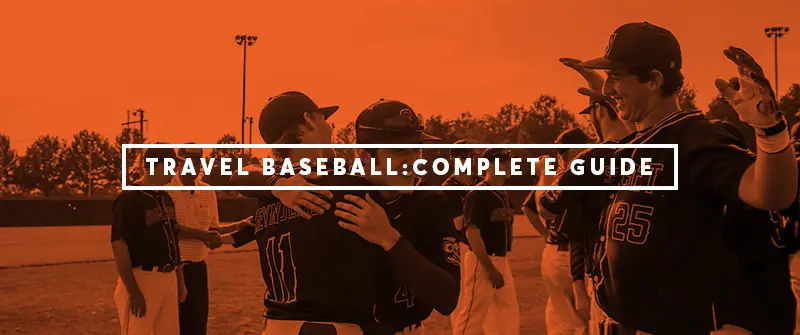
Table of Contents
What is travel baseball, what to look for in a travel baseball team, travel baseball vs. little league, travel baseball pros and cons , criticisms and controversy, is travel baseball worth it.
For many families, the transition from Little League to travel baseball comes with stress, anxiety and questions about what to look for in a team and what to expect from the experience — not to mention the question of whether making the switch from a more laid-back rec ball program to a more competitive (and expensive) travel club is the right decision in the first place.
In this post, we’re going to go over everything you need to know about getting started with youth travel baseball. We’ll help you answer the questions above and determine whether travel baseball is a good fit for your son or daughter.
If you have a softball player in the family, you may also want to check out our article “ What to Look For in a Travel Softball Team ,” which covers some of the same information from a softball perspective and dives deep into my personal experience as an elite-level amateur player and college recruiting prospect.
Table of Contents :
- How to Choose a Travel Baseball Team
- Travel Baseball Pros and Cons
- Is Travel Baseball Worth It?
First, it’s important to understand what a travel baseball team is and how travel baseball is organized.
There are tens of thousands of travel baseball teams around the country, and their popularity has exploded over the past two decades. As recently as the 1990s, travel baseball was a niche experience limited mostly to elite players in baseball-rich areas like Texas and California. Today, participation is seen by many as a near necessity for talented players to develop their skills and hone their game against the best competition they can find.
Whereas Little League is the dominant organization when it comes to recreational youth baseball, there are multiple organizations throughout the country that host hundreds of travel tournaments each year. Some of the biggest and most popular are USSSA (United States Speciality Sports Association), AAU (Amateur Athletic Union), Triple Crown Sports , and Perfect Game . Travel baseball teams often participate in tournaments organized by more than one of those organizations.
A team can be started by anyone. Many are formed by parents, but many others are formed by high school and former college coaches. Depending on their organizational goals, some programs have just one team that participates in one age bracket (such as 10 and under), while some are run like businesses and have teams that compete in every age group.
Some huge organizations, such as California Baseball Academy (CBA), even have multiple teams within the same age group, located in multiple cities. CBA has teams not only in California, but also in Nevada, Texas, Utah and the southeast. High-level programs like that are often known for attracting top talent, for training recruits into elite players, and for feeding those players into nearby colleges and universities.
Travel Baseball Competition Structure
Virtually all travel baseball games are played on weekends in a tournament format. Those tournaments can theoretically be held anywhere, but are frequently held at multi-field facilities in easily-accessible travel hubs. For example, many Florida tournaments are held in Orlando because it’s in the relative center of the state, it has plenty of hotel rooms, and it’s home to many great baseball facilities. The farther you live away from such a hub, the more you should expect to travel.
Most tournaments begin with pool play, meaning that teams are guaranteed a number of games before heading into single elimination. A team can expect to play anywhere from three to eight games over the course of a two-day or three-day tournament, depending on how they perform.
There is no set number of tournaments a team must participate in. Each team decides which tournaments to enter on a case-by-case basis, taking into consideration factors such as age level, skill level, and cost. In general, two tournaments per month can be seen as about average, although higher-level teams may play more frequently.
Most organizations run regional and national championships, which are invite-only. For example, USSSA hosts “qualifier” tournaments, where the winner of the championship game (and sometimes the runner up) can earn a bid to the USSSA national tournament.
Additionally, beginning at age 14, some teams start participating in “college exposure tournaments,” where college scouts come from across the country to watch and evaluate prospects. These tournaments are typically more expensive than regular tournaments, and are often farther away.
How to Join a Travel Baseball Team
If you’ve decided to join a travel baseball team and aren’t sure where to find one, there are a number of resources available.
It may go without saying, but word-of-mouth can be a valuable first reference point. If you’re thinking about switching to travel baseball, chances are that you already know someone in your area who has made the jump. If so, don’t be afraid to ask them questions about the team and their experience. It’s a big commitment — both in terms of time and finances — so it’s important to make sure you find the right club for your son or daughter.
In addition to word of mouth, many organizations offer a list of active teams on their website. For example, USSSA has a tool that lets you filter teams by age level, skill level, and location . There are also many state-based forums and Facebook groups where coaches post their team’s tryouts (and positions needed). As an example, here are Facebook groups for travel baseball teams in Florida and Michigan — you can find similar groups for every state.
Another good option is FieldLevel.com , which (like the USSSA site) allows you to filter teams by state and level. While not every team is listed on that website, it does include over 4,000 clubs.
Here are eight things to think about when evaluating teams. These factors will make a big difference when it comes to your overall experience, so take the time to think about them, and don’t be afraid to ask questions of parents and coaches.
1. Coaching
A coaching staff can make or break a team. How coaches manage players, keep the game fun, instill the fundamentals, and focus on development — not only as athletes, but as young men and women — is extremely important.
Some travel baseball teams have parents or grandparents serving as the head coach. While that can be fine, it’s important to make sure those coaches don’t make keeping their own child on the field a priority. Before committing to a team, spend some time researching it by watching a practice and talking to current and/or former players and parents.
What’s the coaching style? Do they have high expectations but still encourage and love their players? Or, on the other hand, are they screaming at players when they make a mistake?
Additionally, are players treated equitably, or do some get preferential treatment based on their relationship to the coach or their financial contribution to the team?
Ideally, your child will be a part of that team and organization for consecutive years, rather than bouncing from team to team. As such, determining whether the coaching staff is a good fit is a crucial first step.
2. Cost
For many parents, this is the most terrifying aspect of travel baseball.
Just how much of a toll is this going to take on your bank account? The specific answer varies, but the typical range of cost for participating in travel baseball is between $500 and $2,500 per year.
That said, you can end up spending a lot more than that. Back in 2011, CBS News reported that one Georgia family paid $4,000 per year for their 9-year-old son’s travel team. You can imagine that older players in elite programs that travel all over the country can spend even more over the course of a season.
Typically, the more intensely focused a program is on developing its players for college baseball, the more money the program is going to cost. On the other hand, teams that are playing more for the fun of it — those looking for just a little more structure and competition than offered by Little League — won’t put as much of a dent in your wallet.
There are a number of specific factors that go into how much it costs to be on a team:
- Where you live . If you live in a baseball hub, like Texas or California, you won’t have to travel as far to get to tournaments. Many teams from rural areas regularly drive across multiple states (or sometimes even fly) to tournaments. As such, where you live will likely be the single biggest variable in your overall travel baseball cost.
- Whether you have to buy your own equipment . Some teams are sponsored by equipment companies like Easton and Rawlings and have their bats, gloves and cleats provided either for free or at a reduced cost. Obviously, this can be a huge savings. Also, keep in mind that (unfortunately) equipment is often viewed as a status symbol in travel baseball. If your child joins a team where every other player has multiple bats and position-specific gloves, he or she is going to press you for similar gear.
- Whether you have to rent facilities . Some teams practice exclusively at public fields. Others have little or no access to such facilities and have to rent fields and/or indoor space (especially for winter workouts). This can have a huge impact on the overall cost of participation.
- Whether or not coaches are paid . Some teams — typically the more competitive ones — pay their coaches small stipends and/or cover their cost of travel. On one hand, this tends to lead to better coaching. On the other hand, families are the ones who will ultimately foot that bill.
- How competitive the team is . Higher-level tournaments typically have higher fees. Lower-level tournaments, operated on a more sub-regional basis, are usually much less expensive to enter. If cost is a concern, make sure you know what types of tournaments the team usually enters over the course of the season.
3. Location
As stated earlier, location is a key factor in deciding which travel team to play for. If you’re fortunate enough to live in California, Florida or Texas, you’re going to have a lot of opportunities to play with and against high-level competition right in your backyard.
But outside of those states, it’s a little bit tougher, and you have to decide how committed you are to playing at the highest possible level.
For example, if you live in a medium-sized town outside of a major baseball hub, chances are you have at least a couple of travel ball options. However, the odds are that those options are not the absolute cream of the crop when it comes to coaching and competitiveness. In order to play for the absolute “best” team possible, you might have to commute from your mid-sized town to the nearest major city.
So you’ll be faced with the following choice: play on a lower level team that’s closer to home, or drive a hundred miles or more for twice-weekly practices? It may sound crazy, but many families do just that.
Why would they commit so much time and money to their son or daughter’s athletic pursuits? It comes down to goals. Better teams often provide better coaching and more opportunities for exposure to college and professional scouts.
What’s the team’s mission? Is the focus on fun, player development, college exposure, or a mix of all there? Teams can have many different goals and missions, and there’s no right or wrong approach.
However, it is possible that a team’s mission does not align with your values and goals, and you need to think about this before committing, as a compatibility mismatch can lead to coach-parent and coach-player tension.
5. Organization
Consider the reputation of the organization you’re evaluating. When you join a team, you and your son or daughter will essentially be endorsing everything the program stands for. If they’re known for dirty play or being disrespectful to the game, you’ll be associated with that.
And believe it or not, the baseball world is a small and surprisingly tight-knit community. College coaches tend to know which programs produce bad apples — and they avoid them. In fact, many college coaches will completely write off an entire organization that has a reputation for not playing the game the right way or for having disrespectful players.
6. Playing Time
There’s an important balance between getting enough playing time and being challenged. Before committing, ask the coaching staff what kind of playing time your child can expect — including at what position.
If there are two returning shortstops, he or she most likely won’t be playing there and might have to learn another position. That’s not a bad thing: college coaches want players that are versatile, and many players change positions as they get older and their bodies develop.
Still, it’s helpful to know what to expect ahead of time. Getting game reps is important from a development perspective, but also just from a fun perspective: no kid wants to consistently travel to a tournament only to sit on the bench for most of the weekend.
7. Skill Level
Be realistic about your child’s skill level, and pay attention to the level of competition around him or her at tryouts (i.e., the skill levels of the other players). If your kid has the fight and desire to compete for a spot (like they’ll have to do if they make it to college ball), then putting them on a team where they’ll be challenged is the best option.
But if he or she is there to have fun and make friends, with no burning desire to be constantly improving, then choosing a travel team that’s more low-key will be the better call.
8. What You’re Giving Up
Travel baseball tournaments are on weekends, and players often have to sacrifice certain things that are part of a normal childhood.
Is your son or daughter willing to miss out on things like birthdays, sleepovers and school dances, because most of their time is spent doing homework, traveling to and from games and practices, practicing on their own (possibly including private lessons), and spending nearly every summer weekend at the ballpark?
And are they willing to sacrifice the material things that matter to kids — things like clothes, video games, new smartphones, etc. — because so much money is being spent on baseball?
As I wrote in THV’s guide to travel softball , my family made major sacrifices to support my athletic pursuits.
For some, their love of the game is so great that giving up these things is a no-brainer. For others, they may regret missing out on these social activities. And that’s perfectly fine! Just be honest with each other and talk about the true costs of travel baseball — because it’s not just the sticker price.
There are some important similarities and differences between competitive travel baseball and recreational baseball. Both can teach many valuable life skills, such as work ethic, good sportsmanship, teamwork and bouncing back from failure. But they are very different when it comes to time commitment and competitiveness.
The Little League schedule usually runs from the late spring through early summer, with teams practicing twice per week and playing two games per week. The total number of games per season varies, but it usually ranges from 10 to 20. It’s a local program, which means travel is either limited or non-existent. In general, Little League coaches are parents.
Little League can be a great place for kids as young as 4-years-old to start playing the game. They’ll learn the rules and the absolute basics of hitting, pitching and fielding in a fun an easy-going environment (except for the occasional parent that takes their coaching position overboard).
Overall, Little League fits the classic stereotype of youth baseball: kids having fun playing the greatest game in the world, without much pressure or focus on player development.
Back in the day, Little League would feed into middle school and high school programs, which carried the bulk of the weight when it came to getting payers ready for college and the pros. But today, the reality is that it’s almost impossible to get the coaching and skill development you need by participating only Little league or other rec ball programs.
That’s especially true when it comes to the gap between “Majors” Little League (12-and-under) and high school. Few middle schools still have baseball programs, and those programs that do exist tend not to be very good. Likewise, while Little League offers both a Junior division (12-14) and a Senior division (14-16), those leagues tend to pale in comparison to the coaching and competition offered by travel ball.
So, if your son or daughter is serious about playing baseball at a high level, it’s especially important to focus on the transition to travel ball at around the age of 11 or 12.
There are positives and negatives when it comes to travel baseball. Here are a few of each.
- Better competition : Players are more serious about the game and more driven to improve. This higher level of competition will help push your son or daughter to improve their own skills.
- Better coaching : Travel baseball coaches tend to be better qualified, more knowledgeable, and better-connected. At the highest levels of travel ball, teams often employ former professional coaches.
- More exposure : Aside from high school baseball, travel ball is the primary means of exposure to college coaches and pro scouts. Plus, travel teams often attend showcase tournaments and camps.
- More games played : Travel teams play significantly more games per year than rec ball teams.
- Facilitates travel : Sometimes seen as an ancillary benefit, the travel itself can be a valuable and eye-opening experience for players. Many kids don’t have an opportunity to travel out of their own area or state, and travel baseball can provide that.
- Encourages character development : Because travel teams are more serious, there’s a greater emphasis put on things like being on time, demonstrating maximum effort, and having a good attitude.
- Cost : Travel baseball is expensive — sometimes absurdly so. Families often spend around $2,500 per year, but the costs can be even higher.
- Time commitment : Even a moderately competitive travel team can consume an entire summer’s worth of weekends.
- Ultra-competitive : On most travel teams, there’s a balance between player development and winning. What you won’t often find is an “everybody plays” approach. For the most part, the best players will play the most, which makes for a highly-competitive environment.
- Tougher workouts : This can be a pro or a con, depending on the player’s perspective and goals. Tougher workouts can lead to better outcomes, but they can also be mentally and physically taxing if the player isn’t fully invested.
- Lack of diversity : Because travel baseball is expensive, it has often been criticized for a lack of socioeconomic and racial diversity.
Travel baseball provides many benefits and can be a valuable opportunity for players who are serious about the game and committed to playing at the highest possible level. However, it’s not without its share of criticism and controversy.
In an essay titled “ Left Out ,” MLB superstar Andrew McCutchen wrote about how kids like him, who grow up in low-income families, are often excluded from travel baseball and thus systematically disadvantaged when it comes to development and exposure:
“When you’re a kid from a low-income family who has talent, how do you get recognized? Now, you have to pay thousands of dollars for the chance to be noticed in showcase tournaments in big cities. My parents loved me, but they had to work hard to put food on the table, and there wasn’t much left over. They didn’t have the option of skipping a shift to take me to a tournament over the weekend. […] That’s the challenge for families today. It’s not about the $100 bat. It’s about the $100-a-night motel room and the $30 gas money and the $300 tournament fee.
[…] If you’re a poor kid with raw ability, it’s not enough.”
McCutchen was lucky: an AAU coach “discovered” him at the age of 13 and covered his travel ball expenses. But most kids from similar situations aren’t so fortunate.
Why is this important for you, the parent of a child thinking about joining a travel team?
On one hand, it’s important to be aware of how the systems we participate in affect our society. But on a much more specific level, you should know that your child will be entering a largely homogenous environment.
On top of that, kids from lower-income families can often feel out of place in travel ball — especially if they don’t come to the ballpark with the latest, top-quality gear like their teammates. This social dynamic can have a powerful impact on your child’s experience.
Additionally, travel baseball means that both your family and your child will be spending less time within your own community.
There’s been a lot written in recent years about how travel baseball may be contributing to the erosion of communities , because it pulls families out of local baseball programs that once served as important civic institutions.
This is evidenced by the sharply declining participation in Little League. In the organization’s Southeast Region (a hotbed for a travel baseball), the number of Little League players has plunged by nearly 50% since 2007 .
So we’ve come to the biggest question: Is travel ball worth it?
If you want to improve your skills and have the best chance to play in college or the pros, travel baseball is the way to go. But remember: there is a range of cost and time commitment within travel baseball. Your son or daughter doesn’t necessarily have to opt for the most expensive travel team in order to be sufficiently challenged (and later on, to get noticed by college coaches).
Your goal in evaluating teams should be to find the right balance of:
- Financial commitment
- Time commitment
- Intangible sacrifices (school events, community involvement, etc.)
- Baseball goals
After reading this article, you should have a very solid understanding of what Little League and travel baseball have in common, their differences, and what you should be looking for in a club.
Remember, this is your child’s choice to. Help them see the pros and cons of each option. And although we stated it earlier, we cannot stress this enough: you cannot dictate your son or daughter’s commitment to the game of baseball. It’s up to them. So, support them in whatever capacity they want to participate. If you do, they’ll never regret or forget the amazing experiences, friends, and lessons learned playing this great game.
The Hitting Vault is the most popular, most trusted and highest rated online hitting community.

Alexa Peterson

Join 93,000 Subscribers Who Love Hitting.
Get two articles delivered to your inbox each week.

Travel Baseball Uncovered: A Guide For Parents And Players
Let’s talk about baseball—travel baseball, to be exact.
For many, moving from the Little League to travel baseball feels like catching a curveball. After all, it’s more than just a pace change; it’s about trading Saturday afternoon matches on a grassy field for serious club competitions that come with a higher price tag.
You might be thinking, “Is this the right play for my little slugger?” or “How do I even go about choosing a team?”
Well, here’s our chance at bat. We’ll walk you through everything youth travel baseball has to offer, including answering these questions and more.
Table of Contents
What is Travel Baseball [Explained]
Travel baseball is just what it sounds like. It’s when youth teams have to travel in order to have their games and tournaments. This is usually the next step after traditional recreational or Little League.
Since the level of competition is much higher, it can help them develop their skills.
But preparation comes at a cost—literally. And all that time on the road can take up your schedule very quickly. But despite all that extra work, they’ll get an exciting adventure out of it. Now, they’ll face off against teams from different cities, states, and sometimes even countries.
The love for Travel Baseball is Growing Fast.
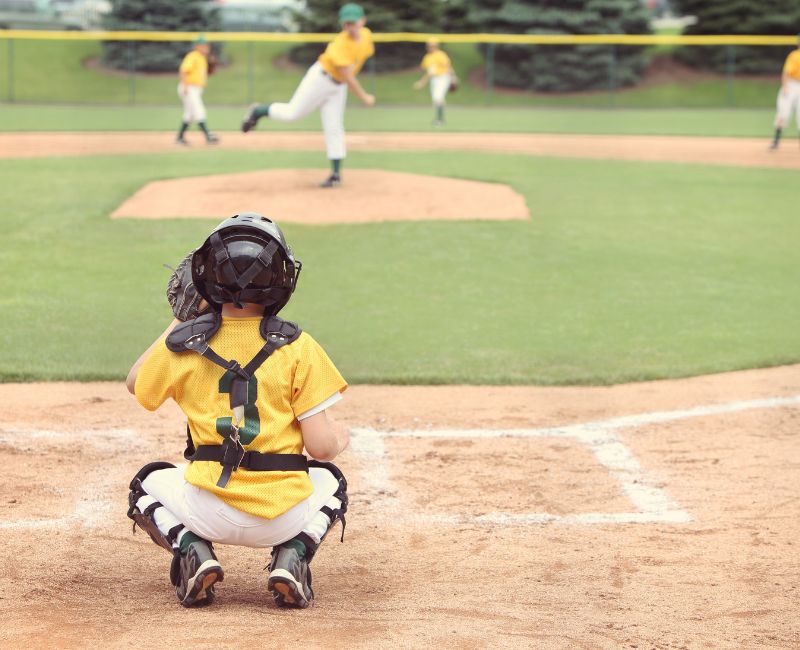
In recent years, travel baseball gained an exponential amount of popularity and saw thousands of teams pop up across the country.
Before the 90s, it was a relatively niche experience only limited to players nestled in regions like Texas and California.
Nowadays, participation is considered necessary for young players wanting to sharpen their skills and go up against some really tough competition.
Instead of focusing on the local leagues like recreational youth baseball does, travel ball operates under various organizations, hosting hundreds of tournaments each year.
Some big names include USSSA (United States Specialty Sports Association), AAU (Amateur Athletic Union), Triple Crown Sports , and Perfect Game .
The ambitious goal for any team is to face off against as many different teams as possible to gain experience and test their skills.
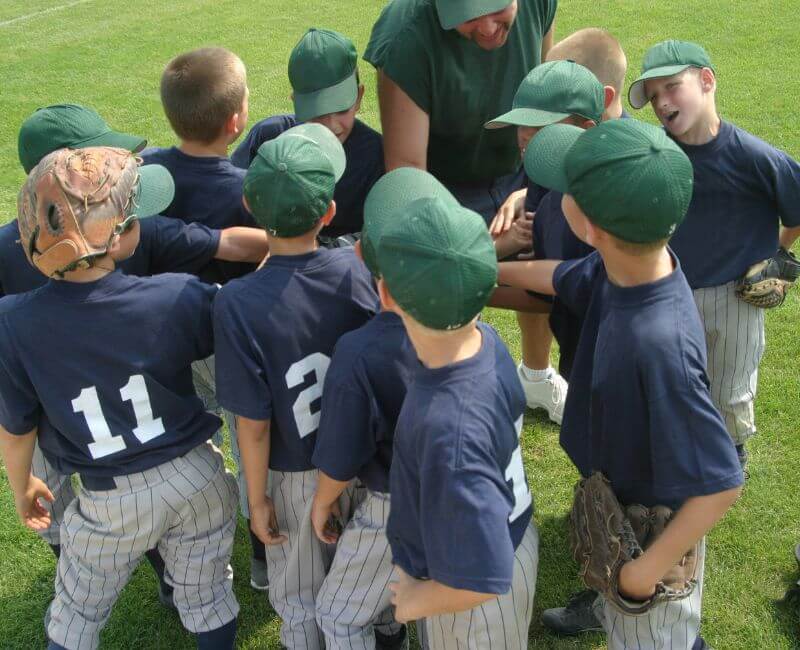
Everyone can create a travel baseball team. It doesn’t matter if you’re a parent, high school teacher, or someone who coaches college kids.
The highlight of the season is the travel baseball tournament. Bringing together talented teams from different parts of the world to compete.
This lets players show their skills to a bigger audience, including scouts and college coaches. These tournaments are organized by many institutions and happen locally, regionally, or even nationally.
There’s nothing cooler than the USSSA World Series, though. Every year, it’s hosted by the United States Specialty Sports Association.
You’ll find talent from all over America coming here to fight for that top spot. But another epic tournament is the Triple Crown Summer Nationals, where they hold it at Myrtle Beach
in South Carolina. It attracts teams from everywhere and is known for great competition and vacation vibes.
A unique little competition is held in Cooperstown, New York, known as the Cooperstown Dreams Park Tournament.
Cooperstown, known as baseball’s birthplace, offers a unique week-long stay in baseball-style barracks. You can visit the National Baseball Hall of Fame.
These intense and challenging tournaments bring out some of the most talented players young kids have to offer. It’s also a great way to boost your young player’s confidence in playing on those big stages!
Different Levels Of Travel Teams And Their Requirements
It’s not just one level fit all for travel baseball teams. They’re organized into various levels based on skill, experience, and commitment from players.
Imagine putting someone who only knows how to throw with moderate force into a contest against someone who does it with full force.
The team you choose for yourself should align with your skill level, how much free time you have, and your developmental needs as a player. Here’s an overview of different levels:
1. Local Travel Teams : For beginners starting their journey through travel baseball. The games they play are mostly local or within a close driving distance. Practices only happen a few times a week, and games during the weekend.
2. Regional Travel Teams : For players with more experience and higher skill levels. They go on trips for games and tournaments that will require overnight stays at places. Commitment level is higher, with practices being more frequent along with a longer season.
3. Showcase Travel Teams : The big leagues of young kid baseball players. These teams are made up of highly skilled people who are very serious about baseball. They have college scouts and recruiters present their games. This includes going to different states for showcase tournaments.
You’ll need to be extremely committed to even think about trying out for this team, and their practices are rigorous and frequent, lasting all year round!
Benefits of Playing in a Travel Baseball Team
A lot of benefits come from playing travel baseball.
The biggest one? It can help players get to their goals. It’s not just about playing a game, especially when you want to make it big. It’s actually an experience that provides lifelong skills that can be applied everywhere else.
Competition in recreational leagues is nothing compared to this. It’s way higher. This allows players to grow new and old skills at a faster rate.
There’s also an intense training schedule that demands discipline, resilience, and focus. These qualities go beyond just sports.
Participating in high-profile tournaments also gets the attention of other coaches and scouts. Which makes it easier for them to open doors for scholarships and professional contracts.
Traveling away from home just for games might seem like a drag, but it builds responsibility and maturity. It is a demanding journey for sure, but very rewarding.

Did MLB Players Play Travel Baseball?
Definitely! A lot of Major League Baseball (MLB) players used travel baseball as their starting point, too. It gives them all the exposure they need, honing skills at such a young age along with fierce competition.
Take Bryce Harper , for example. He’s one of the biggest names in MLB today. His journey started back when he was a child playing for the Southern Nevada Bulldogs 14U travel team. The opportunity came up where he could go against older players who were more experienced than him. This experience helped shape his professional career.
Albert Pujols also played travel baseball when he was younger on his team called Fort Osage Indians Travel Team before sailing into the Hall of Fame.
Clayton Kershaw ? Yeah, him too! Another name you hear often in MLB didn’t start there either — he played for the Dallas Tigers Travel Team where he developed early on gaining crucial skills and discipline that are instrumental in his success today.
How to Find a Travel Baseball Team in Your Region?
If you’re a young baseball player who wants to take their skills to the next level, then joining a travel team is a great opportunity. If you are a parent and want to make your child the next MLB star, then travel baseball teams are a great place to start with.
These teams play across the country and allow players to show their talents against top-tier competition. But how do you find one of these teams?
Here’s a guide on how you can join a travel baseball team in the USA.
Check your local youth baseball organization.
Your first step should be checking with your local youth baseball organization. Chances are they have travel teams that play in leagues and tournaments outside of the regular season. If they don’t, then it’s likely they know someone who does.
Drop by showcases and camps.
In-person events like showcases and camps are great places to meet coaches and scouts from travel baseball teams. They’re designed specifically so players can showcase their skills and get noticed by recruiters.
The internet holds many answers, including finding a travel baseball team. Websites like USSSA Baseball, Perfect Game USA, and Travel Ball Select list lots of travel baseball teams based on state, age group, and skill level — all at a click away.
Talk to other parents and players.
If you want first-hand experience, then talk to other parents or players who have been through this process before. They can give useful insight into which teams are reputable, well-run, and competitive.
For example, if you live in Texas, then one option could be the Texas Bombers Baseball Club — an organization that has multiple teams at different age levels and is known for developing young talent. You can learn more about them by visiting their website or attending one of their tryouts.
How to Find the Perfect Travel Baseball Team?
Identify the skill level and commitment of the player.
First thing first, you need to figure out how committed your child is to the sport and their skill level. If he is naturally gifted athlete then you should help him to follow his dream.
Research Local and Regional Teams
Begin by looking at teams that are close by. These teams usually have varying levels of skill and serve as great entry points for most players.
You can check their websites and social media pages to learn more about them such as philosophy, coaches, players, and game schedule.
Attend Local Games and Practices
Sitting in on local games and practices allows you to get a firsthand look at how they run things. You’ll be able to see their coaching style, how they interact with the players, and the overall team dynamic. With this insight, it’ll be easier to make a decision.
Speak with Coaches and Parents
While observing is good, it isn’t enough. Take some time out of your day or week to speak with coaches.
This allows you to gain an understanding of their training methods, the expectations they have for your child, and the goals they want them to reach. It’s also good practice to talk to other parents so you can get a general idea of what people think about the team.
Consider Logistics
Logistical factors are important, too, so don’t forget about them. Make sure that the team’s practice location is suitable for you and your family’s schedule since it may be far away from where you currently live or work.
The game schedule should be looked at as well because there could be conflicts in dates that would keep you from attending games.
Tryouts & Evaluations
Most teams hold tryouts or evaluations for people who are interested in joining. If this is offered, take advantage of it because it gives your child the chance to showcase their skills and for you to see if the team would be a good fit.
A player’s evaluation is also helpful because it gives you insight into how strong the team itself is.
Travel Baseball Season Preparations
Preparations before the pre-season.
Before the baseball season starts, you’ll want to make sure that your child is mentally and physically ready for the long days ahead.
So, let’s start with an off-season workout routine to help build strength and agility. But don’t forget about eating well and getting enough sleep. Plus, practicing regularly can take their fielding, pitching, and hitting skills way up.
During the season
Once the season starts, it’s important to stay fit and perform at your best. You’ll want to communicate with their coach to keep track of your child’s progress as well as any areas they need improvement in.
Another thing you should do is show up to their games and practices. It helps you stay in tune with how the team is performing and also supports your child. And finally, always keep their lines of communication open, whether it’s about pressure or their anxiety.
Post-Season
After a long season, it’s important to take a break. Reflect on the games you had together. Acknowledge all the good things they did but also focus on areas they can improve in.
Give them some downtime so they can rest and recover. Even though they’re chilling around, don’t let them become bums — physical activity is still important for them during this time.
Travel Baseball vs. Little League
Both types of baseball have their own unique experience and benefits that come along with it. The choice of which one to put your kid into mostly depends on what they want out of it.
For example, travel baseball is more competitive. It attracts players who are committed to sports no matter what and are willing to travel around just for a game against top talent in various regions. Not only does this provide intense competition but also high-level coaching.

It does require a lot of time, as seasons are much longer than in little leagues with more games and practices.
If you want your child exposed more, then this would be a good option, as you can see from Bryce Harper, Albert Pujols, and Clayton Kershaw.
Now, little league baseball is less demanding. It’s generally more focused on the community and not so much on traveling and time.
It’s actually a great option for kids who still love the sport but aren’t ready to commit to such a demanding schedule. They focus on learning fundamental skills, enjoying the game, and fostering a sense of community.
You can learn more here: Travel Baseball Vs Little League
The Cost of Playing Travel Baseball
If your kid has a future in baseball, you might want to consider enrolling them in travel baseball. The only problem is that this option is much more expensive than local leagues.
Local leagues tend to have low costs because they don’t do as much traveling as travel teams have to do. On top of paying for the actual games themselves, there’s also the top-of-the-line coaching and amazing facilities that the team needs to cover.
You’ll be hit with fees like equipment, uniform, tournament, travel (like gas and airfare), and a team fee.
The team fee alone can include things like league fees, practice facility rentals, and salaries for the coaches.
And let’s not forget about any extra training or lessons they need in order to take their skills up a notch.
It’s always good to ask the people organizing the league what you’re paying for specifically because then maybe it won’t seem so bad (it probably will still seem bad, though).
But it really does come down to where you live.
Depending on that, it could cost you anywhere from $1,500-$3,000 per season. And if you’re on one of those elite teams competing at national tournaments, then I’m sorry, but it’ll probably cost way more.
Find Out How To Choose A Coach
A good coach doesn’t just teach how to play sports but also builds discipline and confidence, along with fostering a love for the game. Here are some tips on picking a coach:
Experience And Certification : A coach should always have some kind of experience coaching youth sports, but having proof that they passed some coaching program can give you peace of mind, knowing they know what they’re doing.
Coaching Style : Every coach is different and will treat their athletes differently, too. Some will be very intense in trying to push their players, while others are more relaxed yet inspiring. Pick what works best with your child’s personality.
Communication Skills : A good coach knows how to explain things in a way that’s easy for their athletes to understand. They should also be great at talking to you and other parents.
Focus On Development : It’s better for your kid to improve their skills rather than just win all the time. Look for coaches that will work with them on that.
Reputation : Finally, look into what other people say about the coach. Not only other players but parents, too. It doesn’t hurt to ask around or even watch them during practice if you can.
Things to Know About Uniforms and Equipment in Travel Baseball
Uniforms and equipment are a necessary investment in travel baseball. It can be beyond what you expect from Little League. Here’s a quick rundown of what your child might need:
Uniforms : Most travel baseball teams have their own custom jerseys that come with pants, caps, belts, and socks. Some teams may even have home and away uniforms, so check with the manager first.
Gloves/Mitts : Get your child a good quality glove or mitt that suits the position they play. For example, catchers and first basemen have their own special mitts, while outfielders use bigger gloves compared to infielders. Check out the Best Youth Infield Gloves
Bats : Bat rules can get very specific, depending on the league. Before you buy one, make sure you understand what kind is allowed. Also, consider their height, weight, and hitting strength when selecting the right bat size .
You can check out my list of Best Youth Baseball Bats
Helmets : No matter how old or young your child is, they need a batting helmet. Some leagues even require faceguards as well. Check out the Best Youth Baseball Helmet
Cleats : Running on grass and dirt requires traction, which is why cleats are used in baseball. However, be aware that some leagues don’t allow metal spikes, so again, you should always check if there are any shoe restrictions.
Protective gear : Depending on the position they’re playing at, your kid may need extra protection such as shin guards for their legs or a chest protector for their torso
What is a good age range for travel baseball?
Travel baseball typically starts around 7 or 8 years old and goes through high school. However, the age that you can join may differ depending on the league or team.
How much does it cost to play travel baseball?
The price of playing travel baseball could be greatly different depending on things like where you live, what team you’re on, and at what level you play. You’ll have to pay for league fees, uniforms, equipment, and even the costs of traveling and staying in other cities for away games.
How often would we need to practice?
Usually, travel teams practice more often than recreational ones. It’s common for them to meet several times each week. But it will depend on the time and dedication your child’s coach expects.
How far do they have to go?
Again, that’ll depend on what league your child signs up for. Some teams only need to go a couple of miles, while others will have to cross city lines.
Can my child also play another sport?
It all depends on how much time both sports require. Understandably, travel baseball takes up quite a bit of time and energy, so consider if they have enough for both.
Overall Worth of Travel Baseball
Traveling with a baseball team is no joke. For players and families alike, it’s considered a big commitment that takes up lots of time, money, and energy.
And while it opens up new opportunities, the best reward for joining one is amazing! The skills learned, and knowledge gained from playing at higher levels is priceless.
Plus, it builds character, helping to teach important lessons like teamwork, dedication, success handling, and, most importantly, failure handling. And let’s not forget about the friendships built along the way from spending hours with teammates in different places across the country.
Even though some costs and sacrifices come with this commitment, most families say joining a traveling baseball team was totally worth every bit of it.
Just remember, the end goal is to love the sport and grow as a person.

Hello everyone. My name is Jason Butler, and I live in California, America. I was a professional AAA Minor League Baseball player. I lost my chance of playing MLB for injury issues, but I did not lose my love for baseball. I attended the coaching training program and am now working as a coach in a small school in San Diego.
I always love to share my experience and knowledge if that can help you. Play baseball, and stay fit.

Travel Baseball: The Ultimate Resource for Parents, Coaches, and Players
- Uncategorized

Step up to the plate and join the world of travel baseball—a high-stakes, competitive journey where players, parents, and coaches all swing for the fences in pursuit of their baseball dreams.
Travel baseball is a highly competitive form of youth baseball that involves teams traveling to different locations to compete in tournaments against other skilled players. It is a level above school baseball, allowing talented players to showcase their skills and potentially catch the attention of college recruiters or professional coaches. Travel baseball teams are typically organized by age level, providing opportunities for players from middle school through high school to participate. Being part of a travel baseball team requires a significant time commitment, both in terms of practice (if your team has it) and attending games and tournaments. It offers players the chance to improve their skills, gain valuable playing time, and experience the thrill of competing against other top-notch teams. Travel baseball also often includes showcase tournaments, where players can demonstrate their abilities to scouts and coaches. Overall, travel baseball provides young athletes with a platform to develop their skills, gain exposure, and potentially earn college scholarships or pursue a career in baseball.
Table of contents
Key takeaways, travel baseball competition structure, how to join a travel baseball team, assembling teams versus developing teams, parent/team dynamics and politics, organization, playing time, skill level, focus on advancement to next level, what you’re giving up, travel baseball vs. rec baseball (little league, cal ripken), travel baseball vs school baseball (middle school, high school), youth travel baseball vs showcase travel baseball, perfect game, baseball youth, criticisms and controversy, is travel baseball worth it.
- Travel baseball is a competitive and intense environment that allows young athletes to continuously improve their skills and compete against talented players. It offers opportunities for skill development, personal growth, and the potential for college scholarships and professional opportunities.
- The frequency of practices and games varies among travel baseball teams, with regular practices during the week and games on weekends. Some teams also participate in showcase tournaments and events, which may require additional time commitments.
- Travel baseball teams cater to a range of age levels, starting from around 8u and going up to the high school level. Each age level has different skill development goals and competition levels.
Many travel baseball teams have professional coaches or coaches with extensive experience in the sport. These coaches provide specialized training, guidance, and mentorship to help players reach their full potential.
- Participating in travel baseball requires financial and time investments, with costs including tournament fees, equipment, and travel expenses. While it can be expensive, the potential benefits and opportunities make it worthwhile for dedicated parents and athletes.
As a dedicated travel baseball parent or coach , it’s important to understand the structure of travel baseball tournaments to support your child’s journey and maximize their opportunities. Travel baseball competitions typically involve tournaments that bring together teams from various regions to compete against one another.
The format of these tournaments often includes pool play followed by single elimination rounds. In pool play, teams are grouped into pools and play multiple games against the other teams in their pool. The purpose of pool play is to determine seeding for the single elimination rounds.
Once pool play is completed, teams advance to the single elimination rounds, where the games become more intense and every game matters. Teams compete against each other in a knockout tournament format, with the winner moving on to the next round and the loser being eliminated from the tournament.
Regional and national championships are often the pinnacle of travel baseball competitions. Regional championships bring together top teams from a specific region to compete for a chance to advance to the national championships. National championships showcase the best travel baseball teams from across the country, where teams compete for the title of national champions.
To simplify the tournament process and ensure fair competition, travel baseball tournaments often utilize the DivLevel classification system. This system categorizes teams based on their skill level, ensuring that teams are matched up against opponents of similar abilities. This not only creates a more level playing field but also provides an opportunity for teams to compete against similarly skilled teams and further develop their skills.
Understanding the structure of travel baseball competitions, from the format of tournaments to the DivLevel classification system, allows parents and coaches to navigate the journey with their young athletes and make the most of the opportunities presented by these competitions.
Ready to join a travel team? Let’s break it down into simple steps so you can confidently navigate this process.
Begin your search by reaching out to other parents, coaches, and even your child’s school baseball team. Word-of-mouth is a great way to discover travel baseball teams in your area. Additionally, check out organization websites, forums, and Facebook groups for team listings and tryout information.
Once you’ve identified potential teams, attending their tryouts is crucial. This gives coaches an opportunity to assess your child’s skill level and determine if they are a good fit for the team. Please encourage your child to give their best effort and showcase their abilities during tryouts.
Don’t be afraid to ask questions at tryouts. It’s often a good idea to ask the same questions at each tryout so you can have notes for comparison for step 4.
When evaluating different travel baseball teams, consider factors like cost, coaching quality, competitiveness, playing time, skill development programs, and exposure opportunities. Each family may prioritize these factors differently, so find the team that aligns best with your goals and values.
After attending tryouts and considering the various factors, take some time to evaluate your options. Please consult with your child and consider their feelings and goals. Once you’ve gathered all the necessary information, make a decision that feels right for your family.
Remember, joining a travel baseball team is an exciting opportunity for your child’s growth and development. By following these steps, you’ll be well on your way to finding the perfect team that will nurture your child’s talent and provide them with unforgettable experiences. Good luck on this incredible journey!
What to Look For in a Travel Baseball Team
When it comes to choosing the right travel baseball team for your child, there are several factors to consider. As a dedicated parent, you want to ensure that your child receives the best training, exposure, and opportunities in baseball. But with so many options out there, it can be overwhelming to navigate the competitive world of travel baseball. In this article, we will dive into what you should look for in a travel baseball team. From coaching quality and competitiveness to skill development programs and exposure opportunities, we’ll guide you on how to find the perfect fit for your child’s baseball journey. So let’s explore the key factors that will help your child thrive and excel in the exciting world of travel baseball.

When it comes to travel ball, there are two main approaches to forming teams: assembling teams and developing teams.
Assembling teams involves selecting players based on their current skill level and position needs, while developing teams focus on nurturing players’ skills and helping them improve over time.
Assembling teams is often seen as a way to quickly build a competitive team. Coaches select players based on their existing talent, with the aim of creating a team that can perform at a high level right away. For these teams, winning is not only the primary goal; it’s often the only goal. For some parents and players, there is a some social status they derive from being on these “elite” teams. At the same time, coaches for these teams often overlook players with untapped potential and could benefit from further development. Players are often seen as interchangeable pieces rather than growing, developing, maturing young men.
On the other hand, developing teams takes a more long-term approach. Coaches prioritize nurturing players’ skills and helping them improve over time. This approach recognizes that player development is a gradual process and focuses on providing opportunities for players to grow and learn. While developing teams may not achieve instant success, it can lead to the creation of well-rounded players who have a solid foundation of skills and a deeper understanding of the game. In the long run, these teams overtake their “assembled” counterparts, especially as the players transition to a full-sized baseball diamond.
Here’s a comparison of the benefits and drawbacks of each approach:
While each approach has its merits, it ultimately depends on the goals and priorities of the team and the individual players. Assembling teams may be beneficial in situations where immediate success and social clout are the main goals while developing teams can provide a more holistic and long-term approach to player development.
Coaching is a vital component of travel baseball teams, playing a crucial role in player development, instilling fundamental skills, and fostering a positive team environment. The coaching staff has a direct impact on the growth and success of young athletes, both on and off the field.
A great coach goes beyond just teaching the mechanics of the game. They understand the importance of nurturing talent, building confidence, and instilling a love for the sport. Their coaching style should be supportive, motivating, and individualized, allowing each player to reach their full potential.
In addition to player development, coaches also play a key role in creating a positive team environment. They set the tone for teamwork, sportsmanship, and respect. A strong team dynamic is essential for success in travel baseball, as players must learn to work together towards a common goal.
When evaluating coaches for your child’s travel baseball team, there are several key factors to consider. Look for coaches who prioritize player development, have a clear coaching style that aligns with your child’s needs, and treat all players fairly and equitably. It’s important to ensure that the coaching staff creates an inclusive and supportive atmosphere where all players feel valued and included.
Choosing the right coaching staff is essential for your child’s growth and enjoyment in travel baseball. By prioritizing player development, fostering a positive team environment, and evaluating coaches with key factors in mind, you can ensure that your child has the best possible experience on their journey in travel baseball.
Playing Experience vs Coaching Experience
When considering a travel baseball team, both playing experience and coaching experience are crucial factors to take into account.
Playing experience provides valuable insights and a deep understanding of the game. Players who have had significant playing experience have been through the ups and downs of the game, faced different opponents, and have a strong grasp of the nuances and strategies involved. This experience translates into a higher skill level, as they have developed the physical and mental abilities needed to perform at a competitive level.
On the other hand, coaching experience is equally important. Coaches with experience have the ability to provide guidance, instruction, and mentorship to players. They understand the intricacies of player development and know how to tailor their coaching approach to the individual needs of each player. Coaching experience brings a wealth of knowledge and a proven track record of success, enabling coaches to help players reach their full potential.
While playing experience is valuable, it doesn’t necessarily mean that someone can effectively teach others or coach younger players. Coaching requires a different skill set, including the ability to communicate effectively, break down complex concepts into digestible information, and adapt coaching methods to meet the players on their level.
A balance between playing experience and coaching experience within a travel baseball team is ideal. Players benefit from the guidance and instruction of experienced coaches who have a deep understanding of the game, while coaches can draw upon their playing experience to relate to and connect with the players. This balance ensures that players receive both the technical and strategic knowledge needed to excel on the field, as well as the support and mentorship necessary for their overall development as athletes and individuals.
As a dedicated travel baseball parent, it’s important to understand the dynamics and politics that exist within a travel baseball team. Being aware of these dynamics will help you navigate the team environment and ensure a positive experience for both you and your child.
Parent involvement is a crucial aspect of travel baseball, but it’s essential to find a balance. While it’s natural to want to be involved in your child’s baseball journey, it’s important to respect the roles and responsibilities of the coaches. Clear communication is key in establishing boundaries and understanding each person’s role within the team.
Team dynamics can sometimes be challenging, with different personalities and expectations coming together. However, fostering a sense of respect and teamwork is vital. Encourage your child to be a supportive teammate and lead by example yourself. Emphasize the importance of treating others with kindness and respect, both on and off the field.
Conflicts may arise within the team, but it’s important to address them promptly and effectively. Open and honest communication is crucial in resolving conflicts. Encourage your child to express their concerns and help them understand the importance of active listening and empathy. Collaborate with coaches and other parents to find solutions that benefit the team as a whole.
Creating a positive team environment requires effort from everyone involved. By fostering clear communication, respect, and teamwork, you can help create a supportive and harmonious atmosphere within the travel baseball team. Remember that your child’s experience is shaped not only by their performance on the field but also by the relationships they form and the lessons they learn from being part of a team.
When it comes to travel baseball, there are several factors that contribute to the overall cost of participation. These factors can vary depending on location, equipment requirements, facility rental, and tournament competitiveness. It’s important for parents to be aware of these factors to make informed decisions about their investment in their child’s baseball journey.
1. Location: The cost of travel baseball can vary depending on where you live. In areas where baseball is more popular, you may have access to more competitive teams and tournaments, but that can also come with a higher price tag.
2. Equipment: Baseball equipment can be expensive, and as your child progresses through different age levels, they may require more specialized gear. This can include gloves, bats, helmets, cleats, and other protective equipment.
3. Facility Rental: Travel baseball often requires the use of indoor facilities for practices and training. The cost of renting these facilities can add up, especially if you’re competing for limited space during peak seasons.
4. Coaching: Hiring experienced and knowledgeable coaches is an important investment in your child’s development as a baseball player. Coaches may charge fees for their services, and the higher their level of expertise, the more expensive their coaching fees may be.
5. Tournament Competitiveness: Participating in high-level tournaments often involves additional expenses such as travel, accommodations, and tournament fees. The more competitive the tournament, the greater the cost.
It’s essential for parents to carefully consider these factors when budgeting for their child’s participation in travel baseball. By understanding the potential costs involved, parents can make informed decisions and ensure that their child has the resources and support they need to thrive in the competitive world of travel baseball.
When it comes to choosing a travel baseball team, location plays a crucial role in determining the opportunities available to young athletes. While certain states like California, Florida, and Texas are known as major baseball hubs, providing a wealth of high-level competition in close proximity, families living outside of these states need to consider a few factors.
Firstly, commuting becomes an important consideration. It may be necessary to travel to nearby major cities or regions with better coaching and more competitive teams. This can involve a significant time commitment for both players and their families, but it can also provide access to a higher caliber of coaching and competition.
Proximity to practice fields and facilities is also essential. Travel baseball often requires the use of indoor facilities for practices and training. Living close to these facilities can make it easier to attend regular practices and take advantage of additional training opportunities.
In summary, while living in California, Florida, or Texas can offer abundant opportunities for high-level competition in baseball, families living outside of these states need to evaluate their options carefully. Commuting to major cities and ensuring proximity to practice fields and facilities are important considerations to find the best fit for their young athletes.
Mission is a powerful word. It represents the guiding purpose and direction of a travel baseball team. Understanding a team’s mission and how it aligns with individual values and goals is crucial for both parents and players.
When choosing a travel baseball team, it’s essential to ensure that its mission aligns with the players’ and their families’ aspirations and expectations. This compatibility fosters a harmonious and fulfilling experience for everyone involved. It ensures that everyone is working towards a common goal and shares the same values.
However, tensions can arise if there is a mismatch between the team’s mission and the expectations of the coach, parents, and players. These tensions can manifest as coach-parent or coach-player conflicts. Ultimately, this can impact the overall team dynamic and hinder personal and team growth.
Parents and players should have open and honest conversations with the coach to ensure that their values, goals, and expectations are in line with the team’s mission. This communication can help manage potential tensions and create a supportive and nurturing environment for players to thrive.
Choosing a travel baseball team goes beyond evaluating skill level and competitive opportunities. It requires a careful consideration of the team’s mission and how it aligns with the values and goals of the individuals involved. By doing so, parents and players can set themselves up for a successful and fulfilling journey in travel baseball.
When evaluating the organization of a travel baseball team, several key factors must be considered. One of the most important is the team’s reputation. Reputation can significantly impact your association with the program and even affect your child’s opportunities in the future.
Joining a team known for dirty play or disrespectful behavior can have serious consequences. Not only does it reflect poorly on your child and their character, but it also affects their development as a player. Playing alongside individuals who engage in dirty play or disrespectful behavior can hinder your child’s growth and create a negative environment for them to thrive.
Additionally, the travel baseball community is small and tight-knit. College coaches and scouts pay attention to reputations and will often avoid programs with a negative reputation. Being associated with a team known for dirty play or disrespectful behavior can limit your child’s exposure and opportunities for college scholarships and professional prospects.
It’s important to note that the size of an organization does not necessarily determine its success. While larger organizations may have many players who go on to play in college or the pros, it’s crucial to consider the percentage of players who achieve these outcomes. Many kids play in these organizations, so the percentage of success is relatively small.
Ultimately, when evaluating a travel baseball team’s organization, reputation should be a significant factor to consider. It can impact your child’s development, opportunities, and future prospects in the sport.
Playing time is a crucial aspect of travel baseball that can greatly impact a player’s development and enjoyment of the sport. It is important for parents to understand the importance of playing time and how it can contribute to their child’s growth as a baseball player.
Before committing to a travel baseball team, parents should have open and honest conversations with the coaching staff about the expected playing time and positions. This allows parents to gauge the team’s approach to player development and ensure that their child will have ample playing opportunities.
It is worth noting that assembled teams, which are often formed based on tryouts and selecting the most talented players, tend to lock kids into specific positions. On the other hand, developed teams often prioritize versatility and allow players to learn and play multiple positions. This flexibility not only expands a player’s skill set but also increases their value to the team.
Learning multiple positions benefits the individual player and enhances team dynamics. Versatile players can easily adapt to different game situations and provide strategic advantages for their team.
While getting game reps is important for skill development and overall enjoyment, it is equally important to recognize that practice reps are the most crucial for long-term skill development. Coaches should provide a balanced mix of game time and practice time to ensure that players have the opportunity to refine their skills and improve their performance on the field.
In conclusion, playing time in travel baseball is essential for a player’s development and enjoyment of the sport. Parents should have open communication with coaching staff about playing time expectations and positions. Additionally, encouraging players to learn multiple positions can enhance their versatility and overall value to the team. Finally, understanding the balance between game reps and practice reps is vital for long-term skill development.
As a dedicated travel baseball parent, one of the most important factors to consider when choosing a travel baseball team for your child is evaluating their skill level. It’s crucial to assess where your child stands in terms of their baseball abilities to ensure they are placed in the right environment for growth and development.
Evaluating skill level allows you to find a team that aligns with your child’s abilities and goals. Children who excel in baseball and are looking for a challenging and competitive environment should consider teams that prioritize skill development, intense competition, and showcase opportunities. These teams often have rigorous tryouts that attract talented players and provide a platform for high-level competition.
On the other hand, if your child prioritizes fun, friendship, and a more relaxed approach to the game, you may want to consider a more low-key team. These teams often focus on providing a supportive and nurturing environment where players can enjoy the game without the intense pressure to win.
Ultimately, the skill level of the team should match your child’s abilities and aspirations. It’s important to find the right balance between challenge and enjoyment for optimal growth and development. By evaluating your child’s skill level and considering the level of competition during tryouts, you can ensure they are placed in a team that suits their needs and provides a positive and enriching experience.
As a dedicated travel baseball parent, one of the primary goals is to see our child advance to the next level of baseball, whether it be college ball or even professional baseball. Travel baseball teams play a crucial role in providing the necessary opportunities and resources for this advancement.
These teams not only focus on the development of players’ skills but also provide them with exposure to scouts and college recruiters. The competitive nature of travel baseball allows players to showcase their abilities in high-level tournaments and showcase events, where they can catch the attention of those who can potentially propel their careers forward.
Additionally, travel baseball teams often have connections within the baseball community, including coaches, trainers, and other players. These connections can provide valuable insights, guidance, and even potential opportunities for player development. Being part of a well-established travel team can open doors and connect players with the right people who can help them excel in their baseball journey.
When choosing a travel team, it is essential to align with an organization that shares your child’s goals and aspirations. Some larger organizations may have teams that exist only to fund their top-tier teams, leaving less opportunity for player development and advancement. Evaluating the track record of the organization and understanding their commitment to player growth is crucial in making an informed decision.
However, it’s important to remember that success in the baseball world cannot solely be measured by the number of players who make it to the next level. Many talented players participate in bigger organizations across the country, but the percentage of those who actually reach college or professional baseball is relatively small compared to the overall number of players in these organizations. Therefore, it’s important not to solely rely on these statistics as a measure of an organization’s success.
In the pursuit of advancement to the next level, travel baseball provides an environment where players can develop their skills, gain exposure, and build connections within the baseball community. By choosing the right team and maintaining a focus on growth and aspirations, the journey toward college ball or professional baseball becomes more attainable.
As a parent involved in the world of travel baseball, it’s important to understand the sacrifices that players and their families make in pursuit of their dreams. Travel baseball demands a significant time commitment, often resulting in players missing out on social activities that are an integral part of their childhood.
Imagine the disappointment of not being able to attend a friend’s birthday party or a school dance because of a crucial game or tournament. These are the moments that create lasting memories and build relationships, yet travel baseball often requires players to prioritize their commitment to the team above all else.
Financially, the cost of travel baseball can also be significant. Families may need to make tough choices and sacrifice material things in order to provide their child with the opportunities and experiences that travel baseball offers. Clothes, video games, new smartphones – these may need to take a backseat to the expenses associated with tournament fees, equipment, and travel costs.
While the sacrifices can be challenging, it’s important to remember that they are not made in vain. Travel baseball provides a unique path for skill development, exposure to higher-level competition, and the potential for college scholarships and professional opportunities. However, it’s essential to find a balance and ensure that players also have time for other important aspects of their lives, such as academics, friendships, and personal growth.
By understanding the sacrifices involved and finding ways to maintain a balanced approach, players and their families can make the most of their travel baseball experience while still cherishing the moments and connections that make life rich and fulfilling.
As a travel baseball parent or coach, it’s important to understand the main differences between travel baseball and recreational baseball, such as Little League and Cal Ripken. These differences can greatly impact your child’s experience, skill development, and overall growth in the sport.
When it comes to time commitment, travel baseball tends to require a higher level of dedication. Travel teams often have more frequent practices and longer game schedules, as they often participate in tournaments and showcase events that require additional travel. On the other hand, recreational baseball leagues like Little League and Cal Ripken typically have a shorter season, with fewer practices and games.
In terms of competitiveness, travel baseball is generally more intense. Travel teams are often made up of talented players who are selected through tryouts and may have a higher skill level compared to recreational leagues. The competition level in travel baseball is also higher, as teams often compete against other travel teams from different regions. Recreational baseball leagues, on the other hand, focus more on fun and participation, with a wider range of skill levels among players.
Player development is another significant difference between travel baseball and recreational baseball. In travel baseball, there is often a greater emphasis on individual skill development and specialized coaching. Travel teams may have access to professional coaches who can provide advanced training and guidance. In recreational baseball, player development is typically led by parent-coaches who may have limited baseball knowledge or experience.
Here’s a table summarizing the main differences between travel baseball and recreational baseball:
In conclusion, travel baseball and recreational baseball offer contrasting experiences for young athletes. While travel baseball requires a higher time commitment and offers a more competitive environment with greater player development opportunities, recreational baseball focuses on fun and participation with limited travel and coaching resources. Understanding these differences can help parents and coaches make informed decisions for their child’s baseball journey.
As a dedicated travel baseball parent or coach, you understand the unique challenges and opportunities that come with nurturing a young athlete’s talent. When it comes to choosing between travel baseball and school baseball (middle school, high school), there are key differences to consider.
Competition: Travel baseball teams are known for their high level of competition. These teams often consist of talented players who have gone through tryouts and have a higher skill level compared to school teams. In contrast, school baseball programs may offer limited competition and opportunities to face off against teams from other regions.
Skill Development: Travel baseball places a strong emphasis on individual skill development. Players have access to professional coaches and specialized training, which can help them reach their full potential. School baseball, on the other hand, may have limited coaching resources and a broader focus on team play rather than individual development.
Coaching Quality: Travel baseball brings together some of the best coaches in the sport. These experienced professionals can provide advanced training methods, personalized guidance, and a wealth of knowledge. In contrast, school baseball programs may rely on volunteer coaches who may have limited baseball knowledge or experience.
Middle School Programs: One notable difference is the lack of middle school baseball programs. While travel baseball offers opportunities for players as young as 8u, middle school often becomes a gap year in terms of baseball development. This gap can have an impact on a player’s skill progression and overall exposure to the sport.
To summarize, travel baseball offers a higher level of competition, specialized skill development, and access to professional coaching. School baseball, particularly at the middle school and high school level, may have limited competition and coaching quality. When it comes to nurturing your child’s talent, travel baseball can provide a more comprehensive and focused approach to their growth as a player.
Here’s a table comparing travel baseball and school baseball:
As a dedicated travel baseball parent or coach, it’s important to understand the key differences between Youth Travel Baseball and Showcase Travel Baseball. Both types of travel baseball offer unique experiences and opportunities for young athletes, but they cater to different goals and skill levels.
Youth Travel Baseball is typically designed to provide a well-rounded experience for players of all skill levels. These teams focus on competition, skill development, and player exposure. Youth Travel Baseball tournaments may feature a mix of local and regional teams, allowing players to face a variety of opponents and gain valuable game experience. Skill development is a priority, and players have access to coaching and training resources to help them improve their game. These tournaments often follow a round-robin or pool play format, giving players plenty of playing time and opportunities to showcase their skills.
On the other hand, Showcase Travel Baseball is geared towards high-level players who are looking for maximum exposure to college recruiters and professional scouts. These teams are comprised of elite players with advanced skills and a strong desire to play at the college or professional level. Showcase tournaments attract top talent from across the country and provide a platform for players to showcase their skills in front of college coaches and professional scouts. The tournament format for Showcase Travel Baseball often includes single-elimination games or games that follow the Perfect Game format, maximizing the level of competition and intensity.
Here’s a comparison of the key differences between Youth Travel Baseball and Showcase Travel Baseball:
Top travel tournament organizations for Youth Travel Baseball include USSSA Baseball and Arlington Travel Baseball.
Top travel tournament organizations for Showcase Travel Baseball include Cougar Travel Baseball and Total Baseball Travel Team.
In conclusion, Youth Travel Baseball offers a well-rounded experience for players of all skill levels, focusing on competition, skill development, and player exposure. Showcase Travel Baseball, on the other hand, caters to high-level players seeking maximum exposure to college recruiters and professional scouts. Understanding these differences can help you make informed decisions and provide the best opportunities for your young athlete’s growth and success.
Travel Tournament Organizations
Travel Tournament Organizations: Nurturing Talent and Providing Opportunities for Growth
In the world of travel baseball, finding the right tournament organization can make all the difference in nurturing your child’s talent and providing them with the opportunities they need to grow and succeed. These organizations are the gateways to regional and national tournaments, where players can showcase their skills, gain exposure, and potentially secure college scholarships. Two prominent travel tournament organizations that stand out are USSSA Baseball and Arlington Travel Baseball. USSSA Baseball offers a summer season filled with competitive games and a mix of skill levels, providing an ideal platform for players to develop their abilities and face diverse opponents. Meanwhile, Arlington Travel Baseball focuses on age-level competitions, ensuring that players are grouped with others who are at a similar skill level so that they can learn, grow, and compete at their optimum potential. By aligning your child with the right travel tournament organization, you can set them on a path towards success in the world of baseball.
Perfect Game is one of the leading travel tournament organizations in the travel baseball community, and its significance cannot be understated. Participating in Perfect Game tournaments provides numerous benefits and features that help young athletes thrive and reach their full potential in the competitive world of travel baseball.
One of the main benefits of participating in Perfect Game tournaments is the exposure it offers young athletes. Perfect Game attracts scouts, college recruiters, and coaches from all levels of baseball, increasing the chances of talented players being seen and noticed. This exposure can lead to opportunities for college scholarships or even professional contracts.
Another significant aspect of Perfect Game tournaments is the high level of competition. These tournaments attract some of the most talented players and teams from around the country, providing a challenging and thrilling environment for young athletes to test their skills. The opportunity to compete against top-notch competition helps players develop their skills and gain valuable experience.
Perfect Game tournaments also offer showcase opportunities, where players can showcase their abilities in front of a wide audience. These showcases allow athletes to display their skills in various aspects of the game, such as hitting, pitching, and fielding. This exposure can help athletes gain recognition and enhance their chances of being recruited or scouted.
In addition to these benefits, Perfect Game tournaments provide a well-organized and professional experience for players and their families. From top-notch facilities and excellent officiating to comprehensive game statistics and player profiles, Perfect Game ensures a high-quality tournament experience.
Overall, participating in Perfect Game tournaments is highly advantageous for young athletes looking to excel in travel baseball. The exposure, competition, showcase opportunities, and professional experience it offers are invaluable for their development and advancement in the sport.
As a dedicated travel baseball parent or coach, you are likely familiar with the acronym USSSA, which stands for United States Specialty Sports Association. USSSA plays a significant role in the world of travel baseball tournaments and teams.
USSSA was founded in 1968 with the purpose of organizing and governing various sports, including baseball. Over the years, USSSA has established itself as a reputable organization, known for its commitment to providing high-quality tournaments and experiences for young athletes.
When it comes to travel baseball, USSSA is responsible for organizing and sanctioning tournaments at various levels, offering teams the opportunity to compete against one another and showcase their skills. These tournaments attract talented players and teams from across the country, creating a highly competitive environment for young athletes to test their abilities.
One of the most prestigious events organized by USSSA is the USSSA World Series. This tournament brings together the top teams from different regions, allowing them to compete for the title of champion. The USSSA World Series is a highly anticipated event in the travel baseball community and serves as a platform for young athletes to demonstrate their talent on a national stage.
As a parent or coach involved in travel baseball, being aware of USSSA and its role in organizing and governing tournaments can provide valuable opportunities for your child or team. Participating in USSSA-sanctioned events, including the USSSA World Series, allows young athletes to gain exposure, showcase their skills, and compete against top-tier competition. So keep an eye out for USSSA tournaments and embrace the opportunity to be part of the exciting world of travel baseball.
As a passionate sports enthusiast and a parent myself, I understand the dedication and sacrifices that come with being involved in your child’s travel baseball journey. Today, I want to introduce you to an organization that has been making waves in the world of travel baseball – Play Top Gun Sports.
Play Top Gun Sports http://playtopgunsports.com is a renowned travel baseball organization that is dedicated to providing exceptional programs and tournaments for young athletes. They understand the importance of skill development and offer a range of programs tailored to different age levels and skill sets. From their youth travel teams to their elite player development programs, Play Top Gun Sports caters to a wide range of athletes.
One of the notable features of Play Top Gun Sports is their showcase tournaments. These tournaments attract some of the most talented players from across the country, offering them the opportunity to showcase their skills in front of college coaches and scouts. This exposure can open doors to college scholarships and even professional opportunities.
While participating in Play Top Gun Sports events can bring immense benefits, it’s important to consider the drawbacks as well. The competition level can be extremely high, and the time commitment required for travel and practice may be significant. It’s crucial to strike a balance between pursuing the dream and maintaining a well-rounded life for your child.
All in all, Play Top Gun Sports is a top-tier travel baseball organization that offers exceptional programs and tournaments for young athletes. By participating in their events, your child can gain valuable experiences, exposure, and opportunities to excel in the sport they love. So, lace up those cleats, grab your glove, and get ready to soar to new heights with Play Top Gun Sports.
As a dedicated travel baseball parent, one of the most exciting aspects of the sport is the opportunity for youth prospects to showcase their talent and potential. These young athletes hold a special place in the world of travel baseball, as they serve as the foundation for identifying and nurturing talented players at a young age.
Travel baseball organizations and college recruiters understand the immense value of youth prospects. These young players demonstrate promising skills and show potential for future success. They receive special attention and are carefully scouted and evaluated.
Scouting for youth prospects involves observing their performance in games and tournaments, evaluating their technical skills, athleticism, and game intelligence. The goal is to identify players who possess exceptional talent and the ability to excel at higher levels of play.
For college recruiters, youth prospects can be a valuable pipeline for identifying talented players to fill their rosters. These young athletes, through their commitment and dedication to the sport, have the potential to earn college scholarships and advance their baseball careers to the next level.
The journey of a youth prospect in travel baseball is both thrilling and challenging. These young athletes not only have the chance to showcase their skills but also to receive guidance and mentorship from professional coaches. This support helps them refine their abilities and develop their potential to the fullest.
For travel baseball parents, witnessing their child as a youth prospect brings a mix of excitement, hope, and anticipation. They understand the significant role these young athletes play in shaping their child’s baseball journey and the potential opportunities that lie ahead.
In the world of travel baseball, youth prospects are the foundation for identifying and nurturing talented players. They are scouted, evaluated, and provided with opportunities for advancement to higher levels of play. For parents, the dream of their child earning a college scholarship and excelling in the sport becomes even closer to reality through the promising path of a youth prospect.
In addition to Perfect Game and USSSA, there are several other popular travel tournament organizations in the travel baseball community. Two significant organizations worth mentioning are Impact Baseball and Dynamic Baseball.
Impact Baseball is a prominent travel tournament organization that has been conducting high-quality tournaments and showcases for over 15 years. They provide opportunities for talented baseball players to showcase their skills and compete against top-level competition. Impact Baseball events attract college recruiters and professional scouts, giving players valuable exposure.
Dynamic Baseball is another well-known organization that focuses on providing competitive tournaments and showcases for youth baseball players. They offer events for various age groups, allowing players to compete against teams from different regions. Dynamic Baseball events are highly regarded for their organization, high level of competition, and professional atmosphere.
These travel tournament organizations, including Top Gun and SoftballConnected.com, play a significant role in the travel baseball community. They provide a platform for talented players to showcase their skills, gain exposure, and compete against top-level competition. The significance of these organizations lies in their ability to connect players with college recruiters and professional scouts, ultimately helping players advance their baseball careers.
Travel Baseball Pros and Cons
Welcome to the world of travel baseball, where young athletes have the opportunity to compete against top-level teams, showcase their skills, and aim for college scholarships or even professional careers. As a dedicated parent or coach, you understand that travel baseball comes with its own set of advantages and challenges. In this article, we will explore the pros and cons of travel baseball, diving deep into the emotional journeys, sacrifices made, and the joy of watching young athletes grow. We will also provide actionable advice on nurturing talent, maintaining a balanced life on the road, and the importance of fostering both physical and emotional growth in young athletes. So, let’s lace up our cleats and embark on this journey together!
Pros of Travel Baseball
Travel baseball offers a multitude of advantages for young players looking to take their skills to the next level. One of the biggest benefits is the opportunity to face better competition. In travel baseball, players compete against other talented athletes who are also dedicated to the sport. This heightened level of competition pushes players to improve their skills and performance.
Additionally, travel baseball provides access to professional coaches who possess the knowledge and experience needed to guide players on their baseball journey. These coaches can provide valuable insights and training techniques that can elevate a player’s game.
Another advantage of travel baseball is the increased exposure it provides. By participating in showcase tournaments and playing against top-tier teams, young players have the opportunity to catch the attention of college scouts and potentially earn scholarships. This level of exposure can open doors for future opportunities in college ball and beyond.
Furthermore, travel baseball offers more playing opportunities for young athletes. With a higher number of games played, players can gain valuable experience and refine their skills in various game situations. This allows them to develop a well-rounded game that can translate to success on the diamond.
Lastly, travel baseball facilitates travel, allowing players to compete in different locations and experience new environments. This not only enhances their overall baseball experience but also exposes them to different cultures and fosters personal growth.
Overall, travel baseball provides young players with better competition, expert coaching, increased exposure, more playing opportunities, and a chance to explore new places. It is an invaluable platform for their development as athletes and as individuals.
Travel Opportunities
As a travel baseball parent, you understand the dedication and commitment it takes to support your child’s baseball dreams. While the travel aspect may seem like an additional challenge, it actually provides a unique opportunity for both vacation and an immersive baseball experience.
Travel baseball teams often have the chance to visit different locations and participate in tournaments and showcase events. This allows young athletes to not only play the sport they love but also explore new places and cultures. From picturesque destinations like Branson, Missouri to vibrant cities across the country, each trip becomes an adventure both on and off the field.
Furthermore, travel baseball offers more playing opportunities compared to average recreational teams. With a higher number of games and tournaments, young athletes can gain valuable experience and develop their skills in various game situations. This level of competition and exposure can significantly contribute to their growth as players.
While there may be financial and time commitments associated with travel baseball, it’s essential to evaluate its worth based on your child’s goals and aspirations. Consider the investment in terms of the opportunities it provides for skill development, recognition, and potential college scholarships. Additionally, weigh the intangible sacrifices and the joy of supporting your child’s passion.
In conclusion, travel opportunities in travel baseball not only offer a unique vacation experience but also provide young athletes with more playing opportunities and a chance to explore new locations. Evaluate the worth of travel baseball based on its financial commitment, time commitment, and the potential benefits it can bring to your child’s baseball journey.
More Exposure
Travel baseball provides young players with unparalleled exposure opportunities for those who aspire to play baseball in college. Through various tournaments and showcase events, players have the chance to showcase their skills in front of scouts and college coaches who are actively seeking talented athletes for their programs.
These tournaments serve as a platform for players to catch the attention of college recruiters and increase their chances of securing a college scholarship. By competing against other talented players and performing well in high-pressure situations, players can demonstrate their abilities and stand out among their peers.
In addition to the competitive nature of these tournaments, travel baseball also offers the advantage of playing more games and recording videos for player showcases. With a higher number of games, players get additional opportunities to fine-tune their skills and gain valuable game experience. Moreover, recording these games allows players to create highlight reels that can be shared with college coaches and further enhance their recruitment potential.
Furthermore, travel baseball teams often have access to experienced and knowledgeable coaches who can provide top-notch player development. These coaches have the expertise to identify areas for improvement and help players refine their skills. With improved player development, players can increase their playing opportunities and significantly enhance their chances of getting noticed by college coaches.
Overall, travel baseball not only provides more exposure opportunities but also offers the chance for players to play more games and receive quality coaching. These advantages greatly enhance a player’s chances of getting recognized by scouts and college coaches, making travel baseball an invaluable investment for young athletes with aspirations of playing college baseball.
Better Player Development with the Right Coaches
As a travel baseball parent, I understand the importance of having the right coaches for better player development in travel baseball teams. The coaches play a crucial role in shaping and honing the skills of young athletes, and their influence can have a lasting impact on a player’s growth and success.
Experienced coaches bring a wealth of knowledge and expertise to the table. They understand the game at a deeper level and can effectively convey their insights to the players. With their guidance, players can learn advanced techniques, strategies, and game situations that can elevate their performance on the field.
Well-connected coaches also offer significant advantages. Their networks within the baseball community can open doors for players, providing them with exposure to college recruiters and professional scouts. These connections can lead to opportunities for players to showcase their skills in front of decision-makers who can shape their future in the sport.
In some competitive teams, former professional coaches are employed, which adds an extra layer of value. These coaches bring firsthand experience of the highest level of play, giving players a unique perspective and insights into what it takes to succeed at the college or professional level. Their mentorship can help players develop the necessary skills, mindset, and work ethic needed to excel in their baseball journey.
In conclusion, having the right coaches in travel baseball teams is crucial for better player development. Their experience, expertise, and connections can significantly impact a player’s growth, exposure, and opportunities in the sport. So, as travel baseball parents, it’s important for us to seek out teams with experienced and well-connected coaches to ensure our children’s development is nurtured in the best possible way.
More Playing Opportunities
Travel baseball provides more playing opportunities compared to recreational teams for several reasons. Firstly, select baseball teams typically have a longer season that extends beyond the regular recreational season. While recreational teams may only play during the summer months, select teams often have a summer season followed by fall and even winter training and tournament opportunities. This extended season allows players to get more game time and develop their skills further.
In addition to a longer season, select baseball teams typically participate in a larger number of games per year compared to recreational teams. Recreational teams may have only a few games per week, whereas select teams often have multiple games and tournaments every month. This higher frequency of games provides players with more opportunities to showcase their skills, develop their game sense, and gain valuable experience on the field.
Furthermore, travel baseball teams offer players more exposure opportunities for those hoping to play in college. These teams often participate in showcase tournaments and events where college recruiters and scouts are in attendance. This exposure can significantly increase a player’s chances of being noticed by college programs and potentially earning a scholarship.
Overall, travel baseball provides more playing opportunities through an extended season, a higher number of games, and increased exposure opportunities. This allows players to maximize their potential, gain valuable experience, and increase their chances of playing at the college level.
As much as travel baseball can offer countless benefits and opportunities for young athletes, it’s important to acknowledge the potential cons that come with this competitive and demanding sport. The first aspect to consider is the cost. Travel baseball often requires a significant financial investment, including registration fees, travel expenses, equipment costs, and additional fees for tournaments and showcases. This financial burden can strain families and limit access to the sport for some talented players.
Another downside is the time commitment. Travel baseball teams typically have a rigorous schedule that includes frequent practices, weekend tournaments, and sometimes even travel to different states. This can create a significant time commitment for both players and their families, impacting other aspects of their lives such as school, social activities, and family time.
The high level of competitiveness in travel baseball can also be challenging for young athletes. The pressure to perform at a high level consistently can lead to added stress and anxiety. Additionally, the workouts and training regimens in travel baseball are often more intense and demanding than those in recreational leagues, which can be physically and mentally exhausting for young players.
Lastly, it’s important to address the lack of diversity in some travel baseball programs. While many teams strive for inclusivity, certain communities may have limited access to travel baseball due to financial constraints or lack of resources. This lack of diversity can limit opportunities for talented players from diverse backgrounds.
Although travel baseball offers numerous benefits, it’s crucial to consider these potential drawbacks to make an informed decision. Finding a balance between the positives and negatives is key to ensuring a fulfilling and rewarding experience for young athletes in their baseball journey.
Travel baseball can be an expensive endeavor for both players and their families. The costs associated with participating in travel baseball can add up quickly, and it’s important to be aware of these expenses when considering joining a team.
One major expense in travel baseball is the equipment requirements. Players are often required to have top-of-the-line gear, including bats, gloves, helmets, and cleats. These high-quality items can come with a hefty price tag, especially as players grow and need larger sizes or upgrade to more advanced equipment.
Facility rentals are another cost to consider. Travel baseball teams often practice in indoor facilities or rent out fields for games and tournaments. These rental fees can vary depending on the location and the demand for the facilities.
Coach payment is also a factor in the overall cost of travel baseball. Many teams hire professional coaches or former college or professional players to provide expert training and guidance. These coaches often require payment for their services, adding to the expenses associated with the team.
The range of costs involved in joining a travel baseball team can vary widely. On the lower end, families can expect to pay several hundred dollars for registration fees, uniform costs, and tournament entry fees. However, for higher-level teams or tournaments, the costs can easily reach several thousand dollars.
It’s important to keep in mind that these costs may not include additional expenses for higher-level tournaments, such as travel and accommodation costs. Families should budget accordingly and be prepared for these potential additional expenses.
In conclusion, travel baseball can be an expensive commitment, with costs including equipment requirements, facility rentals, and coach payment. Families should be aware of these expenses and budget accordingly to ensure they can afford to participate in this competitive and rewarding sport.
Lacks Diversity
Large time commitment.
As a parent or coach involved in travel baseball, it’s important to understand the significant time commitment required for this level of competitive play. Travel baseball is not just a seasonal activity; it requires a year-round dedication to training, practicing, and participating in games and tournaments.
One of the primary time commitments in travel baseball is the weekend games. These games often take place on Saturdays and Sundays, which means sacrificing personal time and family events. Additionally, practices are typically scheduled during the weekdays to ensure players are continually developing their skills and staying in top form.
In Arlington Travel Baseball, the time commitment for 8-14U players is particularly rigorous. The program is designed to provide a comprehensive year-round experience, with practices and games scheduled throughout the year. Players are expected to attend regular practices, which focus on individual skill development as well as team strategy and dynamics.
For 13U and 14U players, the time commitment increases as they prepare for high school baseball. These programs are specifically designed to hone players’ skills and prepare them for the increased competitive level of high school play. The focus is on refining fundamental techniques, strengthening teamwork, and enhancing overall game awareness.
In summary, travel baseball demands a large time commitment from players and their families. It involves weekend games, year-round training, and a dedication to continuous improvement. The programs offered by Arlington Travel Baseball, including the 13U and 14U programs, aim to provide a comprehensive experience that prepares players for success at the high school level and beyond.
Highly Competitive
In the world of travel baseball, the competition is fierce. Parents and coaches alike understand that the primary goals revolve around player development and winning games. It’s an environment where talented players come together, striving to become the best versions of themselves while also aiming to secure victories for their teams.
However, sometimes the intense focus on winning can overshadow the aspect of player development. In order to secure those wins, coaches may lean towards playing their best players more frequently, resulting in those players receiving the majority of the playing time. This dynamic can create a sense of imbalance among the team, with some players feeling like they are left on the sidelines without enough opportunity to grow and develop their skills.
While winning is undeniably an essential part of the game, it’s crucial to strike a balance. The highly competitive nature of travel baseball should not override the importance of player development. Every young athlete deserves the chance to hone their skills, learn from their mistakes, and gain invaluable experience on the field.
So, as parents and coaches, let’s remember that while winning games is gratifying, fostering the growth and potential of each player is equally significant. By prioritizing player development alongside the desire to win, we can create an environment that not only produces formidable teams but also nurtures the individual talents of every young athlete. This approach ensures that the competitive nature of travel baseball remains fruitful for players at all skill levels.
As a dedicated parent in the world of travel baseball, one term that often comes up in discussions and whispers is “Daddy Ball.” This concept refers to the perceived favoritism shown by coaches towards their own child or children. While it’s natural for coaches to want the best for their own family, Daddy Ball can have significant implications for the development and dynamics of a team.
One consequence of Daddy Ball is the potential for reduced playing time for non-coach’s children. In an effort to secure wins, coaches may lean towards playing their own children more frequently, leaving other players feeling like they don’t have a fair chance to showcase their skills and contribute to the team’s success.
Another consequence is the impact on team selection. When coaches prioritize their own children over equally talented players, it can create a sense of unfairness among the team. This can lead to resentment, decreased motivation, and a lack of cohesion within the group.
Beyond the immediate effects, Daddy Ball can have long-term implications for a young athlete’s development. Players who are consistently overlooked in favor of coaches’ children may lose confidence and become discouraged, hindering their growth and potential in the sport.
In order to create a positive and fair environment, it is crucial for coaches to be mindful of the pitfalls of Daddy Ball. By prioritizing the overall growth and development of all players, coaches can foster a team dynamic that is built on trust, fair play, and equal opportunities for everyone involved. This approach not only enhances each player’s experience but also contributes to the success and longevity of the team as a whole.
Players Jumping from Team to Team
As a dedicated travel baseball parent or coach, you understand the immense commitment and investment required for your child to excel in the sport. But what happens when players start jumping from one travel baseball team to another? Let’s explore the reasons, consequences, and potential challenges of this phenomenon.
One reason players may choose to jump teams is the desire for better player development opportunities. They may feel that their current team is not providing the coaching, training, or exposure needed to take their skills to the next level. However, constantly changing teams can have a detrimental impact on player development. It becomes difficult to establish consistency in coaching styles, training methodologies, and team systems, hindering the player’s ability to progress effectively.
Another consequence of jumping teams is the impact on team dynamics. Building strong relationships and trust within a team is crucial for success on and off the field. Constantly changing teams makes it challenging to establish these bonds, which can lead to a lack of cohesion and teamwork. It also disrupts the team’s chemistry and stability, affecting overall performance and the ability to develop strong relationships with teammates.
Moreover, players who frequently jump teams may face limited playing opportunities. Coaches prioritize players who have been with the team longer and may not offer equal opportunities to newcomers. This lack of consistent playing time can hinder a player’s growth and confidence, affecting their overall experience in travel baseball.
In conclusion, while jumping teams may initially seem like a solution for better opportunities, it can have long-lasting consequences on player development, team dynamics, and the overall experience in travel baseball. It’s important to consider the potential challenges and drawbacks before making such a decision. Building a strong foundation with a team, committing to the development process, and fostering positive relationships with teammates can ultimately lead to greater growth and success in the sport.
Criticisms and Controversy Surrounding Travel Baseball:
– Financial Burden: One of the main criticisms of travel baseball is the exorbitant cost associated with participation. The high fees for tournaments, equipment, travel, and coaching can create a significant financial burden for families. This has sparked debates about the accessibility and inclusivity of the sport, as low-income families may not have the means to afford these expenses.
– Lack of Diversity: Another issue that has been raised is the lack of diversity in travel baseball. The high costs and intense competition can limit opportunities for children from marginalized communities to participate. This lack of diversity not only affects the representation of different backgrounds within the sport but also limits the overall talent pool and potential for growth.
– Negative Impact on Local Baseball Programs: The rise of travel baseball has had a negative impact on local baseball programs and community leagues. As more talented players gravitate towards travel teams, local programs may struggle to attract and retain players. This leads to a decline in participation and resources for these programs, ultimately weakening the overall baseball infrastructure in communities.
– Declining Participation in Little League: The growth of travel baseball has also been linked to a decline in participation in Little League. With more specialized and competitive options available, children may choose to pursue travel baseball at a younger age, bypassing the traditional Little League experience. This decline has raised concerns about the long-term sustainability of community-based baseball programs.
It is important to acknowledge and address these criticisms and controversies surrounding travel baseball. By working towards creating more accessible and diverse opportunities, supporting local programs, and finding ways to balance the benefits of travel baseball with the wellbeing of the broader baseball community, we can strive for a more inclusive and sustainable future for the sport.
1. The Worth of Travel Baseball:
– Skill Development: Travel baseball provides an environment for young athletes to continuously improve their skills and excel in the sport.
– College and Professional Opportunities: Participating in travel baseball increases the chances of catching the attention of college recruiters and potentially earning athletic scholarships or even professional opportunities.
– Exposure to Better Competition: Travel baseball exposes players to highly competitive teams, challenging them to elevate their game and grow as athletes.
– Networking and Connections: Being part of a travel baseball team allows players and their families to connect with other talented individuals and build a network within the baseball community.
– Personal Growth: The intense nature of travel baseball teaches important life skills such as discipline, teamwork, resilience, and time management.
2. The Drawbacks of Travel Baseball:
– High Costs: Participating in travel baseball can be expensive, considering the fees for tournaments, equipment, travel, and coaching.
– Time Commitment: Travel baseball requires a significant time commitment, with practices, games, and tournaments often taking up weekends and evenings.
– Lack of Diversity: The high costs and intense competition in travel baseball may limit opportunities for children from marginalized communities to participate, resulting in a lack of diversity within the sport.
– Intense Competition: Travel baseball is highly competitive, and the pressure to perform at a high level can be stressful for both players and parents.
When evaluating the worth of travel baseball, it is essential to consider individual goals, financial commitment, time commitment, and aspirations in the sport. While travel baseball offers numerous benefits, it is crucial to weigh them against the potential drawbacks and personal circumstances to determine if it aligns with one’s values and ambitions. Ultimately, the decision to participate in travel baseball should be based on what brings joy and fulfillment to both players and their families.
FAQs About Travel Baseball
1. How much does travel baseball cost?
Travel baseball can be expensive, with costs including tournament fees, equipment, travel expenses, and coaching. The total amount spent will vary depending on the team and level of competition.
2. What skill level is required for travel baseball?
Travel baseball teams typically recruit players based on their skill level and potential. While some teams may have tryouts and strict selection criteria, others may be more inclusive and focus on player development.
3. How does travel baseball help with player development?
Travel baseball provides an environment where players can continuously improve their skills and compete against highly competitive teams. The intense nature of travel baseball challenges players to elevate their game and develop both physically and mentally.
4. How often do travel baseball teams practice and play games?
The frequency of practices and games varies among travel baseball teams. Generally, teams have regular practices during the week and play games on weekends. Some teams also participate in showcase tournaments and events that may require additional time commitments.
5. Is travel baseball suitable for all age levels?
Travel baseball teams typically cater to a range of age levels, starting from around 8u and going up to the high school level. Each age level may have different skill development goals and competition levels.
6. Can travel baseball lead to college scholarships?
Participating in travel baseball increases the chances of catching the attention of college recruiters and potentially earning athletic scholarships. However, it is important to note that obtaining a college scholarship is competitive and requires not only skill but also academic performance and other factors.
7. Are professional coaches involved in travel baseball teams?
In summary, travel baseball can be a significant financial investment, but it provides opportunities for skill development, player growth, and potential college scholarships. The level of commitment and involvement varies, and it is important to research and find a team that aligns with your child’s goals and aspirations.
In conclusion, travel baseball offers young athletes a platform to develop their skills, compete against talented players, and potentially earn college scholarships or professional opportunities. It requires dedication, financial investment, and time commitment, but the rewards can be significant. Professional coaching, regular practices, and participation in showcase tournaments contribute to skill development and exposure. It is suitable for a range of age levels and provides an environment for personal growth and life lessons beyond the sport.
Last Updated on October 30, 2023 by Travel Baseball Players, Parents and Coaches
About The AI Alchemist

Not only is Ben Teal the original AI Alchemist, he’s a mojito loving Philosopher Economist. In addition is also an Analytics and Process Systemization Expert and Bestselling Author. He holds a BA with a double major in Philosophy and Economics from Yale University.
Recent Posts

Travel Baseball In Wyoming Interrogated: How To Get The Excitement You Want?

Is There Travel Baseball In Wisconsin? Yes, It Is Thrilling And Inviting.

Interested in Travel Baseball in West Virginia? This is Superb Reading.

Travel Baseball In Washington? The Stunning World Of Competitive Baseball

Travel Baseball in Virginia is Rewarding. Find Success Here.
- October 12, 2023
Last Modified:
- October 30, 2023

Travel Baseball: A Complete and Updated Guide for 2023
March 11, 2023
James Arnold
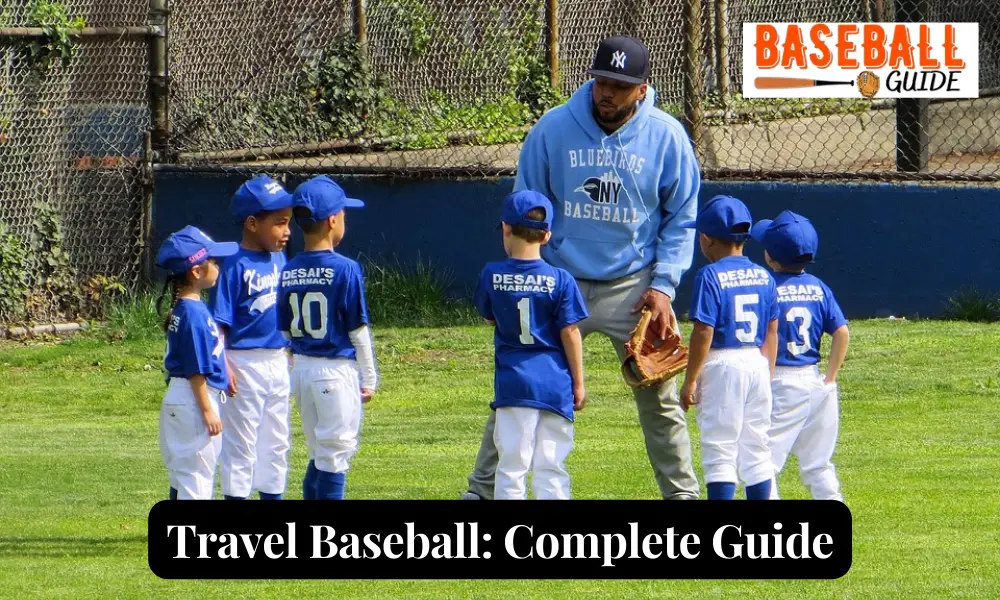
Do you want your child to be a great baseball player?
Are you a youngster who has finally realized that you want to take your baseball skills to the next level?
Or possibly both the parent and the kid are reading together, eager to learn more about improving their baseball skills and turning it into a more serious activity.
If you feel it to be a convenient strategy, participating in travel baseball may provide answers to all of your questions and allow you to accomplish all of your ambitions.
In this article, you will learn all you need to know about travel balls, from the fundamentals to the more advanced aspects.
What Is Travel Baseball?
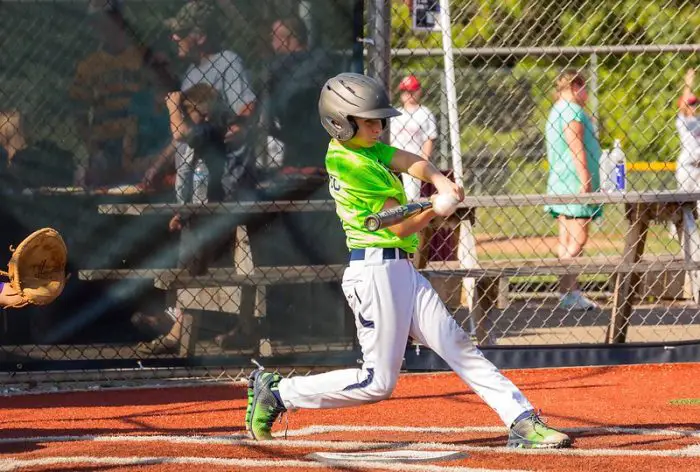
First and foremost, we must familiarize ourselves with the concept of “travel baseball.”
Typically, when people talk about travel baseball, they’re referring to a squad of elite players who participate in tournaments and train at their own facilities.
You may think of it as a sort of youth baseball in which games are played away from home.
Teams known as ‘ travel ball teams or travel teams ‘ in this form of baseball may travel to another state or city to compete in baseball travel tournaments.
Structure Of Competition
A tournament system is used for almost all travel baseball games, played on weekends.
Tournaments may potentially take place anywhere, although they are most often conducted in multi-field sites near major transportation hubs.
You can anticipate traveling more if you reside far away from such transit centers.
The final teams for the event are decided after each travel ball team has played several matches.
Depending on how well a team does, they may play somewhere between three to eight games throughout the course of a two-day or three-day tournament.
The number of tournaments a team may enter isn’t set; although two per month is considered normal, higher-level teams may play more regularly.
Level-Play In Travel Baseball
There are generally three categories of competition in a travel baseball tournament, ranging from the least developed to the most developed level of youth baseball.
This classification is according to Baseball Youth’s DivLevel classification system, which is a travel baseball’s national team division classification system.
1. Division 1 Or D1
Within Baseball Youth’s DivLevel categorization system, Division 1 or D1 is the top level of play.
D1 is better suited for teams considered Major/All-Levels of AAA, Gold, or Elite/Advanced in their respective leagues.
Teams in the D1 division should play the bulk of their games against regionally competitive opponents and/or nationally rated.
2. Division 2 Or D2
Within Baseball Youth’s DivLevel categorization system, Division 2 or D2 is the intermediate level of play.
Teams graded as Medium AA/High AA, Silver, or High-Level Intermediate are best suited to compete at the D1 level.
Teams in the D2 division should play the bulk of their games against other mid-level regional and local opponents in the same division.
3. Division 3 Or D3
Within Baseball Youth’s DivLevel categorization system, Division 3 or D3 is the weakest level of play.
Low AA/All-Levels of A, Bronze, or Low-Level Intermediate/Beginner teams are the greatest fit for the D1 level.
Teams in the D3 division should play the majority of their games against other domestic and regionally-based opponents in the same division.
Travel Baseball Against Little League
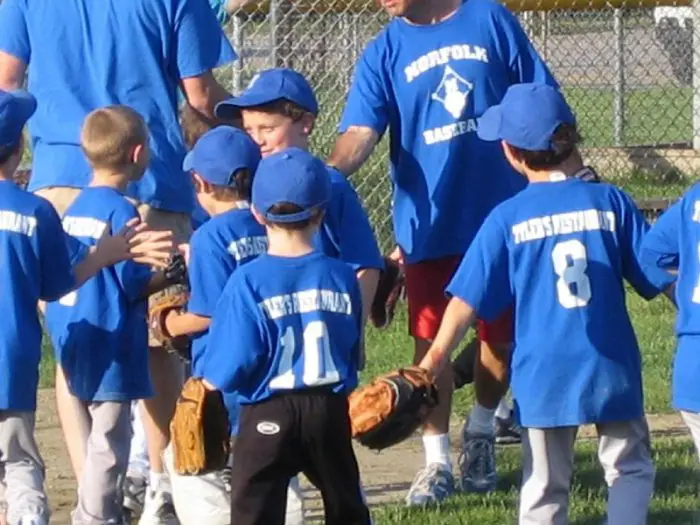
There are several significant parallels and distinctions between travel baseball and little league baseball .
Both aid in developing important life qualities such as a positive work ethic, sportsmanship, cooperation, and the ability to learn from mistakes.
They are, however, significantly different in terms of time investment and competition.
One is recognized for being competitive and raising your skill level, while the other is known for being recreational and a means for youth to learn the rules.
Travel baseball offers a higher competition level than what traditional little leagues provide.
In a single season, roughly 14-20 games are played in both.
There isn’t much difference between these two, other than the amount of seriousness and the fact that you’ll have to travel for a travel ball .
How To Get On A Travel Baseball Team?
As a player, being a member of a travel baseball team is a thrilling experience.
Following are a few pointers that can help you relax and perform at your best, making joining a baseball team much simpler.
1. Be On Time (Or Before Time)

First of all, plan to arrive a few minutes early. If you arrive late, you’ll have to hustle to keep up with everyone.
Arrive early enough to check in, go for a quick jog, play a game of light catch with a buddy, and ease up on your own.
2. If You Are A Baseball Player, Look Like One
Dress appropriately for tryouts; do not show up in jeans or oversized basketball shorts.
The ideal outfit consists of a clean pair of baseball trousers , a decent light sports shirt, and a nice hat worn with the bill facing front.
If you don’t have baseball pants available, a nice pair of sweatpants will do.
3. Practice Makes Perfect
You should play catch even if you only have time to do so twice or three times before the tryout.
If you’ve been to the tryouts previously and are familiar with a few of the activities they’ll be doing; it’s a good idea to put those skills into practice as much as possible.
Practice gaining leads , doing excellent leaps, and anything else you believe you’ll see during the tryout.
4. Play Your Usual
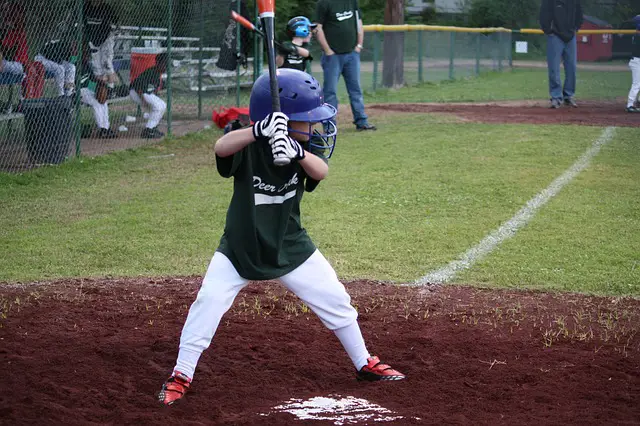
You should just play your game and allow the game to come to you; don’t try to force it.
Simply wait for the right chance to present yourself, and then boldly do your task to the best of your ability.
If you push too hard, you will almost certainly make more errors than you would otherwise.
5. Good Behavior
You’ll be a suitable candidate if you’re willing to work hard and take constructive feedback.
Have a sportsman’s attitude ; if you don’t catch the ball, ask the coach to throw it again instead of pouting.
Don’t be hesitant and hide in places, missing out on the chance to learn what you need to know in travel teams.
Also, remember to be kind to your teammates , motivating them when they make errors and communicating with them regularly while conducting the exercises.
Advantages And Disadvantages Of Travel Baseball
There are upsides and downsides to consider when it comes to travel baseball.
- Strong Competition: Travel baseball lets kids play with and against some of the finest players in their region and even beyond.
The players are more committed to the game and motivated to progress. Your child’s performance will be pushed to the limit by the increased level of competition.
- Improved Coaching: Coaches are frequently ex-players who have gone on to coaching careers in the sport.
There is a higher likelihood that a travel baseball coach will be better educated, more experienced, and more tied to the game.
- Fun Experience: Many weekends will be spent in hotels together, learning about new places and bonding as a group in a travel baseball team.
It’s one of the best ways for young people to go to new places around their region and the country, and they can do it while having an amazing time with their teammates.
- Easy Exposure: You can get a lot of attention from college and professional scouts by playing travel baseball.
One of the best things about being on a high-level travel baseball team is meeting other high-level coaches.
- Character Growth: The significance of travel teams about being on time, behaving well, and putting in the most effort makes a child more disciplined.
As young people move from Minor League Baseball (MiLB) to Major League Baseball ( MLB ), they already have the sense of urgency that they need.
Disadvantages
- Very Competitive: Travel teams take their games seriously and strive to win games.
A travel team must balance the development of its players while still attempting to win matches. This often results in players who aren’t the greatest not having a chance to play.
- Costly: Travel baseball is costly and sometimes extremely costly, which might be a reason for most kids to drop its idea.
- Prioritized Task: Even a reasonably competitive travel squad may consume a summer’s worth of weekends.
As a result, it is a time-consuming task that you must be able to prioritize.
Frequently Asked Questions About Travel Baseball
Some common questions about travel baseball are:

1. How Do Baseball Players Travel?
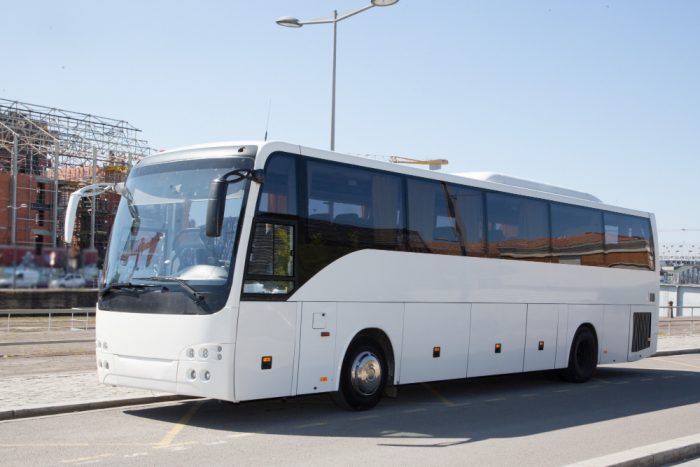
Teams may travel by bus if the shortest path between the two cities is less than 200 miles.
Anything longer than that necessitates plane travel , with all flights being nonstop.
Major airlines, which are generally among the team’s sponsors, charter flights for most MLB clubs.
2. When Does Travel Baseball Season Start?

The travel season is divided into two seasons: Yearly Season (Main) and Fall Season (Optional)
The yearly season starts from around April 1, ends in August , and is compulsory.
While the fall season spans from around September to the late part of October, which is optional.
3. Who Can Play Travel Baseball?
The 8-year-old squad, mostly composed of 2nd and 3rd students, is the first to go.
4. What Age Is Best For Transitioning To Travel Baseball?
Travel baseball would be a logical next step for children aged 11 to 12 (but not younger than that) who want to enhance their talents to the level of a professional player.
5. Is Travel Baseball Worth The Money

Whether Travel Baseball is worth the money or not depends on how serious you are about getting your skills to higher levels.
It gives extra opportunities for committed baseball players who want to get the most out of each year
6. How Much Does Travel Baseball Cost?
The exact cost of participating in travel baseball differs, but it typically costs somewhere around $500 and $2,500 per year.
Travel baseball is an effective way to enhance your skills and increase your chances of playing in college or as a professional.
But, do not overlook the expense and investment of time that comes along with the benefits travel ball gives.
Only the most costly team doesn’t need to make your kid adequately talented to join a team in college or select baseball as a profession, a fairly priced team may be similarly trained and qualified, so you need to get into a team thoughtfully.
After reading this article, I hope that you have a firm grasp of all of the technicalities surrounding travel baseball .
About The Baseball Guide
Follow Us on Social Media
Thebaseballguide.com is a participant in the Amazon Services LLC Associates Program, an affiliate advertising program designed to provide a means for sites to earn advertising fees by advertising and linking to Amazon.com. As an Amazon Associate, I earn from qualifying purchases.
Copyright © 2017 - 2023 Thebaseballguide.com - All Rights Reserved.

Travel Baseball 101: Everything You Need To Know
- By Chris F.
- On July 29, 2022
- Travel Ball
Table of Contents

Most popular organizations
Tournament travel, how is travel baseball organized, additional costs:, what’s a good age to start playing travel ball, other parents, organization websites, what to look for in a team, travel baseball pros and cons, travel baseball vs little league, what is the best travel baseball team, when should i leave a travel baseball team, fundraising ideas for travel baseball.
If you are an engaged baseball parent and have a child with decent skills, you’ve probably grown frustrated with the level of play in the laid-back rec leagues in your towns. I mean, how is your kid going to get better if the other players on the team don’t understand the game and don’t have the desire to improve? This is probably the most significant reason we’ve seen explosive growth in the travel baseball leagues and tournaments.
The transition from Little League to AAU comes with many questions, but the good news is that these travel leagues will provide a support system and structure to help your child succeed in highly competitive baseball.
In this article, we will cover everything you need to know about travel baseball and help answer any questions that will help you determine whether or not these types of leagues make sense for your child.
Travel Organizations
Let’s not beat around the bush. Travel baseball is a business. This market has exploded over the past decade, and the youth sports industry expects to grow more as travel teams become more popular.
This $15b youth sports market in the US rivals that of the $14 billion NFL, so you know we are talking about big business.
However, this business presents kids as young as eight with opportunities to team with other skilled players to play against better competition in their area. Teams will compete with other travel teams within the state and participate in regular tournaments.
When people hear “travel baseball,” they immediately think the team goes all over the country every weekend to participate in different tournaments. In some cases, that may be true, but when I think of travel baseball, I think of some of the better local players coming from all over and trying out for the team. If you are on more of a showcase team, you will often have players come from all over the country.
.stk-2b1a187{margin-bottom:0px !important}.stk-2b1a187-container{background-color:#96caf9 !important}.stk-2b1a187-container:before{background-color:#96caf9 !important} There are thousands of travel baseball teams throughout the country, and most play in tournaments or leagues organized by AAU, USSSA, and Perfect Game.
Playing in one of these leagues is almost a requirement if you are a talented ballplayer and are serious about your baseball career. While expensive, these leagues will help players develop their skills and play against some of the area’s best competition.

If your child is on the younger side and is just getting started with travel baseball, most of the games will be local, with a few longer-distance tournaments mixed in. Once you get to that 16u-18u range, the tournaments become more about exposure and getting recruited by colleges so that you might travel to Georgia, Florida, North Carolina, South Carolina, etc.
You won’t go to all these travel baseball tournaments every year, but the WWBA, for instance, is one of the biggest tournaments in youth baseball and is located in Georgia. Many college coaches attend this tournament, so it’s an excellent opportunity to showcase your skills and gain exposure.
If you are a player from one of the colder states and are interested in playing down south , these tournaments provide a great platform for you to make some new connections and show some of these coaches what you can do.
When I think about travel baseball, I don’t think of it as being seasonal. Some teams will have their regular season in the spring, and some even play in the fall.
During the winter, especially in the Northeast, my son’s team had bi-weekly practices in one of the local indoor facilities where they could train. This allowed the team to build chemistry while also keeping them fresh. Travel baseball will allow you to practice all year round if you want to while you play other sports.
All the travel league games my son has played in have taken place on the weekends. We typically have a doubleheader against the same team to squeeze in more games with a short break in between.
The tournaments usually consist of the top 8 teams in the League and are set up in a pool format. Those tournaments can be held anywhere, but we’ve traditionally hosted them at a local sports complex with multiple fields.
Suppose your tournaments are made up of more than ten non-local teams. In that case, they will usually take place in a central location with the infrastructure to accommodate traveling families for the weekend.
With pool play, teams are guaranteed a certain amount of games before moving into the single-elimination games. Depending on the size of the tournament, a team may play between 2-8 games during the weekend.
When signing up for travel ball, part of what you are paying for could include participation in a certain amount of tournaments. I know we were guaranteed at least one tournament, and everything else would be at an additional cost.
Each team will decide which tournaments to participate in and how many they’d like to do. The coach will need to look at age level, skillsets, and how many families can afford the additional cost.
When the players enter high school, they may start participating in player showcases or tournaments where coaches and scouts come to watch and evaluate players.
How Much Does Travel Ball Cost?
I’m not going to lie, when I first saw the cost of playing travel AAU baseball, there was definitely sticker shock. Our League tries to keep it affordable for families, so we were apparently on the lower end at $1700.
When you break it down, though, it wasn’t too bad. The kids got home and away uniforms, sweatshirts with their names, two sets of hats, helmets, Easton bags, and a batting warmup jacket.
The team had access to an indoor baseball training facility twice a week starting in the fall through April to practice. The fee also included a spot in a local tournament.
Other travel teams near us were upwards of $4k for the season. When I heard that, I stopped complaining about our price. Many of these travel baseball teams come with exorbitant prices that, unfortunately, eliminate many families and kids who can compete at this level.
.stk-110d1c6{margin-bottom:0px !important}.stk-110d1c6-container{background-color:#96caf9 !important}.stk-110d1c6-container:before{background-color:#96caf9 !important} When it comes down to travel baseball teams, the price can be pretty shocking to most parents, so you must decide how big of a financial impact this will have on your family. The League’s overall cost will differ but typically ranges from $500-$5,000 a year.
That amount is only the fee to play on the team. When you put together a potential budget, there are many additional costs to factor in.
- Equipment – New bat rules may require you to buy your child a new bat. There are USSSA leagues that require USSSA bats, USA bats , BBCOR bats, and wood bats only. If you are lucky enough to be on a sponsored team, sometimes equipment such as bats, gloves, and other baseball gear is included.
- Travel costs – Even if you aren’t flying to a tournament, you will most likely be driving considerable distances, so be sure to factor in the price of gas.
- Are the coaches being paid? Most likely not if you are on a younger team, but some older, more competitive travel teams pay their coaches.
- Facilities – We lucked out because practice time was included in our league fees. Teams who may not have access to public fields and practice off-season will have to rent space.
These are all the costs associated with your player and the League. Now, what about the stuff you will need as a baseball parent? Team gear, comfortable camping chairs , coolers, wagons, heaters , and fans.
Over the past twenty years, travel baseball’s popularity has exploded. Initially designed for teenagers, younger age groups have also taken over the sport.
Our first taste of travel ball was when our son was eight years old, playing on our town’s summer travel team. We didn’t have to travel far, but it was a fantastic experience.
It was a little more competitive than rec ball, so it gave us a good idea of where our kids stacked up compared to other towns. While eight sounds young, the kids improved during the month-long season. They knew who to back up, where to take the cut-off throws, and when to tag up on the bases.
It was so nice to see them begin to understand the little intricacies of the game, and they would not have received this type of instruction in town ball. While we had a great experience with our eight-year-old’s summer travel team, it is still pretty young.
I’d say the best time to start competitive travel baseball is around 9-10. It’s sad, but any later, you and your child will fall behind. Many kids have played years of competitive ball by then.
How Do I Find A Travel Team Near Me?
If you have decided that travel baseball could be a good fit for your son or daughter, it’s time to start looking for a team. If you think your child would benefit from joining a travel baseball team but have no idea where to start, there are many resources to help you find some squads in your area.
Facebook is a great place to start. In the search box, type in travel baseball near me or travel baseball ga for example. You will see a feed of many local teams advertising for upcoming tryouts or even established teams looking for a player to fill in for a tournament.
After watching rec ball for a season, you will recognize who the best players are. Talk to their parents and ask them if their child is doing travel ball. If they are, ask them what their experience has been. Talking to other parents can also be helpful because if their child isn’t already in travel ball, they may know someone else who is. Word of mouth is huge.
Many organizations, like USSSA, provide a list of active teams on their website. You can filter by age, location, and overall skill level to find potential groups that might be a good match for your child.
A few other helpful resources for finding a travel team are Select Baseball Teams , AAU , and Field Level .
- Does the program win?
- What is the team’s location, and how far do they need to travel?
- Do they develop their players? What is their team mission?
- What is their facility like?
- Who are the coaches – read their bios on the website
- How many games/tournaments do they play each season?
- How often do they practice
- What is the total cost for the season?
- What does the offseason training schedule look like
- Do they encourage multi-sport athletes?
- Do other players enjoy being on the team?
- What’s the reputation of the organization?
- What’s the skill level of the kids?
- How is playing time determined?
- Do they protect the pitcher’s arm by adhering to pitch counts?
- How many kids are on the team
When it costs thousands of dollars, money will always be an issue but try not to make your decision solely based on cost. Pick the program where your child will have fun and where they will develop the most.
- Competition – Competition tends to be better. Players take the game more seriously and seem to want to improve. It’s not cheap, so unless the parents have money to throw away, they will only pay the fees if their child is serious about the game.
- Development – There’s a bigger focus on skill building. You practice much more than Little League, so your child will likely improve.
- Coaching – Travel teams will often have multiple talented baseball coaches who are more qualified and have more knowledge of the game and how it should be taught.
- More exposure for the kids when they play in regional tournaments.
- More games played
- Travel – more opportunities to travel as a family and see different parts of the country
- Cost – The price of playing travel can be high, sometimes up to $5k per year.
- Time – Playing travel ball takes up a lot of time, so hopefully, you don’t like your weekends free in the summer.
- Competitive – Travel ball can also be a lot of fun, but it’s way more competitive . There is more of a focus on winning and advancing in tournaments.
- Playing time – The best players will rarely come off the field, so if your child is average, there might be a lack of playing time.
- Lack of diversity – Aside from the high cost, many argue that the lack of ethnic and socioeconomic diversity is what is wrong with travel baseball.
- Overdoing it . Is all of this playing too much too soon? There’s been an enormous increase in Tommy John procedures over the past decade amongst young pitchers.
The debate about travel baseball vs. Little League has been a popular topic in US youth baseball for some time. The two organizations have different philosophies on the game and how it should be played.
We all came to love the game of baseball by playing Little League. For that reason, it’s easy to be biased toward the more laid-back rec leagues where the mission is to foster community, volunteerism, sportsmanship, and fair play. With Little League, whether you win or lose, each ballplayer should have fun, make lifelong friends and grow their love for this beautiful game.
Travel ball is much more competitive, and fans of these types of leagues prefer the more “advanced” brand of baseball that comes along with it. In AAU and other travel ball associations, these leagues provide a level of instruction, coaching, and competition that Little League cannot match.
If your child has shown true talent on the ballfield, considering “travel” should be an option. Many high school players and beyond have played in some competitive travel leagues.
I don’t want to give off the impression that these leagues have no similarities because they do. In any league, the kids should learn about teamwork, sportsmanship, respect for their opponent, work ethic, and dealing with and bouncing back from failure. These are excellent life lessons that extend well beyond the baseball field.
The differences are around the competition level and the time commitment. Little League doesn’t always offer the type of coaching that will take your game to the next level. That is why many families are supplementing with travel ball.
So, if your child is serious about playing at a high level, you should transition to travel ball at around 11-12 years old, if not earlier.
Take a look at travel baseball rankings to see who the best performing teams were this year. This site is an excellent resource because it lets you filter by age and either state or national rankings. It even allows you to see historical data to see who consistently ranks at the top.
Some of the top 16u national teams for this past year are listed below. You will see that most originate from the baseball hotbed states of Texas, Florida, California, and Georgia.
16u Rankings
- USA Prime National(TX)
- Top Tier Roos National(FL)
- Exposure Under Church(TN)
- TBT National(FL)
- Power Baseball Marucci(FL)
- East Cobb Astros(GA)
- Knights Nation Baseball (LA)
- Alpha Prime National(CA)
- MCBC Hit Dogs(MI)
- 5 Star National Black(GA)
- Burn Scout Team(FL)
- Top Tier Roos American(FL)
- Canes National(VA)
- CBU United(FL)
Let’s face it; every child will not have a fantastic experience with their travel team. There are so many different factors that go into whether or not a kid has a positive experience.
- Are they getting enough playing time?
- Are they developing their skills?
- Is the team winning?
- Do they get along with the other kids on the team?
- Is it getting too expensive for the family?
- Are they mad about the time commitment, missing birthday parties, sleepovers, etc.?
- Are the coaches compassionate and caring about you as a person, or are they only worried about winning a cheap plastic trophy?
It won’t be the same experience for everyone, so chances are, you and your child will know when it’s the right time to leave. It may be one of the reasons listed above or something completely different. Still, the bottom line is that if your child is not enjoying the experience and is not improving, why continue wasting money?
- Super Bowl squares
- Yeti Cooler raffle – 1 ticket for $10 or 3 for $20
- Lottery ticket basket raffle
- Stand in front of Dunkin Donuts or the grocery store with signs and helmets to collect the money. Have a sign that says we take Venmo!! Do it in 3 hours shifts and watch the money roll in.
- Golf tournament – although more complex to plan
- Solicit donations from local businesses
- Hit-A-Thon – They hit 15 (or whatever # of balls you choose). Each ball has a number on it. You sell each number for $10-20. The ball he hits the farthest wins a GC. The rest of the money you keep! Stream it live on Facebook for everyone to watch. Use the 99 Pledges site to set it up. I read about one League that raised $44k in one season.
- Purse bingo
- Meat raffles
- Wreaths at Christmas
- Popcornmania
- Pampered chef
Final Thoughts
Baseball should still be fun. As good as it might feel, do not try to relive the glory days if you even had them in the first place.
Many parents see baseball or any other sport their kid is playing as the only realistic path to college, and these youth games are treated as training grounds for an athletic scholarship. No wonder why you have adults screaming at umps and other kids. Unfortunately for some folks, every game feels like life or death.
So, is travel baseball worth it? It can be a rewarding experience for your player and the entire family. You must select the right travel team to ensure you have that fulfilling experience.
Depending on when you start, you will be with this coach and these players and their families for the next few years. Committing to a travel team will turn your life into absolute chaos, but you will learn to love it. If you are lucky enough, you will join a team where you click with the other parents, and your kid becomes lifelong friends with his teammates.

- Skip to main content
- Skip to secondary menu
- Skip to primary sidebar
- Skip to footer
BASEBALL~X~GEAR
Your Source For Everything Baseball!
Travel Baseball: A Guide For Parents & Players
Baseball has changed.
Well, not the game necessarily. The diamond is still the same dimensions, as is the distance from the rubber to the plate. But the way the game is played has changed – specifically at the youth level.

For decades, organized youth baseball was a seasonal sport, played on town diamonds under the banner of Little League Baseball. Each spring, kids would join their local league and play with their friends, against teams made up of kids from the same town, coached by a group of fathers. There was little travel, little intermingling. It was a local sport, unless you made the All-Star team.
Youth baseball was based around recreational leagues , with little emphasis put on the competitive nature. There was a set schedule, with spaced-out games and a hyperlocal focus. It was just a spring sport, one of many sports played by youth across America.
Now, things are different. Kids who play baseball have a chance to forge their own path, to take part in more than just recreational leagues played in the springtime. The recent introduction of youth travel baseball has made it easier for young players to specialize in the sport that they love, focusing on their development on a team that plays throughout the year.
Travel baseball can be difficult to get involved in. Many times, there is anxiety surrounding it, with questions that are hard to answer. Is it worth it? How much travel is involved? What team should my child join? What will he gain from it?
We’re here to break it down for you, uncovering some of the secrecy surrounding travel baseball.
What Is Travel Baseball?
Travel baseball is a relatively new way to play. Until recently, travel teams only existed in parts of the country that were baseball hotbeds – places like Florida, Southern California and Virginia. Only elite players took part, the best of the best, and it was focused on the upper levels of youth baseball, where scouts could get a better look at developing players, gauging their professional prospects.
It was intended to be more of a showcase for older players, but in the last twenty years, baseball at the youth level has evolved considerably. Now, travel baseball is almost a necessity for any player that’s looking to hone their skills and be serious about baseball. Instead of being a place for a young player to showcase their skills, it has become a place where a younger player can develop, can receive specialized instruction. It’s also a way to face an increased level of competition.
Travel baseball isn’t a monolith. It goes by several different names: select ball, club ball and premier ball. There are several different governing bodies, including USSSA , Perfect Game, AAU and Triple Crown Sports. But each team has something in common: the structure of its season.
Instead of being focused on individual games, spaced out through the week with practices and off-days, a regular season and postseason, travel ball is centered around tournaments.
Most of these tournaments happen on the weekends. Teams can play several games each day during a tournament, sometimes against teams from different governing bodies. These tournaments are not always local, as some of the best teams travel across the country to compete, while others prefer to stay closer to home.
Teams in travel ball can be started by anyone. Sometimes they’re started by a baseball academy, while other times they’re started by a group of parents looking to branch out from a Little League. Some teams have squads in each age bracket, for each level of baseball ability, while others are the only team to bear their name.
It must be noted that due to its competition structure, travel baseball is pay-to-play. Entering tournaments costs money, as does renting batting cages and getting field time. Thus, travel baseball costs money, which to some people, is a deal breaker.
How Much Does It Cost?
Here’s the short answer: it depends.
What does it depend on? The structure of the team, the level at which it plays, and the travel that’s involved.
Sometimes, those fees are high, in the thousands each year. This is mostly confined to teams at the elite level, teams that travel frequently and enter tournaments with top-tier squads. And while parents may fork out thousands of dollars for their child to play, that amount doesn’t include travel costs. Those will have to be paid for out of pocket, especially for parents who want to see their child play in far-away states, where high-level tournaments are held.
However, for teams that travel locally, have volunteer coaches and enter less expensive tournaments, the costs can be exponentially lower, in the hundreds each season.
So why fork over all that money? Why should your child play this type of baseball? Because, it has its advantages, many of which lead to increased developmental opportunities that a young player would otherwise miss out on.
What Are The Advantages Of Travel Baseball?
There’s a reason travel baseball is so popular among parents and players alike. Playing baseball for a club team can help younger players develop more and specialize in their favorite sport by playing it year-round. But structurally, it provides a number of advantages over regular baseball.
Here are a few advantages that travel baseball provides:
- Better coaching
- Increased competition
- Specialized training
- Team bonding
- Increased exposure
Better Coaching
The old cliché about the typical Little League coach is that he’s the father of a player. In his mind, his kid is the star of the team, even if that’s not the case on the field. The coach probably played some baseball growing up but doesn’t know the technique or the strategy that the coach at the local high school does. He isn’t paid, nor is he all that experienced.
Travel baseball differs in that it offers players the opportunity to learn from coaches who are more focused on development. Many travel-ball coaches have coached for years and some even offer private lessons on the side. Sometimes, teams even have a fulltime coach who is paid strictly to coach the younger players.
Because the coaches are more experienced, the players get better teaching. Hitting practices can be spent refining a certain technical part of the swing. Players who develop a mechanical flaw can work with a coach to fix it quickly. Coaches can look at a player’s skillset and marry him to a position, focusing on the little aspects of that position that matter the most.
Some teams even have a full staff of coaches – a pitching coach, hitting coach and a manager. This means players become more polished and can harness more of their raw ability earlier. It means that they can unlock hidden potential from a coach that can teach them how to get more break on a curve or add a little juice to their fastball – something that they wouldn’t have been able to do in a recreational league.
Increased Competition
Recreational leagues have a low barrier of entry. While this is great for encouraging a passion for the game, it’s not always a great setting in which to develop. Players come from all skill levels and for some, it’s their first time holding a baseball.
What about players who want to specialize in their sport, who know early on that they want to be the best they can be at baseball? What good do they get from playing someone who doesn’t want that – someone with less experience and less polish? What good do they get from someone who is rusty around the edges and can’t throw strikes?
Not much, that’s for sure.
That’s why travel ball is such an advantage for most younger players – because it consists of players with a like-minded mindset, most of whom are focused on their development. That means that players are more polished, that curves have sharper breaks, and those infield grounders are converted into outs more often than not.
The old saying is that if you want to be the best, you have to face the best. That’s why travel ball can be so valuable to younger players – they can gauge their abilities against the best competition and see how they stack up.
Additionally, many teams have “B” and “C” teams. While these teams may not face the best of the best, they’re great for players who are still developing their talents. That’s because those players can face talent at their level as they refine their game, maintaining their confidence and focusing on what they need to improve and sharpen going forward.
For what it’s worth, I had to play on one of those “C” teams one season, as I worked on my skills behind the plate. For me, it was great, because I got to work on my approach behind the plate and focus on positivity. It really did wonders for my game, in the long-term timeline, because my confidence was high going into the next season, when I rejoined my regular team.
Specialized Training
I’m huge on specialized training, especially when it comes to fielding. Really, this advantage of travel baseball is an outgrowth of the advanced coaching one receives, but it is so, so critical in order to become a great player.
While often overlooked, fielding is key to become a well-rounded player. And as a former light-hitting outfielder, I can attest to the fact that it can be a way to get noticed and get playing time, even if you don’t hit well.
Some of the best training I received in travel ball was fielding training that focused on footwork in the outfield, leading to better routes taken to fly balls and ultimately, better range. It was highly technical training, something that I doubt I could have received elsewhere.
For catchers and pitchers, this is especially true. Catching is something that is hard to teach in recreational ball – you either have it or you don’t. But in travel ball, catchers can focus on honing their craft during practices, working newly created drills that really help receiving and controlling runners.
Because a lot of travel teams have their roots in baseball academies and developmental centers, it is easier to get sidework in, and field time is also easier to obtain. That clears a major hurdle when it comes to developmental work.
Team Bonding
In recreational leagues, you’re playing with your friends and acquaintances. It can be cool, since most of y’all go to school with one another and grew up playing together. However, those bonds are not as strong as the ones forged in travel ball.
Because of the sport’s nature, with intense training, many hours spent together, and yes, travel time, the bonds forged by club ball are stronger. The atmosphere sometimes mimics that of higher levels, as players share the same buses and hotel rooms on trips.
Interpersonal bonds are formed by time spent together and a shared sense of purpose, often in the face of adversity. In travel ball, where weekend tournaments consume free time and practice is held most days, there’s plenty of that to go around. With shared interests and a focus on development, players have more in common – thereby making those bonds easier to forge.
Sports create lifelong friends, and travel ball is a testament to that.
Here’s a shocker, one that you may not have noticed yet: in travel ball, teams get the opportunity to travel. Crazy, right? Anyway, one of the big advantages of travel baseball is the opportunity to go beyond the local sandlot, even if it’s just locally. Some of the smaller teams focus on limited travel, never going more than a few hours out of their way, but that still affords a younger player a chance to see other parts of the country, a chance to get out of the confines of their own backyard.
Other teams travel more – around the region or even nationally. This gives players a chance to really broaden their horizons, but it’s also very exciting. There’s something special about going to a tournament two states away to prove your worth. For a younger player, it’s fun to spend time with teammates in hotel rooms – almost like a short vacation during the time off.
For parents, it can be fun too. Many of these tournaments are hosted in centrally located cities, where amenities and attractions are plentiful. For example, Orlando commonly hosts these tournaments because it is centrally located, with an excess of fields.
Local tournaments can feature more than just baseball there, as parents and players alike can visit one of the city’s amusement parks.
Increased Exposure
This one is for the players at higher levels. At the summit of club baseball, it can still be very much as it was in its early days, where showcases of talent are the main priority. Organizations like Perfect Game provide weekend-long tournaments dedicated to players who want to be seen in front of major league scouts. They take time to go through a combine, showing off their bat, arm, glove and speed, before taking part in a few games.
Plenty of folks are watching, from college coaches to MLB executives. And they’re all looking for the next big thing.
That kind of exposure is something you can’t get in high school ball, where the rosters are less talent rich. By consolidating so many pro prospects, it becomes a must-see event, one in which a player who puts together a good showing can go from a non-prospect to a prospect.

Is It For You?
Ultimately, the decision to play club baseball is up to individual families. They must weigh the advantages against the costs and the time that must be spent to make such a commitment.
Related Articles
- Comparing Youth Baseball Leagues
- Travel Ball vs Rec Ball
- Youth Fall Baseball
A lifelong baseball fan, Jacob Prothro has covered all levels of baseball for MLB.com, The Wichita Falls Times Record News and Rivals.com. Prior to that, he was a light-hitting outfielder in the Texas high school ranks. In his free time, Jacob roots for the San Francisco Giants and plays in a men’s league, where he still hasn’t figured out how to hit a curve.
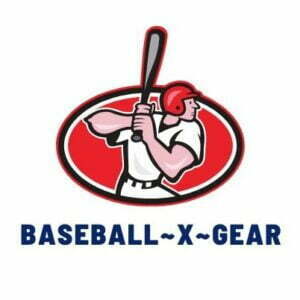
About Me Ask Jeremy Contact Me Terms of Use Disclosure Privacy Policy
Baseball Information & Resources Baseball Rules & Plays Learn to Play Baseball Youth Baseball Baseball Gear & Equipment

Home » What Age Should My Son Play Travel Baseball?
What Age Should My Son Play Travel Baseball?
Travel baseball is a great way for young athletes to improve their baseball skills and gain valuable experience playing with and against more experienced competition. It’s a great way for kids to get out of their comfort zone and really challenge themselves. However, knowing when the right time is for your son to start playing travel baseball can be tricky. In this article, we’ll discuss the different considerations for deciding when your son should begin playing travel baseball.
Understand the Different Age Levels of Travel Baseball
The first step in deciding when your son should start playing travel baseball is to understand the different age levels of travel baseball. Generally, travel baseball teams have players ages 8 to 18 and teams are divided into different age groups. Most teams are divided into three age groups: 8U (8 and under), 10U (10 and under), and 12U (12 and under).
The age groups are important because they determine the level of competition your son will face and the skill level of the other players on his team. Generally speaking, the older the age group, the more experienced the players will be.
Evaluate Your Son’s Baseball Skills and Experience
Once you understand the different age levels of travel baseball, it’s time to evaluate your son’s baseball skills and experience. It’s important to remember that travel baseball is more competitive than recreational baseball, so it’s important to make sure your son is ready for the increased level of competition.
If your son has played recreational baseball for several years and is a strong player, he may be ready to start playing travel baseball. However, if he is a newer player or is still developing his skills, it may be better to wait until he’s more experienced before starting travel baseball.
Consider Your Son’s Commitment Level
Playing travel baseball requires a greater commitment than recreational baseball. Travel baseball teams typically play more games in a season than recreational teams, and they may also practice more often. Travel teams also typically participate in tournaments throughout the season, which may require traveling to different cities or states.
Before signing your son up for travel baseball, make sure he is ready and willing to make the commitment. If your son is not ready to make the commitment, it’s better to wait until he is older and more mature before starting travel baseball.
Think About the Cost
Travel baseball teams typically cost more than recreational teams. The cost of travel baseball can vary, but it typically includes things like tournament fees, travel expenses, and equipment. It’s important to consider the cost of travel baseball before signing your son up.
If the cost of travel baseball is too high, you may want to wait until your son is older and more experienced before signing him up. This will give you more time to save up for the cost of travel baseball and make sure you can afford it.
Take Your Time
When deciding when your son should start playing travel baseball, it’s important to take your time and make sure he is ready. Travel baseball is a great way for young athletes to improve their skills and gain valuable experience, but it’s important to make sure your son is physically, mentally, and emotionally ready for the increased level of competition.
By taking the time to evaluate your son’s baseball skills and experience, consider his commitment level, and think about the cost, you can make sure your son is ready for travel baseball and find the right age for him to start.
- (417) 464-6333
- [email protected]

The Ultimate Guide to Travel Baseball
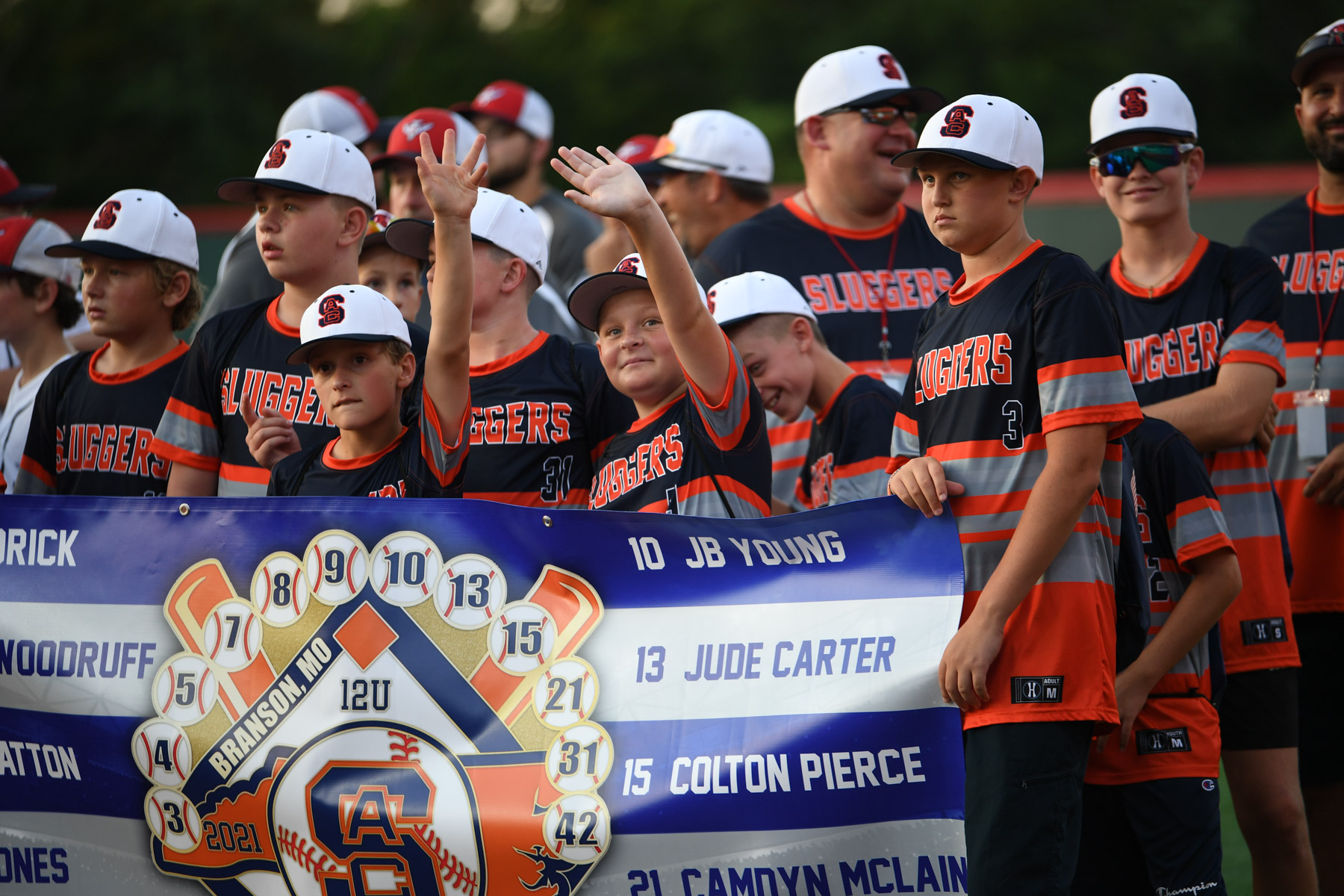
Here at Ballparks of America , we love travel baseball. And we’re not alone. Over the last 20 years, youth travel baseball has become increasingly popular. Take the All-American Wood Bat Classic as an example. During the first year of the tournament, in 2000, around a dozen teams signed up to play. In 2014, nearly 100 teams attended the tournament .
Joining a travel baseball team has lots of advantages. Kids can become better ballplayers, make friends, and get to experience travel. However, it’s also a large financial and time commitment. And there’s a lot that goes into joining a team.
To help you understand the world of travel baseball, our team has put together a guide that covers the following topics.
What is travel baseball?
How to join a travel baseball team, how to choose a travel baseball team, how to start your own travel baseball team, what are the benefits of travel baseball, what is the downside of travel baseball, how do travel baseball tournaments work, how much does it cost to play travel baseball, how many games are played in a season, what to expect at travel baseball tryouts.
Also referred to as elite, club, select, and premier, travel baseball is an organized form of baseball characterized by competitive play and—you guessed it—travel. It is often seen as an intermediary step between Little League and high school baseball play. Travel baseball has also increasingly become the standard for elite youth players hoping to continue their baseball career in college or on a professional level. The typical age requirements vary by the organization but can range from 6 to 18 years old.
Unlike Little League, which typically has weekly, local games, travel baseball mostly consists of weekend tournament play. However, there are some leagues that cater specifically to elite baseball teams.
There is no singular governing organization in travel baseball. Rather, there are several organizations and facilities that host tournaments with varying criteria. Some of the dominating travel baseball organizations include Triple Crown Sports , Perfect Game , Untied States Specialty Sports Association (USSSA), and Amateur Athletic Union (AAU).
As we mentioned above, competitive play is a defining characteristic of travel ball. Travel baseball teams do not have open registration, but instead, players are required to try out for a travel team. Therefore, a team could be made up of players from all over the state, region, and—in some cases—the country. Typically only the most competitive teams have players from all over the country.
So you’ve decided travel baseball is something you want to pursue for yourself or your child. Now what? There are two ways to play travel baseball, join a team or start your own team .
There are several ways to find a travel baseball team. Start with a simple Google search, “travel baseball teams near me.” Another good option is to check out the large organizations listed above. You can also look on Facebook for travel baseball teams. Don’t forget to search for the alternative names (select baseball, elite baseball, club baseball, premier baseball, etc). Finally, you can check out FieldLevel . FieldLevel is a website that lets you search over 105,000 travel teams by location, age level, and skill level. Once you find a team you’re interested in joining, you’ll need to try out. Coaches typically hold tryouts in March, around the time local schools have spring break.
Depending on where you live and how far you’re willing to travel, there could be several teams to choose from. When faced with a decision of which team to join, there are several factors to take into consideration.
Cost can vary from team to team, depending on how much and how far the team travels. Be sure that the team you choose fits within your budget.
As coaches will have a large impact on the development of a player, you want to be sure to work with coaches that have the right skills, knowledge, and experience. You also want to make sure the coach won’t play favorites with players. This can especially be a concern if the coach has a child on the team.
Although travel baseball tends to be competitive by nature, there are varying levels of competitiveness within the field. If a player is very serious about their development, they’ll want to be playing with teammates and against teams that are performing at a high level. And the opposite is true as well. If a player is not as serious, they might be frustrated playing on a highly-competitive team.
It doesn’t matter how competitive a team is if a player doesn’t get playing time. Travel ball teams typically have 13 players on them. It’s not advantageous to be the 13th best player on a team, because you won’t get very much (if any) playing time. And playing time is important for development and exposure.
One of the main reasons players sign up for travel ball is to eventually go on to play baseball at college or in the pros. Therefore, you want a team that has a strong development program and practices regularly.
Different teams travel different amounts, and it’s important that the amount fits in with the player’s schedule and the player’s family’s schedule.
If your goal as a player is to play in college or go pro, then it’s important to get adequate exposure. To do this, your team needs to play in the right tournaments where scouts will have the opportunity to see you play.
- Find a mentor
- Recruit players
- Hold tryouts
- Determine a budget
- Find a space to play
- Register your team with the travel baseball organizations
Tougher Competition
Travel baseball allows kids to play with and against the best players in the area, state, or—in some cases—the country. This can drastically improve their game.
Travel Opportunities
Getting to visit locations like Branson, Missouri for a vacation and baseball experience is a one-of-a-kind opportunity. Families can experience a traveling together and enjoying competitive baseball at the same time.
More Exposure
For those hoping to play baseball in college, travel baseball offers more exposure opportunities. Tournaments are a great way to get noticed by a scout or college coach.
Better Player Development
Travel baseball teams often provide better player development than recreational teams. Compared to rec teams, travel coaches tend to be more experienced, better connected, and more serious. Some of the most competitive teams actually employ former professional coaches.
More Playing Opportunities
Select baseball teams play a lot more games a year than an average rec team.
What are the downsides of travel baseball?
Possible injuries.
Some critics have argued that the increase in elbow injuries among major-league players may be caused by youth travel baseball.
Compared to Little League teams, travel baseball is quite a bit more expensive.
Lacks Diversity
Due to the cost, travel baseball tends to exclude players in lower socioeconomic brackets.
Large Time Commitment
When it comes to travel baseball, the time commitment is significant. During the season, be prepared to give up quite a few weekends.
Highly Competitive
The goals of travel baseball are to develop players and win games. Sometimes the focus on winning can overshadow player development. Typically, the best players will get the majority of the playing time.
How do select baseball tournaments work?
Each team chooses how many and which tournaments they will participate in every year. Tournaments are typically held on weekends and can take place all over the country. There are also week-long tournaments held during the summer. Teams choose which tournaments to play in based on a variety of factors—distance, cost, age level, potential exposure, and skill level.
Depending on how well they play, a team can expect to play between three and eight games during a tournament. Tournaments usually start with pool-play, where teams are guaranteed to play a certain number of games. If they do well, they then get to play more games which are single elimination.
According to USA Today , on average travel baseball costs families $3,700 per year. However, some families pay upwards of $8,000 per year. These numbers include fees, equipment , training , and travel.
Traveling to weekend tournaments versus weeklong tournaments, like what Ballparks of America hosts, can also have an effect on costs as well. Food, hotels , gas and more are additional factors when deciding where to go with your travel baseball team.
How many travel baseball games are played in a season?
It can vary, but during the summer seasons, players typically play between 50-60 games.
Although every tryout will progress differently, tryouts typically adhere to the following structure.
To start, either a coach or a team captain will lead you through a warm-up. It’s important to warm up properly so you don’t injure yourself during the tryout.
Next, you’ll most likely be asked to do a 60-yard dash. One of the things coaches are looking for is to see which prospects are athletic and fast. You might be asked to run it more than once.
Then, you’ll have a chance to warm up your arms by playing catch.
The next set of drills will focus on position-specific skills. For example, if you’re an infielder, you might be asked to go to shortstop to ground balls. If you’re a pitcher, you’ll be throwing in the bullpen.
You’ll take turns hitting. You’ll only get a few chances to show off your batting skills, so you want to make this count.
In some cases, tryouts may end after batting practice. However, some tryouts end with a scrimmage.
Tips for travel baseball tryouts
It’s important to make a good first impression. Showing up on time demonstrates that you’re reliable. You also want to make sure you’ve dressed appropriately and have all the necessary equipment. And, right when you get there, go up and introduce yourself to the coach.
Beyond just looking for talented players, coaches are also looking for athletes who can help lead the team. Stand out as a leader by helping organize drills and cheering on your potential teammates.
Whether you’re huddling up with the coach or heading out to your position, put some pep in your step. Coaches like to see that you are taking tryouts seriously and putting in the effort. Try to make sure you’re one of the first players to get where you’re supposed to be.
You might not realize it, but the coaches are watching prospects the entire practice, so don’t slack off. Even when you’re playing catch, you want to be sure to put your best foot forward.
Arm strength is one of the things coaches will be looking for. So, no matter what position you play, when you’re in the specific skills portion of the tryout, make sure to throw the ball hard and fast. If you can, start a training program a few weeks before tryouts.
Arm strength is one of the things coaches will be looking for. So, no matter what position you play, when you’re in the specific skills portion of the tryout, make sure to throw the ball hard and fast.
Don’t try to get too fancy with batting practice. Instead, try hit line drives and keep them in the middle of the field.
It can be tempting to try and play the way you think the coaches want you to play. But don’t. If you do, you won’t be at your best and you’ll end up making silly mistakes. Instead, wait for your moment and seize the opportunity.
Yes, coaches are looking for talented players. But they’re also looking for players with potential who can be coached. Show that you’re coachable for listening to advice and implementing it. And it can’t hurt to ask questions that show you’re open to feedback.
Ballparks of America offers premier facilities for travel baseball tournaments
We live and breathe travel ball at Ballparks of America, and we can’t wait for the season to start. Sign up for one of our tournaments today and take advantage of our amazing facilities, dedicated staff, tons of amenities, and fun local things to do. Give us a call or contact us online today. We can’t wait to hear from you!
Spend Your Summer at Ballparks!

Main Navigation
Our facility, complete guide to strength training for youth baseball players, warm-up & cool down: great stretches for youth baseball players, the ultimate training and conditioning regimen for youth travel ball players.
- Campus Maps
- About Sho-Me Baseball
- Adopt A Team
More than baseball
- On Campus Eateries
- The Branson Experience
- Grand Slam Entertainment
- Photography Services
Our Tournaments
- 2024 Fall Tournaments
- 2025 Summer Tournaments
- Spring Tournaments
- Know Before You Go
- Travel Lodging - Guest Services
- BOA Partnerships
- Become a Partner
- Join the Team
Stay In The Know
2025 baseball & softball summer registration now open.

Travel Baseball Pros And Cons

- May 3, 2023
For children, travel baseball is the key to the world of high-level college play . If you want your kid to excel in this sport or if your child shows serious interest in it, youth travel baseball is worth a shot.
With that said, what is travel baseball exactly, and how does it differ from other forms of youth baseball? Read on to find out!
What Is Travel Baseball?
Travel baseball is a form of youth baseball that is played away from a team’s immediate area . Travel teams may travel to another city or state to participate in baseball travel tournaments.
Generally, travel baseball is viewed as an intermediary step between Little League baseball and high school or college-level baseball . Travel baseball is usually much more competitive than recreational baseball leagues like Little League. Besides that, youth travel baseball allows for more exposure for a young baseball player, potentially providing a big boost to a child’s baseball career.
Travel baseball vs. Little League
The Little League embodies traditional youth baseball where children have fun rather than become engulfed in the tough training world of more “serious” youth baseball environments (like travel baseball).
Kids may start playing in the Little League from as young as age 4 . LL games are very rarely held outside a local area , and in this league, children will be learning the basics of hitting, pitching, and other essential baseball concepts.
Little League was traditionally an intermediary stage between recreational youth play and middle to high school baseball . Back in the day, sticking to the Little League and other recreational programs was enough to prepare young players for high school- and then college-grade baseball.
These days, this is no longer the case . Middle school programs are now either subpar or non-existent. Little League is a viable alternative to recreational baseball, but when it comes to building the basis for elite-level competition, it pales in comparison with travel baseball.
With all that in mind, let’s conclude this section with these two points:
- For professional-level development, travel baseball would be a logical next step for children aged 11 to 12 .
- Recreational leagues like Little League or local adult baseball leagues are a great choice for non-competitive baseball players who want to have fun and don’t want to make their life revolve around baseball.
The Benefits Of Travel Baseball For Aspiring Players

My overview of travel baseball and its benefits was kind of vague so far. Now, let’s look at the specific benefits of playing at travel teams compared to rec baseball.
More exposure
I’d say that exposure is the biggest advantage of travel baseball . Getting yourself in front of the right people is important for a child’s long-term success in this sport – travel baseball allows you to leverage this.
At the very least, travel baseball gives children the opportunity to show their worth to high-level college baseball coaches who may have substantial influence in the sport . College scouts also often attend travel baseball meetings. In case your child has what it takes to succeed in baseball, a scout will identify their talent and perhaps give your kid a chance to establish themselves at a higher level.
More competition and thus motivation
Players in travel baseball are better-versed in baseball and are more competitive than rec players . This is actually a good thing – young players will have someone to look up to and will be more motivated to improve .
Children will also learn to face and hopefully overcome challenges that they wouldn’t encounter in recreational baseball. Fierce competition from better players forces weaker athletes to adapt – this is arguably the best aspect of travel baseball, though I still think that exposure is its #1 benefit.
Better coaching
Travel baseball team coaches are typically more competent than their colleagues at recreational leagues . Although travel baseball coaches will put more strain on a young player than a rec coach, the results will accordingly be considerably better.
Not only that, but travel baseball teams often employ former professional coaches who may have strong networks in basebal l. Such coaches not only know how to make a skillful player but also may be able to connect athletes with other teams.
More eye-opening experiences
And finally, travel baseball is laden with eye-opening experiences .
People – and even more so kids – often don’t realize that there is an unexplored world beyond the limited horizon they have become so accustomed to . Throughout their travel baseball engagement, children will be able to meet people with different backgrounds, characters, and views of sport and life in general.
Some encounters with other players will help your kid appreciate sportsmanship, while others will teach them how to ignore fan hate and how to stand up for themselves.
The immense load of the sport itself will also help children get used to investing effort to get results and make them understand that life has its ups and downs .
The Disadvantages Of Travel Baseball

Travel baseball is far from perfect – it has a few disadvantages that parents ought to know about:
- It’s really expensive. Traveling costs can rack up to $5,000 or even $10,000 a year, though in most cases, families seem to spend around $2,500.
- It’s stressful for parents. Parents will have to plan ahead to accommodate their children’s play schedule. Frequent travel can put a toll on any parent, not to mention the financial dent it makes in parents’ wallets.
- Mental and physical strain on children. Tougher and more frequent workouts will undoubtedly produce better players, but they also strain children considerably – both mentally and physically.
- Not everybody will make it in travel baseball. Travel baseball is highly competitive, and usually, only the best players find a place in a travel baseball team. Not everybody will thus make it in this sport.
With commitment, skill, and some luck, travel baseball can be a gateway into professional sport. However, before you decide to have your child join a travel baseball team, you must consider its advantages and disadvantages – both for you and your kid.
Best Baseball Batting Gloves Reviewed
Top 25 Greatest Players in Boston Red Sox History
Marucci 2020 Cat 8 Baseball Bat Review
What To Consider When Looking For A Travel Baseball Team

Now, I’ll outline a few things that you should be looking for in a travel baseball team – in case you are thinking about it as a future for your child.
Costs are going to be the #1 consideration for most parents.
I can’t tell exactly how much you’ll have to spend on entry fees, travel, and equipment – but it will most likely be under $2,500 per year. But depending on certain factors (more about these below), your costs may climb higher – in 2011, CBS News reported on parents who paid $4,000 for their kids’ participation in travel baseball .
You won’t find accurate cost estimates easily – you’ll have to dig deep for that. But one thing is certain – bigger teams with higher-quality coaches are going to cost you more.
To hopefully set you in the right direction, here are some major factors that will affect how hard travel baseball will hit your pocket.
- Your location. Teams based in rural areas will have to travel often and far. In contrast, travel baseball teams in important baseball hubs – like California – won’t have to drive or fly to another city or state too often.
- Whether the team will provide equipment. Bigger and more successful teams may have sponsorships with baseball gear brands. In these teams, players get their equipment for free or at a significantly reduced cost.
- Access to baseball facilities. Some teams have to rent baseball facilities to train. Needless to say, rent is going to be covered from your own pocket – whether in part or entirely. With teams that have their own facilities or train only at public fields, this will not be a concern.
- Coach compensation. Some teams pay small compensation to their coaches or cover their travel costs. Again, a team with such a model will transfer the responsibility for covering compensation to you. This will increase annual fees, but paid coaches are also likely to do their job better.
Travel tournaments in which the team participates. Teams participating in higher-level tournaments will have to pay higher entry fees. More competitive and “serious” teams are therefore going to cost you more.
What about coaches ? Some people may, unfortunately, overlook this crucial aspect.
Here are a few questions that you need to find an answer to regarding coaches:
- Does the coach encourage their players?
- Does the coach give tips and advice tailored to the player’s personal strengths and weaknesses?
- How does the coach handle mistakes? Do they scream at players?
- Does the coach treat all players equally? Or maybe they have favorites in the team?
Don’t become captivated by clean facilities and promises of success in the sport – you may overlook jerk coaches if you do.
3. Location
Your location will matter if your child wants to compete at the highest level in the future.
The thing is that major baseball states like California, Florida, Georgia, or Louisiana have plenty of elite travel baseball teams to choose from . You won’t have to travel far from home to find a worthy team for your kid.
On the other hand, in areas where baseball isn’t that popular, you may have few to no options . Even if there is a baseball team in such a place, it probably isn’t a super-competitive team with excellent baseball coaches.
Suppose your kid is unlucky enough to both want to play competitively and live in a baseball-less area. In that case, you’ll have to travel to another city or perhaps even state to find the opportunities you or your child desire . Not only is travel time-consuming, but it is also costly. You will have to make compromises – either play in a low-grade team or spend time and money to travel to another area.
4. The reputation of the team
The reputation of the team matters as well – for the athletic future of your child. If your kid plays in a team known for unfair plays, they may have trouble getting into a better team down the line.
Beating bad sports habits out of a baseball player can be challenging, and unless coaches are dealing with remarkable talent, they’ll prefer to work with someone who has the right foundation for their team’s goals and values.
5. Competitiveness and skill level
Is your kid looking just to have fun? In that case, more relaxed, less competitive Baseball travel teams would be ideal. Children who don’t intend to reach exceptional heights in baseball will feel out of place in a super-competitive team where everybody works at their limit.
In contrast, if your kid is ready to compete seriously, a more “upper-class” team with skilled players and a demanding coach will immensely motivate them.
In the end, youth travel baseball provides entry to competitive high school and college baseball. Consequently, it gives children a chance to try themselves in competitive play.
Travel baseball is a costly endeavor, and it requires plenty of planning and compromises on your part. Weigh the pros and cons and try to determine what would be the right choice for your child – more light-hearted, recreational leagues, or an astronomically competitive travel team.
Baseball Full Count Explained May 3, 2023
Do Catchers Have To Hit in Baseball? May 3, 2023
What Is A Shutout In Baseball? May 3, 2023
College Baseball Workout Program May 3, 2023

2301-39 Roehampton Ave Toronto, ON M4P 1P9 Canada
- +1 647 365 5077
- [email protected]
TheChampLair.com is a participant in the Amazon Services LLC Associates Program, an affiliate advertising program designed to provide a means for sites to earn advertising fees by advertising and linking to amazon.com.
Should your kids play on a travel team? A guide for sports parents

We are settling into a new year at work and school. For sports parents, it’s also a fresh time to think about goals to help our kids have the best possible experience with a team.
Whether your child is in grade school or high school, he or she is likely playing on a travel team, or you are at least considering it. What does a “travel” team mean?
My older son’s first travel baseball coach (who now coaches my younger son) once described our 9-year-old team as embarking on a figurative trip. While we weren’t going to play in any overnight tournaments yet, the “travel” clarifier was meant to describe the journey we were undertaking.
It’s a journey, all right. Your child is likely to spend hours per week with their teammates, and you will see of lot of their parents. And yes, you will likely go to a games and tournaments a fair distance from your local area and sometimes stay overnight.
Travel sports, in some cases known as “club” sports, can be fulfilling and lead to a kid’s overall enjoyment and development. They can be springboard to high school and college athletics.
Sometimes, though, they can be a toxic experience where a coach plays favorites, certain players get disproportionately more playing time than others and team parents in the bleachers yell at the referees or umpires .
COACH STEVE: Do you cheer for your kid the right way? Use these better options
There may not be an ideal situation for your kid’s travel team but, whether your child is casual or super serious about a sport, you can usually find a good fit.
If you are thinking about trying out travel sports, or if your child has been doing them for a while and is looking for a new team, here are some important factors to consider from youth through high school.
The youth ages: You may not need a travel team
Don’t fall into the trap. Travel ball for pre-middle school kids is not a make-or-break step for a kid achieving success at a sport in high school and beyond.
Travel teams at these ages are often more about affirmation of kids’ “unique” abilities for their parents. Travel sports, and really sports at any level, should be about the kids, not the parents.
If your son or daughter expresses their own interest (not just your interest) in trying out for a travel team at a young age, go for it. However, keep a few thoughts in mind:
- Don’t play on a team that meets every day or requires you to play only that sport : It’s too early for this much intensity. Medical and athletic training experts agree that exposing kids to a variety of sports at an early age and allowing them adequate rest time in between promotes strong physical and mental health.
- Don’t be discouraged if you are cut from a travel team : It means little. In fact, it might motivate your child to try and get better on his or her own.
- You don’t have to be on the “best” team: What your child ultimately needs is reps.
You’ll find there are travel coaches and teams that overemphasize winning, even from the youngest of ages. But balancing winning with skills development is a more productive way to go for keeping a kid playing a sport.
No one wants to lose all the time. It’s demoralizing, as is driving your kids an hour each way to games where their team consistently loses. You want to find a team that wins some, but, more importantly, gives them the playing time and experience they need to get better.
No players should consistently be sitting on the bench, and no one should be restricted to one position. You want your child to develop confidence in a variety of roles.
Playing in recreational leagues, such at Little League, often give your kids the same benefits as travel teams at these ages. Rec leagues generally cost much less (maybe a couple hundred dollars as opposed to a couple thousand or more per season) and you can supplement them by working with your kid on your own. (That's a a terrific way to bond with your child, by the way). You might also find a relatively low-cost clinic run by a high school or college coach or former professional athlete that emphasizes skill development balanced with fun.
Whatever you are doing, if your kid isn’t having fun , it’s not worth your time.
The intermediate ages: Follow your kids' enthusiasm (and their growth spurts) to find a travel team
Travel teams at the middle school ages are generally made up of kids who want to play that sport in high school.
Your son or daughter should find a team where they get mostly equal playing time with the other players. These teammates, and your opponents, should be at a similar skill level. However, playing competitive games with and against kids a little more skilled than yours will only make them better.
Game exposure – taking a lead off first base with the pitcher watching you, sensing the guard coming from behind you to try and steal the ball or the boards looming next to you when you’re skating toward the puck – brings out a player’s competitiveness. You’ll know during this stage how serious your kid is about a sport.
Improvement can move at light speed at these ages as kids grow and are motivated to get better when they see progression. Like with a musical instrument, the amount of practice your child puts in away from official practices will ultimately determine how much he or she improves. Yes, there will still be kids who are naturally talented, but you’ll be amazed at who starts passing whom when kids’ true passion for and ability at a sport kicks in.
Still, don’t play this sport year round. Try a different one for fun during the offseason to rest, avoid burnout and promote overall athleticism. (High school and college coaches love athletic players.) Perhaps you play a sport like baseball or soccer that competes in the fall and spring and has once-a-week winter weight training session. You can supplement that training by playing an indoor sport like basketball.
Finally, know what you are getting into and heed the cost. Travel teams can occupy several weeknights with practice and eat up most of your weekends with games.
If your child isn’t serious about playing a sport in high school but still loves it, play in a recreational league. You also might find a lower-key (and hopefully less expensive) travel team.
If cost is an issue, however, and your kid is highly motivated to play travel, a team might be able to work with you at reducing the fee. It never hurts to ask.
The high school ages: Self-motivation drives success on travel teams
This is the proving ground. Travel players at the high school level are usually serious about playing in college. (And there are generally no parent-coaches around to coddle you.)
Travel teams should not conflict with the high school season. You want them to be an accompaniment to a high school team to get the most out of your young athlete. My older son, for example, plays for his travel baseball team in the summer and fall and his high school baseball team in the spring.
High school-level travel teams are generally geared toward getting kids into college programs. If your child makes one of these travel teams, expect him or her to get similar playing time to the other kids so they can showcase their abilities to college coaches. If your kid isn't playing regularly, it's not worth your time.
Teams that represent high schools, however, are generally geared toward winning. Your child will have to earn his or spot and playing time on the team. The goal is to beat the neighborhood or district rival, and high school coaches play the best players most of the time to try and achieve it. Don’t expect equitable playing time.
You need to be realistic with yourself and your kid at this stage. If he or she is not self-motivated to practice, condition and strength and weight train (high schools can provide programs), they aren't likely to get much playing time on a high school team. Similarly, if you see little or no self-motivation in your child to work extra at a sport, you don’t want to spend your money on a travel team.
Rec teams, however, still exist at the high school level, and they can help maintain fitness and a love for a sport. If you have that love, you might even consider coaching a youth rec team when you’re in high school.
A note on bad coaches: You have the power to choose a better one
The coach can make or break the experience. Make a firm assessment before you kid begins playing for his or her travel team.
I found when my sons reached middle school, they responded and related better to younger coaches who played the sport in high school and/or college than to me and other parent coaches.
Regardless of age, look for a coach who is transparent with parents but also discourages them from getting too heavily involved in the inner workings of the team. You also want a coach who doesn't permit spectators to “coach” their own kids from the stands during games.
Ask the coach about his or her policy on parent interference. At the very least, doing so will alert the coach to think about how to deal with meddlesome parents. You may even prompt the coach to call a preseason parent meeting to nip the issue in the bud.
COACH STEVE: Three steps to deal with a problematic coach
Once the season starts, look for potential warning signs about the coach’s own conduct and encourage your kids to talk to you about what they see. One parent in Northern Virginia told me her daughter has a youth soccer travel coach who has spoken to players in what the mother describes as a "borderline verbally abusive manner." The coach has even told players they shouldn’t tell their moms and dads what he is telling them.
The woman knows about the coach’s behavior because her daughter told her about it. The daughter learned, her mother said, that some adults make poor choices and that she needs to speak up for herself or tell her parents when something seems off.
This girl wasn’t one of the players who was singled out, though. The parents of those players apparently haven't spoken up out of fear the coach will take it out on their kids.
If you are proactive about choosing your child’s travel coach and team, though, you can avoid being in a situation like this one.
Steve Borelli, aka Coach Steve, has been an editor and writer with USA TODAY since 1999. He spent 10 years coaching his two sons’ baseball and basketball teams. He and his wife, Colleen, are now loving life as sports parents for a high schooler and middle schooler. For his past columns, click here .
Got a question for Coach Steve you want answered in a future column? Email him at [email protected] .

Travel Baseball: Pros and Cons
We are reader supported. When you purchase through links on our site, we may earn an affiliate commission. Also, as an Amazon affiliate, we earn from qualifying purchases.
Travel ball is one of the most popular forms of competitive baseball in the United States, and it is only growing in popularity. It can start as young as six years old and go all the way up to 18.
Travel ball consists of teams that are independent of any amateur league, school, or organization that travel to tournaments locally, regionally, and/or nationally to compete against other travel teams.
As more kids each year are taking advantage of travel ball opportunities, more and more parents are considering travel ball as an option for their child to improve his baseball skills. Before committing to travel ball though, one must weigh the pros and cons.
Pro: Competition
Travel ball teams are notoriously more competitive than rec league and sometimes even high school teams . Because travel ball teams are able to recruit the best of the best in their city, state, or region, teams are typically more talented.
This allows players to play with peers who share their passion and talents for the game. Also, it gives them the opportunity to play against peers with equal or greater skill than themselves. This allows them to push themselves to become better players.
Players who typically dominate rec leagues and high school games should consider travel ball as an option to play against better competition.
At the youth level, parents sometimes opt to play a full season of travel ball and skip little league altogether. This can be controversial as some believe that doing this is unfair to the community leagues, but it often benefits the player and challenges him to improve.
At the high school level, players often use travel ball to supplement their high school season. They play in the summer and sometimes fall when their high school team is not in season. Very rarely does a high school player opt to only play travel ball.
For players who struggle in little league or high school, travel ball may not be the best option as the competition may be too much for them. Their confidence in their abilities may suffer making it counterproductive.
For any amateur player looking to play with and against better players, travel ball is a great opportunity to do so.
Pro: Exposure
One of the main reasons many high school baseball players with hopes of playing college ball decide to play travel ball outside of their high school seasons is the exposure they may get because of it.
Most of the time, college and high school baseball seasons overlap leaving little time for college recruiters to get out and see players. High school travel ball normally takes place during the summer while colleges are not in season. This gives them more opportunities to be seen.
Also, many high level travel teams have systems in place to afford players the best opportunity to earn interest from college coaches. Many travel coaches have connections with college recruiting coordinators, so they often reach out on their players’ behalf to get them on recruiters’ radars.
More competitive travel teams also play in a lot of tournaments hosted by companies such as Prep Baseball Report and Perfect Game. These are scouting services devoted to helping high school players find colleges and for colleges to find talented prep players .
At these tournaments, players’ stats and measurables are recorded and added to their recruiting profile for college coaches to see. They also sometimes record videos that they share on social media.
Playing travel ball is not the only way to gain exposure in front of college coaches, but it is one of the more effective ways to play in front of recruiting coordinators.
Pro: Relationship Building
Travel ball also has non-baseball-related advantages.
Travel teams are normally made up of players from different areas of a particular city, state, or region. This affords young kids the opportunities to develop friendships with other kids outside of their hometown.
This allows them to broaden their horizons and experience things outside of the perspective of their hometown. Sometimes, players will form lifelong friendships with kids they never would have met outside of travel ball.
Not to mention the relationships that can be formed from a parent’s point of view. Sometimes, the adults of the children on the team can form lifelong friendships that otherwise may have never had a chance to develop.
Pro/Con: Playing Time
Yes, believe it or not, playing time is both a pro and a con when it comes to playing travel ball.
The positive side of it is that playing time is easier to come by in travel ball. Teams are often made up of anywhere between 9-12 kids to ensure that everyone gets enough playing time .
For coaches, it is important to evaluate the talent level of both your team and the players on your team. Ideally, they should all be about equal in talent level with maybe a few outliers who clearly have more talent than the others.
If a team has nine players that are head and shoulders above the talent level of the remaining two or three players, it will be difficult for a coach to get those two or three players in the game therefore leaving an unequal amount of playing time.
Parents let their children play travel ball in hopes that they will develop their skills, and those skills can only be developed through ample playing time. Most of the time, travel ball teams offer players that opportunity.
On the negative side of things, some people believe that this creates a false sense of security in young players. As competition against other teams is increased through travel ball, competition in playing time is decreased.
Some high school coaches feel that their players expect to start every game regardless of their talent level or their work ethic thanks to travel ball. This even leaks into the minds of their parents as well.
When they go from playing on travel teams where playing time is guaranteed to playing for their high school team where the best nine players get to play, they have a much more difficult time accepting a role as a bench player.
To combat this, travel coaches should make both players and parents aware that while their child may be guaranteed playing time on his travel team, that will not be the case in high school . While this may not solve every problem, it may help clear up any misconceptions.
Con: Coaching

Some travel teams have coaches with lots of playing and coaching experience and take their job as coaches very seriously in helping to develop players’ skill sets.
However, one of the biggest complaints about travel ball is that there is often not enough focus on player development . Coaches just put together lineups and let the kids play.
Sometimes, as is the case in younger levels of travel ball, coaches are parents who may not know as much about the game but are willing to spend time organizing practices and tournaments for the kids.
Also, parent-coaches can sometimes muddy the waters when it comes to playing time. If others feel the coach’s son is getting special treatment, it could cause friction among the team.
Any parent who volunteers his time to coach a travel team should be commended, but he should be prepared for complaints from other parents if his child gets more playing time than other players. It doesn’t always happen, but it is certainly a possibility.
To combat this, some travel teams hire a third party to come in and coach the team. These are often younger coaches who are looking for extra income and ways to get started in coaching.
There are some great travel team coaches out there, but for every good coach, there are many more who struggle.
Probably the biggest complaint about travel ball is the cost to play.
Travel baseball costs on average about $3,700 per year. It is not unusual for parents to pay close to $10,000 for their child to play on a travel team.
Before complaining about the cost, remember that travel teams are not affiliated with any leagues or organizations, so they are on their own when it comes to uniforms, equipment, tournament fees, umpires, coaches (sometimes), hotels, etc.
The typical travel team is not for the family who struggles to pay the bills each month. However, there are travel organizations with sponsorships that pay for most everything for the players. The only downfall is that these teams are typically exclusive to players with elite talent.
Some teams opt for fundraising efforts to charge parents as little as possible for their players to play on a travel team. Either way, parents should expect to fork up some money for their child to play travel ball.
Con: Length of Season
Another criticism about travel ball is the number of games the teams play. Some youth travel ball teams start in early April and play every weekend all the way up until Labor Day weekend.
If a team followed that schedule and played at least three games each weekend, that would be 66 games over five months . Three games is the minimum most teams play in a weekend. It is sometimes as many as six or seven.
This is the reason many kids get burned out on the sport before they even reach high school. They simply play too many games too early in life.
High school summer teams usually don’t start until June because of the high school spring season, but they are notorious for playing anywhere between three and five games per weekend the whole months of June and July and even some of August.
That’s about 8-10 weeks worth of games and can be anywhere from 30-50 games on top of whatever their high school teams played.
Not only can playing that many games lead to early burnout, it also puts young players at a higher risk for injury — especially pitchers.
Related Questions:
How does travel ball compare to little league.
Little League is an organization that was founded in 1939 that operates in more than 80 countries. It is the governing body for many community run youth leagues for ages 6-12. Travel ball is not an organization itself. Tournaments are run by individuals or groups that are not tied to Little League at all.
Travel ball is typically viewed as more competitive than Little League as teams are not restricted to playing against their local competition. Also, travel ball begins at age six and can be played all the way up until age 18.
How do I choose a travel ball team?
When choosing a travel ball team, players and parents should have in mind what it is they hope to get out of playing travel ball. Then, they should take that list and try to find a team that can provide them those opportunities.
Some teams require players to try out for their team while others simply use word of mouth recommendations from people they trust when finding the players that are fit for their team.
What age should I start a travel team?
Travel teams can start as early as six years old and go all the way up to 18 years old. Six is pretty young to start playing on travel teams, but many people do it.
Instead of using age as a determining factor for starting travel, ask this question: “Am I serious about baseball, and am I ready to take my game to the next level?” If the answer to both of those questions is yes, then it may be time to look for a travel team.
When should I leave a travel team?
Leaving a travel team is something that should be avoided because players do not want to get a reputation for jumping from team to team.
However, there are times when it is necessary. If the team is not providing a player with the opportunities to get better, it may be time to leave that team. It is also best not to leave the team in the middle of the season as that leaves them in a bind trying to fill the vacant spot .
See Also : BBCOR vs. USSSA: Here Are Difference What is the Average Velocity of a Division 1 Pitcher? How Long Do High School Baseball Games Last?
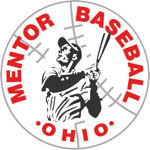
- Concussion Training
- Travel Baseball
- Sponsorship
- Spiritwear Store

Mentor Travel Baseball
Mentor Baseball League’s Travel Program is designed to provide a positive experience for any player capable and interested in an advanced level of play. This brochure is intended to inform the parents about the program, also of the financial and time commitments involved in travel baseball.

- TRAVEL POLICY
- MANDATORY TRAVEL SEASONS
- MAIN SEASON
- HOW MUCH TRAVEL IS INVOLVED???
- PLAYER DISTANCES BY AGE
- LEAGUES WE PARTICIPATE IN
- ELIGIBILITY
Travel baseball is not for all players. Only those players serious enough to make the commitment, should consider trying out for a team. The league is committed to improving the skills of all players to their maximum capability. The league also makes the commitment to the players that they will play if the player/parent lives up to the rules stated by the coaches at the beginning of the season (attending practices, proper attitude, on time for games and practices…) Playing time, and how it is distributed, is decided by the head coach. Playing time is not guaranteed to be fair and equal to all players. In addition circumstances occur that cannot always be anticipated from game to game. For example, games are sometimes shortened due to inclement weather, the mercy rule, or teams being short players etc.). In these circumstances, the parents and players must understand the situation that the team and coach are in. These instances occur on occasion. Although it is the intention of the teams to win the games, winning at all costs is not the leagues mandate. Our philosophy is to build championship caliber players, not necessarily championship teams. Hopefully, by developing the players, the winning will take care of itself. However, because of the attempt to win games, all the players are not guaranteed an equal amount of time. The coaching staff has the prerogative to play the players the number of innings they chose as well as in the position(s) best suited for the players and the team.
A player that makes a team is required to play our “Season” which runs from January through July. They are encouraged, but not required to participate in some off-season workouts to keep their skills up to par. Once a player makes the travel team, he or she cannot be removed from that team until the following year’s tryouts; however, extenuating circumstances may exist, such as extraordinarily bad behavioral on the part of the parent or player, which could facilitate the removal of the player.
This season is mandatory if the player decides to play travel baseball. The “our” season runs from approximately January 1st through mid-July. Teams will be in a travel league that can be 10 to 16 regular season games along with playoffs. We also schedule multiple tournaments that are played on weekends. The number of tournaments are decided by team. Extra tournaments if decided to be played, will be at cost of the individual team. Game days and practice days will depend on the team, league, division entered along with your coach’s availability.
Approximately one-half of the league games are played at our home fields and approximately half are away. Most if not all tournaments will be played away. Depending on the league and team, the away games can be anywhere the team decides to play. The approximate number of games played for the season depends on the team and league the team is in.
- 8 year-olds play on 60 foot bases with a 42 foot pitcher’s mound.
- 9 & 10 year-old teams play on 60 foot bases with a 46 foot pitcher’s mound.
- 11& 12 year old teams play on 70 foot bases with a 50 foot pitcher’s mound.
- 13 year old teams play on 80 foot bases on 54 foot pitcher’s mound.
- 14 & 15 year old teams will play on 90 foot bases and 60′ 6″ pitcher’s mound.
The Mentor Baseball League participates in the following travel leagues:
- Buckeye Baseball League
- Ohio Prospects League
Travel starts with the 8-year-old team (primarily 2nd/3rd graders) but can start as early as 7 years old. When playing in-house baseball, we encourage players to play with their grade (with their classmates), however, given the universal birthday rule; when playing travel baseball, they must play with the team at their AGE.
Age Divisions
The Mentor Baseball League travel teams are designed to take your child to the next level of development. Each year kids from across the league try out for positions on their age groups team. If your child is chosen they will be committed to that team for 1 year. Each team has many responsibilities and each child will have to do their part on the team.
Tryouts usually take place the 2nd week of August. If your child is interested in trying out for travel please contact our Travel Team Coordinator:
Mentor Travel 8U
Mentor travel 9u, mentor travel 10u, mentor travel 11u, mentor travel 12u, mentor travel 13u, mentor travel 14u, mentor travel 16u, indoor facility, mentor baseball indoor practice facility.
8820 EAST AVE.
MENTOR, OH. 44060
All Rights Reserved © 2023 Mentor Baseball League
Travel and All-Stars Program
12u travel roster - 2025, 11u travel roster, 10u travel roster, 9u travel roster, 8u travel roster, spring travel.
Clifton Park Baseball provides an opportunity for players in the 8 through 12 year old divisions to compete against teams from nearby communities through its spring travel program. Players are selected to participate on travel teams after tryouts that are held each fall. Travel baseball requires a high level of commitment and interest from the families and players who participate. Our travel teams practice during the winter months and have at least 2 practices and/or games each during the travel season. In addition, players who participate in travel baseball are required to play in our Spring recreation program.
Summer All-Stars
Clifton Park Baseball offers opportunities for players ages 7 to 12 to continue to playing baseball during the summer at local, regional and even national tournaments. Thanks to the strong commitment of our players and families, we are able to field multiple tournament teams each summer.
Players must participate in Spring Recreation to be eligible for Summer All-Stars.
Summer tournament teams are selected in June. Information on the selection process and time commitment expected from players who participate on our tournament teams will be distributed in May, but if you have questions please contact your child's division director.
Fall Travel
Clifton Park Baseball provides an opportunity for players in the 9 through 12 year old divisions to compete against teams from nearby communities through its fall travel program. Players move up an year in the fall, for example players in the 8 year old division in the spring/summer are considered 9 year olds in the fall. Players must participate in spring travel and/or summer all-stars to be eligible to play fall travel.
The travel and all-star programs are organized and managed by the Vice President of Cal-Ripken and Division Directors.
Page Search
Youth Baseball & T-Ball Leagues For Kids Ages 3 - 14
I9 sports ® offers youth baseball and t-ball leagues for kids ages 3 and up..
Let’s play ball! Starting at age 3, boys and girls in our youth t-ball leagues learn baseball basics and hand-eye coordination as they get used to hitting the ball. As players get older, they progress to a “coach-pitch” format to continue building their baseball skills.
“Our baseball programs offer children the perfect opportunity to develop an understanding of the game as well as work on fundamental skills,” said i9 Sports CEO Brian Sanders. “Baseball doesn’t have to be a pressure-packed sport. Our approach allows your child to develop confidence and learn the game in a supportive setting while having a great time. After all, fun is what baseball is all about!”
In i9 Sports youth baseball leagues, kids learn the fundamentals of the game alongside sportsmanship values like respect and teamwork. Learn more about our co-ed t-ball and baseball leagues below and find a program near you!
T-Ball For Kids Ages 3 - 4
Ready to introduce your child to team sports but you’re not sure which one? An i9 Sports youth t-ball league is a great option even if your little “slugger to be” is a bit timid. Our youth t-ball leagues are designed as an introductory program where boys and girls learn baseball basics in a fun and supportive environment. If kids are anxious about playing , we encourage parents to participate alongside them until they become more at ease. In this way, kids experience being part of a team while learning batting , catching , throwing and fielding a baseball. Since kids at this age are still developing hand-eye coordination, they are taught the proper batting technique by hitting a baseball off a tee. Over the course of the season, youth t-ball players learn the game and gain confidence in their new skills. Soon your child will be ready to move into one of our coach-pitch youth baseball leagues .
T-Ball Fundamentals for Toddlers and Very Young Children
Since kids at this age are still developing hand-eye coordination, they are taught the proper batting technique by hitting a baseball off a tee. Over the course of the season, youth t-ball players learn the game and gain confidence in their new skills.
Find out more about t-ball programs .
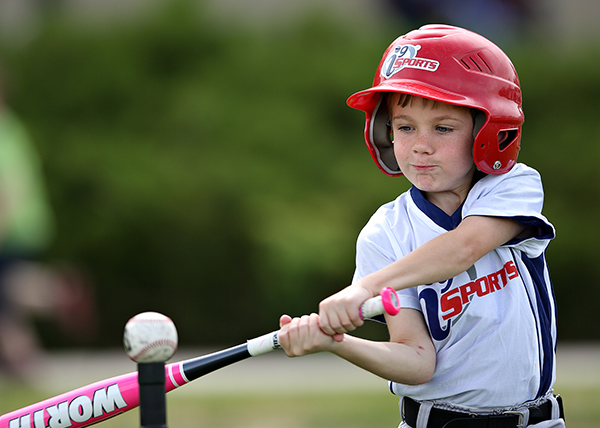
Coach-Pitch Baseball for Kids Ages 5-8
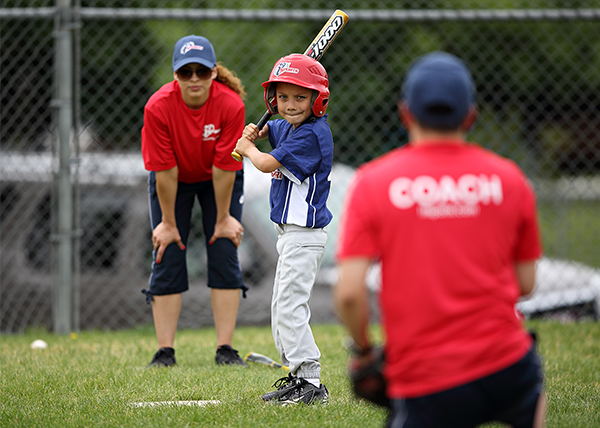
Batter-up! i9 Sports coach-pitch youth baseball leagues are the next step in helping boys and girls become “baseball ready.” At the start of league, coaches reinforce the basic skills of baseball. In our co-ed youth baseball leagues, kids develop a better understanding of the game as they grow to love America’s favorite pastime! Find one of our youth baseball leagues near you!
Coach-Pitch Baseball Fundamentals for 3rd – 6th Graders
Boys and girls are taught the proper way to throw , catch and field a baseball. At this age, your child is developing better hand-eye coordination and is ready to learn how to hit and throw a baseball . While proper batting technique is initially taught by hitting a baseball off a tee, it soon progresses to “soft pitching” by the coach. Getting down on one knee about 5 yards away from home plate, the coach acts as the pitcher by gently throwing the baseball across the plate. The tee is always available for players who need a little more help in developing their batting skill. Once your child moves on to “advanced coach-pitch,” the tee is no longer available and the player is out if unsuccessful after six pitches.
Additional Baseball leagues Available
We provide advanced co-ed baseball leagues in select areas across the country. To find an i9 Sports youth baseball league near you, enter your zip code below.
Find A Program Near You
Improve Your Baseball Performance

Baseball Drills for Youth Players: Coaching and Teaching Baseball to 9, 10, 11, and 12 Year Olds
Coaching baseball to youth players (age 9, 10, 11, and 12 years old) is a tough job and there’s a lot more to it than people often think.
If you’re coaching a team, you’ll need a good understanding of the collective skill level of your team in order to plan and action an effective training schedule.
Similarly, when coaching individual youth players, you’ll need to select drills that are appropriate for honing their personal development.
We’ve put together this guide to assist you in finding the right drills to suit you and your team.
Whether you’re a seasoned coach, a rookie stepping up to help for the first time, or a youth player looking for advice, this guide will help freshen up your practice sessions and keep them fun and relevant.
Ideally, by the time your squad has entered youth level, they should have a firm grasp of the fundamentals – that is to say, throwing, catching, hitting , fielding , pitching as well as a rudimentary understanding of the rules of the game. It’s important not to overlook these skills and see them as done and dusted as they can always improve and your training sessions should be planned with development of the fundamental skills in mind.
Here are the age groups we’ll be covering,,,

At 9 years old it’s about successfully merging what they already know but progressing these drills appropriately slowly increasing the complexity of the drills.

10 years old brings a whole different dimension to your training. Here’s where you’ll really start add more complex skill based concepts & strategies to your practice sessions

At 11 year old you can now see the stronger athletes from the group and plan for these changes in physical development

When your players reach 12 years old , you’ll likely have a bunch of die-hard baseball players.
Just Wanna Get to Practice: Youth Baseball Drills Quick-Start Guide:
- Step #1 : Pick age group you’re training – we start at 9 and progressively increase the difficulty to age 12
- Step #2 : Pick 1-3 drills depending on the length of your training, and make 1-3 progressions for each one
- Step #3 : Screenshot or make notes and head to practice – you’re ready to get going!
Baseball Drills for Youth Players: 9u, 10u, 11u and 12u
Now that you’re armed with our top coaching tips for youth players, let’s take a look at some of the most effective drills for developing each age group.
Remember, these drills don’t need to be used exclusively by one age group or in any order.
Feel free to use them in a way that best suits the ability of your youth players to help develop their game as effectively as possible.
I’ve categorized them by ‘suitability’ for each age group.
Youth Baseball Drills for 9 Year Olds: Hitting Practice Drills For 9u
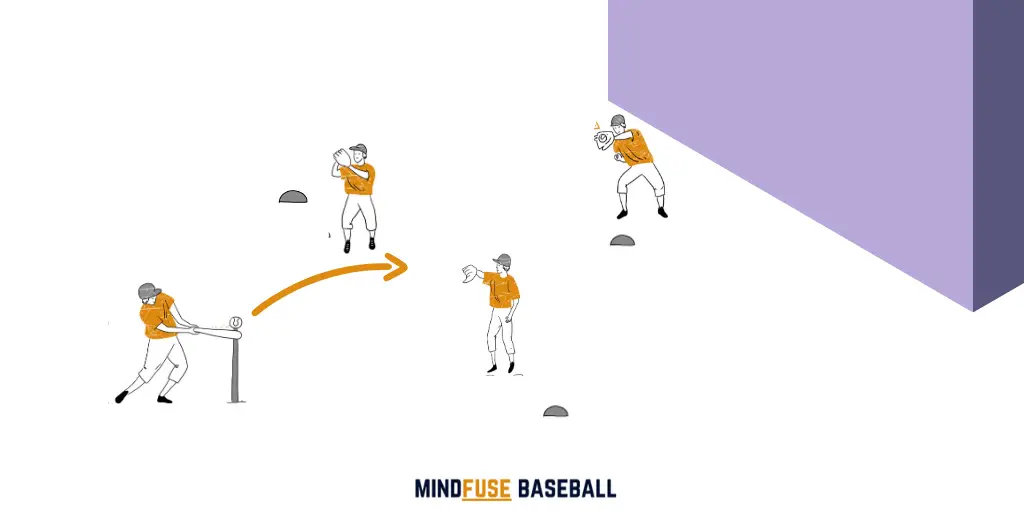
Beat The Goalie
Objective : Beat the goalie aims to improve the accuracy of a player’s hitting while simultaneously improving fielding skills of others.
It’s less of a drill and more of a mini-game using a batting tee and a fence or wall – making it a great choice for younger players.
It will have them developing without even realizing that they’re learning. It’s a clever drill that doesn’t need too much set-up and practically runs itself.
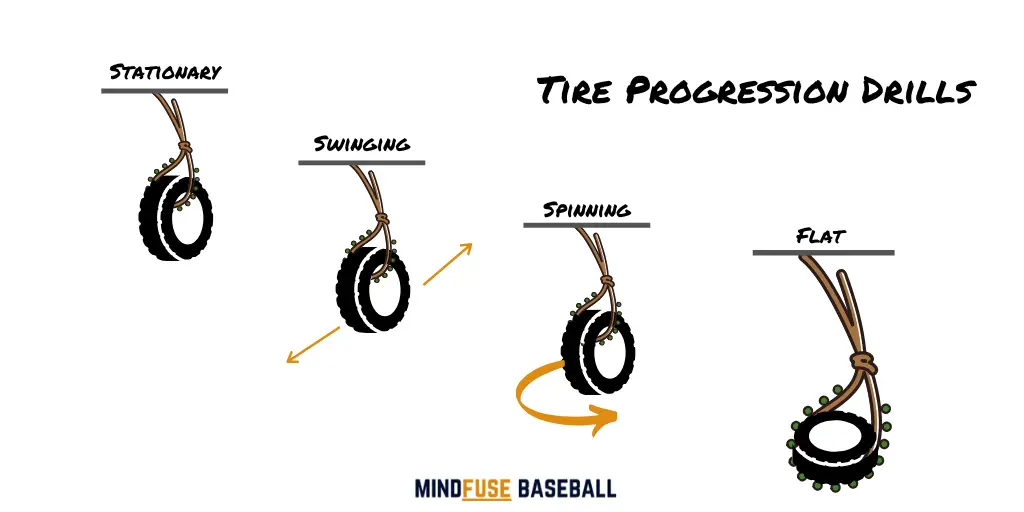
Tire Progression
Objective : The idea of this drill is to improve swing technique and accuracy with a tyre suspended on a length of rope as the target.
It’s a great hitting drill for younger youth players as it allows them to develop their movement and timing without the pressure of having to continually hit a ball.
A larger target is ideal for this very reason. The progressive nature of this drill also makes it fun and technical.
Home Hitting Drills
Objective : The idea of this drill is to improve swing technique and accuracy with a tire suspended on a length of rope as the target.
No Equipment Hitting Drills
Objective : To improve swing technique with a variety of dry swings. These drills without equipment also involve visualization which improves mentality heading into a game.
Dry swings work as a great drill for youngsters to help improve posture, technique and special awareness. They also work as a great warm up so they’re good to use early on in your training session or before a match.
Fielding Drills For 9 Year Old’s

Get In Front
Objective : This drill aims to improve catching, body position and balance as well as bravery in catching.
One player stands on a raised platform such as a chair, stool or a bucket to receive catches. This means that they have to focus on balance and catching technique and prevents them from shying away from the ball making it a superb training tool for younger youth players who’s fear of the ball is affecting their body position when receiving balls.
![travel baseball for 10 year olds Ready. Aim. Throw. Baseball Drill [MindFuseBaseball.com]](https://mindfusebaseball.com/wp-content/uploads/2020/04/Ready.-Aim.-Throw-Baseball-Drill.png)
Ready Aim Throw
Objective : This is a fun exercise, especially for younger age groups to aid in developing pitching and throwing accuracy.
The idea of the drill is to knock a stationary ball off a batting tee by pitching another ball at it. It’s great target practice and can be adapted as a circle game to help improve catching and reactions for the players without the ball.
![travel baseball for 10 year olds Baseball Drills for Kids: Catch Chain [MindfuseBaseball.com]](https://mindfusebaseball.com/wp-content/uploads/2020/04/Baseball-Drills-for-Kids_-Catch-Chain.png)
Catch Chain
Objective : The aim of catch chain is to improve catching, throwing technique, throwing distance and teamwork.
The drill is normally worked out in pairs. Two players link up a ‘chain’ of throws and catches and see how many they can get. Every successful catch results in the players taking a pace backwards to increase the distance between them, forcing longer throws. It’s a nice drill for younger age groups as it has a competitive edge. It can be used as a warm up with older groups.
Pitching Drills For 9 Year Old’s
![travel baseball for 10 year olds Push Off Drill: Baseball Pitching Drills [MindfuseBaseball.com]](https://mindfusebaseball.com/wp-content/uploads/2020/06/Push-Off-Drill.png)
Push Off Drill
Objective: This drill is handy for developing a player’s balance and weight distribution at the plate.
It’s a fairly simple drill which can be adapted in a number of ways or combined with other drills, or even used in practice matches. There are also a few more complex versions of this drill for older players that we’ll come onto.

Leading The Pitch
Objective: To coach balance, weight distribution and pitching technique.
This drill involves lining your pitcher up against a wall so that they have a marker with which to measure their body movements against. The drill actively encourages the correct method of pitching – to lead with the butt.
![travel baseball for 10 year olds Towel Pitching Drill: Baseball Pitching Drills [MindfuseBaseball.com]](https://mindfusebaseball.com/wp-content/uploads/2020/06/Towel-Pitching-Drill.png)
Target Towel Drill
Objective: The idea of the target towel drill is to re-enact the movements involved in pitching without the ball. It develops a player’s pitching technique.
By using a towel as a replacement for your baseball, you’ll be able to focus better on the individual body movements and subtler parts involved in a good pitch. It’s a great way to encourage follow through on every pitch.
Baseball Drills for 10 Year Olds: Hitting Practice Drills for 10u

Band Assisted Drill
Objective: To improve posture and encourage correct weight distribution when hitting.
Using a gym band, tied to a fence or a post, placed around your hitter’s waist, practice swinging. The band will actively encourage your hitter to stay in the correct position. You can begin with dry swings and progress to a batting tee and eventually live balls.
Stride Drills
Objective: This drill is about training your stride when hitting. It will allow players to actively load their stride and improve hitting power.
The drill involves a batting tee and involves adjusting the hitter’s stride in order to calculate where the loaded front foot should be landing during the swing. Check out the YouTube video for detailed instruction.
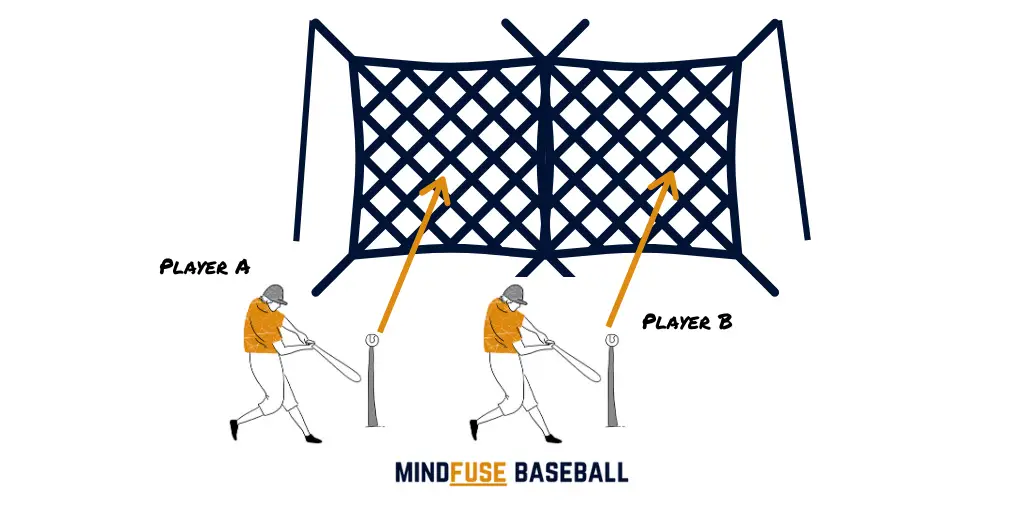
Double Trouble
Objective: This is a fun drill which aims to improve hitting power and accuracy as well as reaction speed. It involves two players, two tees and a hitting net.
Two players must line up at their respective tees (always at a safe distance) and another player or the coach will shout a trigger word to signal that the players should hit the ball. The first to hit the net wins.
Fielding Drills For 10 Year Old’s
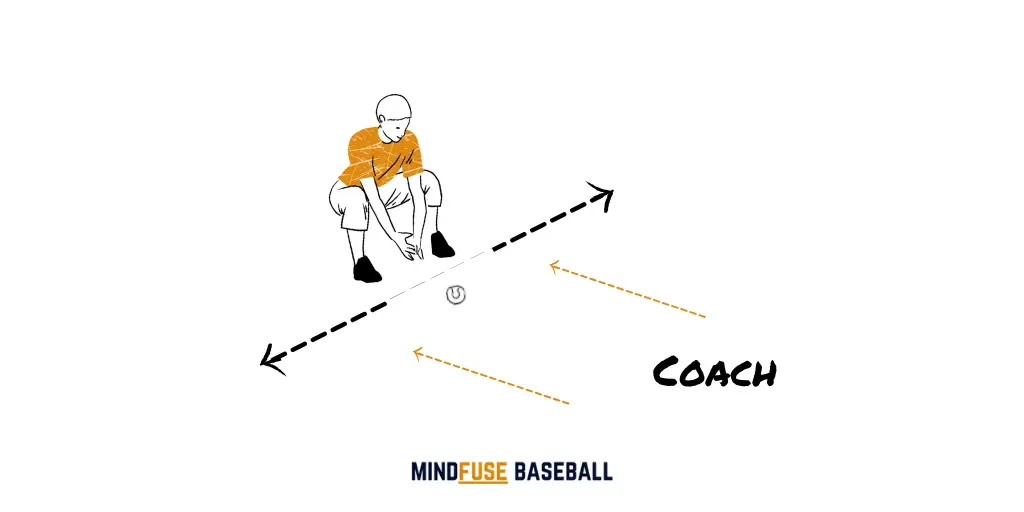
Coach Rolls To Pick Ups
Objective: This drill aims to improve fielding technique for grounders and develop lower back conditioning and increase stamina.
A coach or another player will roll balls to either side of a fielder who has to react accordingly. Balls can be rolled to either side or down the centre. This drill can be adapted by introducing a second ball or increasing the distance between the player and coach.

Triangle Target Throws
Objective: The aim of this drill is to improve your fielders’ ability to make accurate throws over a longer distance.
The coach (or a 3rd player) hits a ground or fly ball towards the thrower using a fungo bat . The drill uses a stationary player as a target. This player should be placed somewhere between 20-30 yards away from fielders who will try to accurately throw to the target. If training alone, use a hitting or rebounder net or alternatively a bucket as the target.
Objective: To improve speed and reaction times when fielding. This is a great drill for pairs and has lots of potential for progression.
Two players have to stand a small distance apart. One player has a ball which they will bounce for their partner who has to catch the ball before it hits the floor. You can adapt the drill by adding an extra ball, having the catcher stand with his back to his partner before the ball is dropped, or by rebounding the ball(s) off a wall.
Pitching Drills For 10 Year Old’s
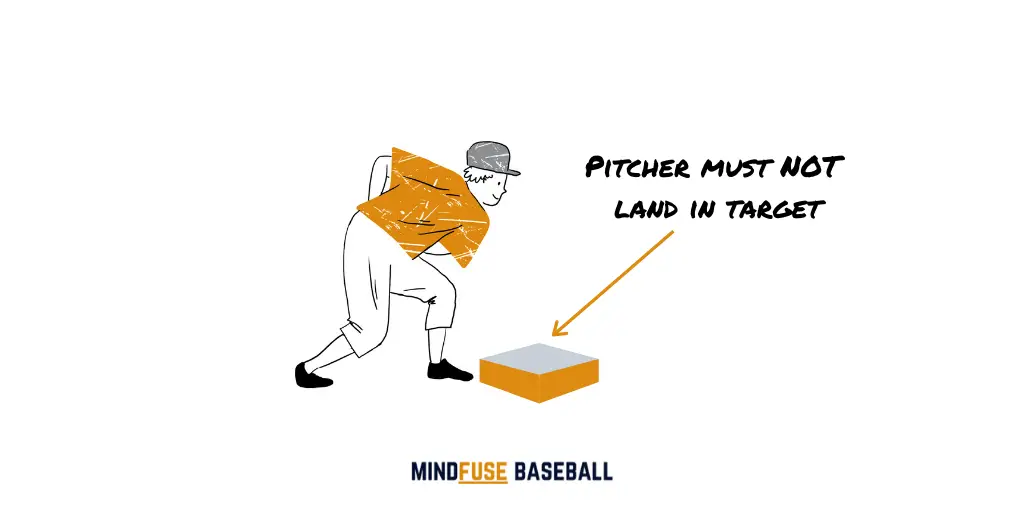
Pitching Stride Drill
Objective: The whole idea of the pitching stride drill is to reduce the chance of over-stride occurring. The drill encourages players to take a calculated stride in their pitch.
By using an obstacle on the floor, you will encourage your player to pitch without their leading foot going beyond the obstacle. The obstacle can be a mat, pad, rope or even a towel. It’s a good idea to start without a ball and just practice the movements before introducing the obstacle to actual pitches.
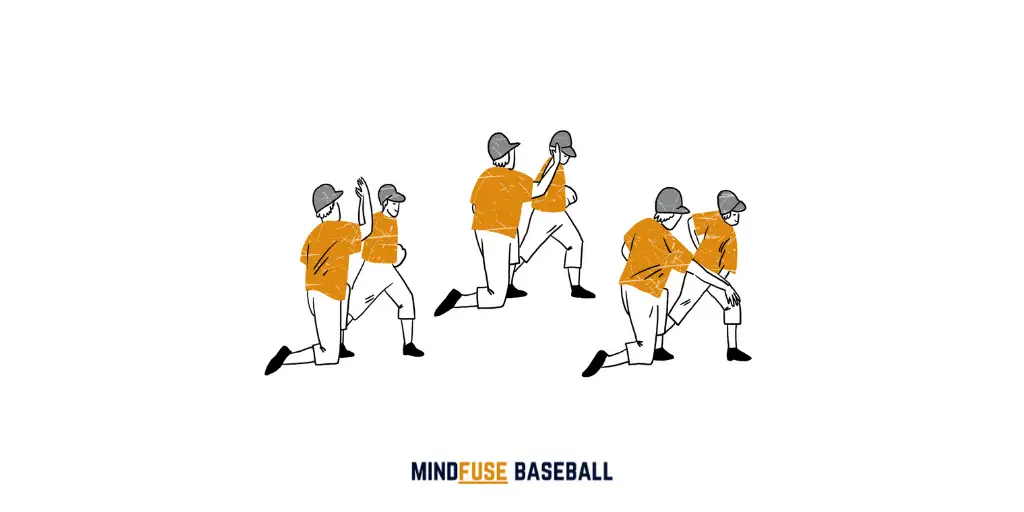
High-Five Pitching Drill
Objective: This is a fun drill that can be used anywhere on the field to encourage correct follow-through.
The coach will use his hand in a high five position to create resistance for the pitcher to combat with his pitching arm. This will encourage correct pitching technique, solid follow-through and will develop strength. It also reduces the risk of injury through improper technique which makes it ideal for younger players.
NOTE : This drill should be introduced at an earlier age but it’s also a good idea to revisit the fundamentals from time to time.

Objective: This drill is all about encouraging correct weight transfer when pitching. It will teach your players how to correctly release energy through their whole body and improve pitching power in a safe way as it reduces the risk of injury through improper technique.
By adopting the ‘T’ shape when opening up the body to pitch, your player will be able to correctly transfer body weight by pitching and finishing with their chest over their leading leg.
Baseball Drills for 11 Year Olds: Hitting Practice Drills for 11u
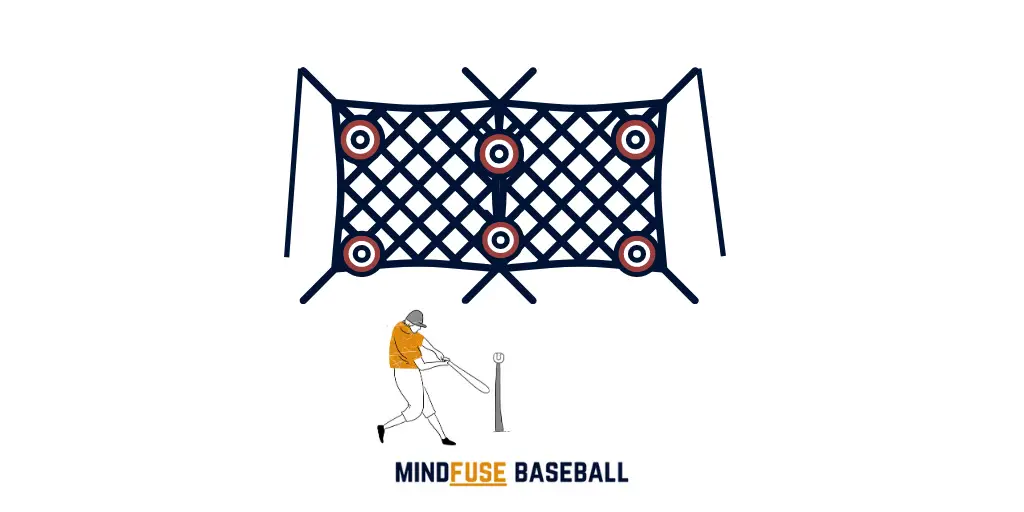
Hitting H.O.R.S.E
Objective: This is a classic drill which aims to improve a batter’s ability to hit specific and individual targets, making them more effective at aiming at a certain spot during matches.
To setup this drill will need a net big enough to attach targets. Each player must hit a selected target before moving onto the next one. If they miss a target they will receive the penalty of the letter ‘H’ and then ‘O’ and so on. When the full word is spelled out, that player is eliminated from the game.
One Handed Hit
Objective: Using this drill, you’ll be able to improve the overall power and accuracy of a player’s swing.
Hitting off a tee with just one hand on the bat will prove difficult as the player is going to have the handicap of only one arm. After a few variations of one-handed hitting, the second hand can be reintroduced and hitting will seem much, much easier and should be more effective.

Objective: With this one, the clue’s in the name. The drill aims to increase your batter’s ability to aim for power.
You’ll need a bigger ball such as a basketball or a soccer ball and a batting tee. It’s fairly simple, place the big ball on your tee and encourage your hitter to really exert a lot of power in their swing. It’s really important to make sure this is done safely by encouraging good follow through and correct technique to avoid injury. Slightly older youth players will love this drill.
Fielding Drills For 11 Year Old’s
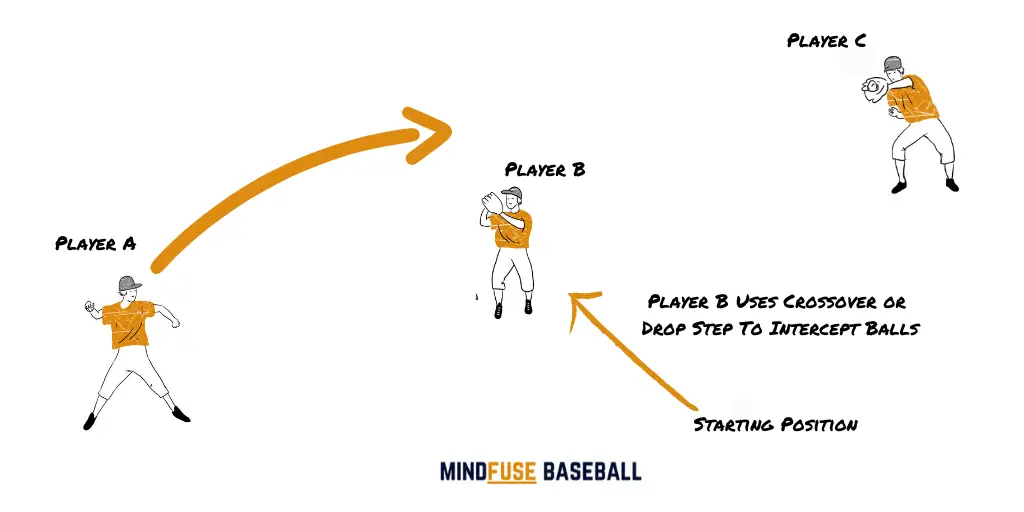
Objective: This drill is all about developing your players’ ability to defend against line-drives. It will actively encourage your fielders to use a crossover step when attempting to make catches.
This mini-game style drill will require three players – two throwers (let’s call them player A and player B) and an interceptor. Player A must throw a line ball to player B, who will be standing around 50 yards away. The interceptor must catch the ball before it hits the ground by using a crossover step.
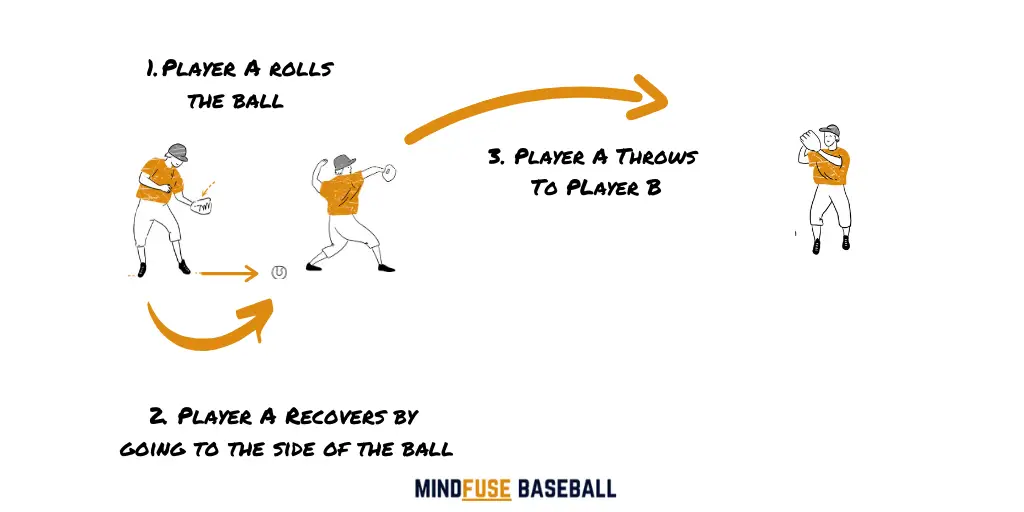
Objective: The recovery drill allows your team to successfully recover from a mistake, a bad bounce or a fielding error. Encourages calm and accurate throws.
This involves three players – one to roll a ball (manipulating a bad ball or an error), one to scoop the ball side on and throw it to a catcher. Alternate the positions and roles of each player so that they get an even chance to practice every aspect of the drill.
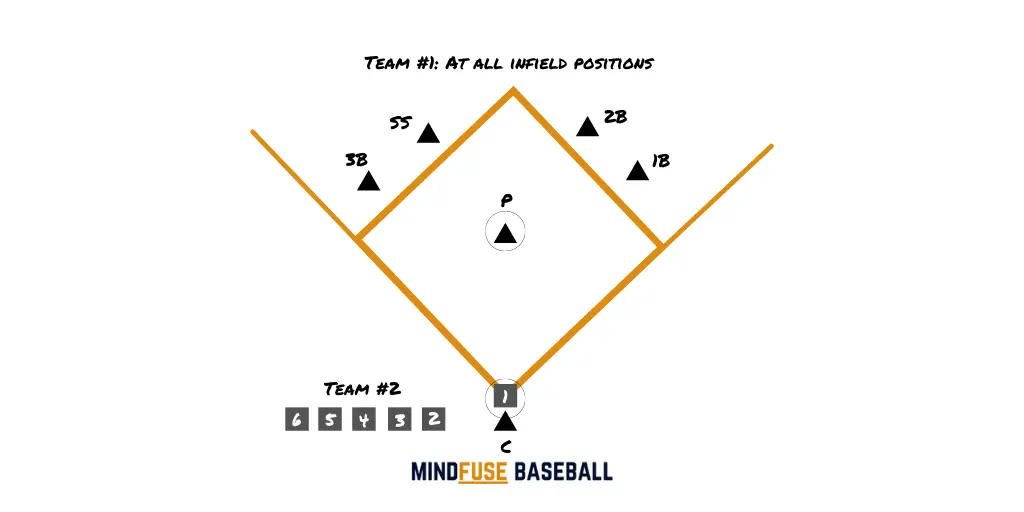
Grounder T-Ball
Objective: This team game will improve your players’ ability to successfully react to and deal with ground balls. It will also work as a hitting drill at the same time. Divide your team into two teams – a hitting team and a fielding team. The fielding team will be positioned infield ready with their gloves on-hand . while the batting team will take it in turns to hit grounders. If a line drive or fly ball is hit it doesn’t count, and the outfield is out of bounds – this drill is all about defending against grounders. The batting team is awarded a point if their grounder successfully makes it through the infield. The fielding team is awarded a point is they successfully defend the ball.
Pitching Drills For 11 Year Old’s
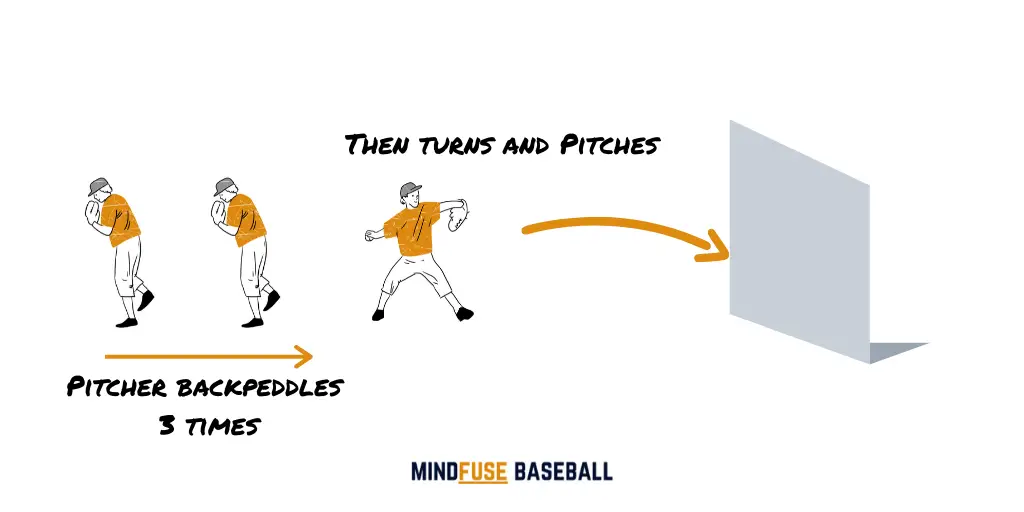
3-Step Backpeddle
Objective: This drill encourages pitchers to not open up too much or too early on their pitch. It also helps reduce the chance of over-rotation.
You’ll need a target like a net or a wall and your pitcher will have to backpeddle three times before aiming their pitch at the target. Use a ‘wall’ that absorbes the impact. Using weighted training balls can also be a great alternative progression.

One Knee Drill
Objective: The one knee drill is a development on the towel drill, making it a great progressive drill as players move into older age groups. The drill aims to improve the pitcher’s arm angle and weight transfer.
On one knee, the pitcher must practice throwing accurately with proper technique and good follow-through to their partner or against a wall or net if training individually.
Baseball Drills for 12 Year Old’s: Hitting Practice Drills for 12u
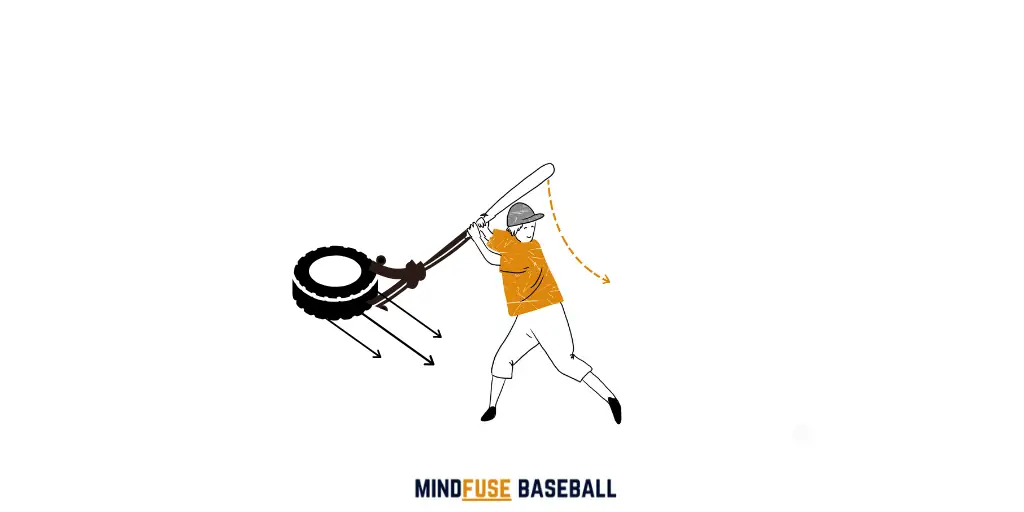
Objective: This is a much more advanced variation of the dry swing drill. The drill aims to improve technique and power output.
By attaching some form of sled to your hitter’s bat (think of a weight such as tyre), you’ll be able place resistance on the bat making it more difficult for the player to swing. If they can swing well with the added pressure, their normal swing will become more effective.
Bryce Harper Drill
Objective: This drill will encourage your players to activate their hips when swinging allowing them to have a wider range of hits in their toolbox.
By raising their lead foot when receiving a pitch, your player will naturally use their hips more effectively in their swing.
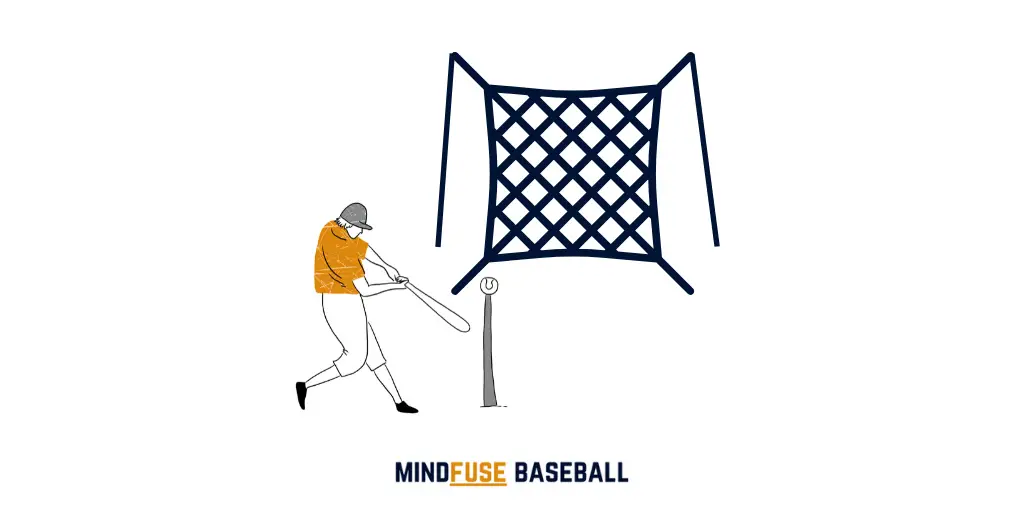
Hitting Net Drills
Objective: This style of drill is essentially a lot like hitting H.OR.S.E, however they’re much more suited to individuals and encourage older youth players to train their hitting technique independently.
Using a hitting net and a batting tee , players can adjust their swing to aim at different parts of the net. Progress by using a target strike zone .
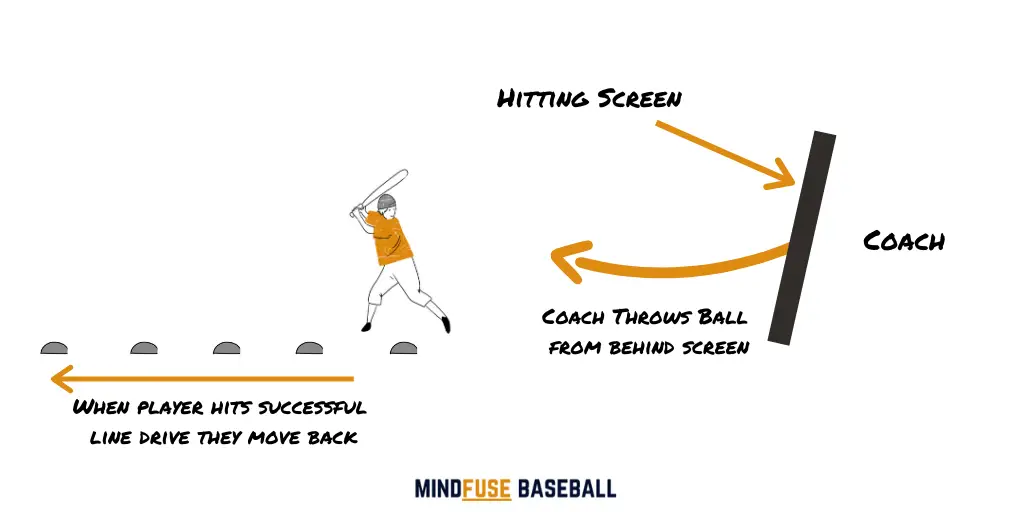
Hitting Chain
Objective: This hitting game is great to get your batters focussed on hitting successfully and consistently.
To set this drill up you’ll need a hitting screen and some markers. Balls are pitched from behind the screen and each time the batter makes a successful hit they will be able to progress to the next marker which is placed slightly further away. If they miss, they’ll need to move back to the previous marker.
![travel baseball for 10 year olds Baseball Drills for Kids: Target Hit [MindfuseBaseball.com]](https://mindfusebaseball.com/wp-content/uploads/2020/04/Baseball-Drills-for-Kids_-Target-Hit.png)
Objective: This drill is all about improving accuracy. When youngsters start out, they tend to swing with the sole aim of hitting the ball. As they develop and get older, they need to develop their accuracy in order to exploit weak spots in the opposition’s field.
Place a number of targets around the field for your hitter to aim at. These can be cones, hoops or buckets and the drill can be advanced by moving them further away. This drill can be done with a tee or with a live pitcher.
Fielding Drills For 12 Year Old’s
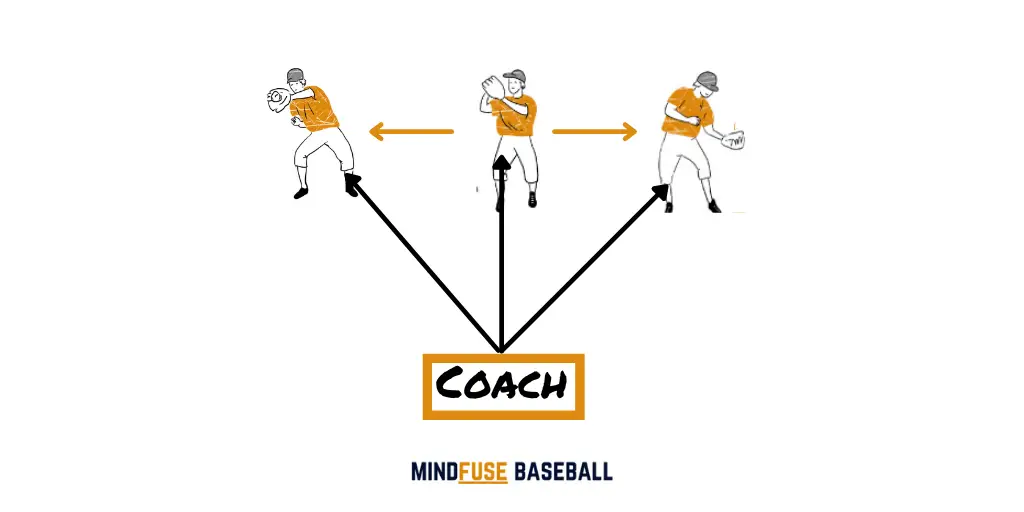
Left or Right?
Objective: The purpose of this drill is to improve reaction speed and encourage two-handed fielding.
The coach, or another player will throw a ball to the right, which a player has to respond to before returning horizontally to their starting position. The coach will then throw the ball to the left for the player to deal with. Repeat this 10-15 times before taking a break. Make sure you vary the throws, and the directions for added game-realism.
3 Infield Drills
Objective: Improve infielders technique and game with limited equipment
One limitation you may have when training is having access to the right equipment. While you can find various pieces of equipment in each category for most budgets – sometimes there comes a time when you need to just get down to work and you haven’t got access to the equipment you’d like.
Pitching Drills For 12 Year Old’s
Velocity Drills
Objective: These drills are a great means to develop the speed of your pitch. As youth players get older, they gain more strength and these drills will help them harness it safely with the correct techniques.
Individual Pitching Drills to Practice at Home
Objective: If you’re looking to train alone at home without going anywhere, these drills are brilliant for adapting and developing your pitching with little equipment from the comfort of your home.
Baseball Youth Conditioning Drills
![travel baseball for 10 year olds Baseball Conditioning Drills: Exercise diagram of someone doing Overhead medicine ball throws [MindfuseBaseball.com]](https://mindfusebaseball.com/wp-content/uploads/2020/06/Overhead-Medicine-Ball-Slams-Over-Head-Squat-Throws.png)
Medicine Ball Drills
Objective: Develop core strength necessary for increasing swing and throwing power.
A combination of rotational throws, overhead slams and overhead squat throws are great for helping develop your players’ strength. Be sure not to introduce medicine ball workouts to younger players as their bodies may not be prepared for it.
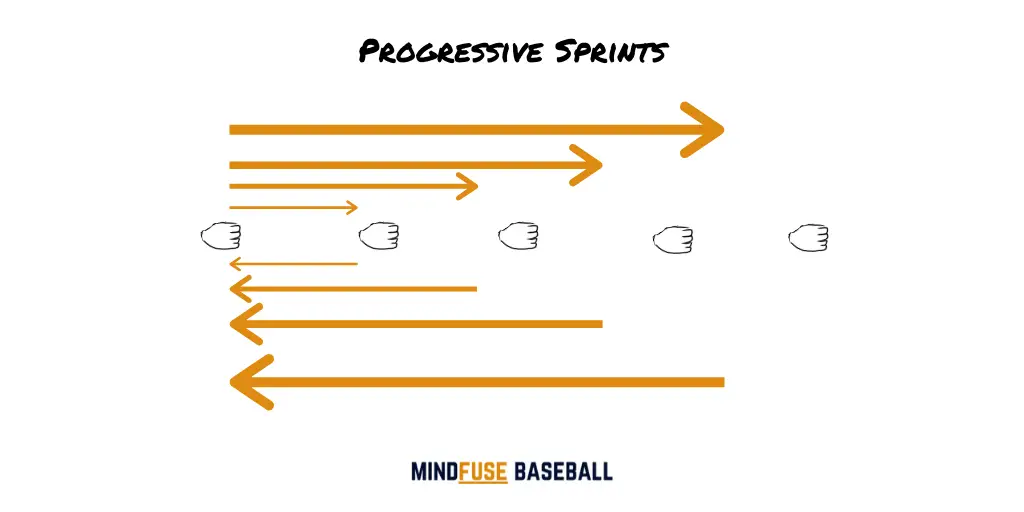
Progressive Sprints
Objective: Very often in baseball, short but powerful releases of speed are needed. Progressive Sprints are the perfect method of preparing your players for this.
Take five baseball mitts and place them in a line with increasing distances between them. Have your players sprint to the first mit before making their way back gently to the start position before sprinting to the second marker and so on until the drill is complete
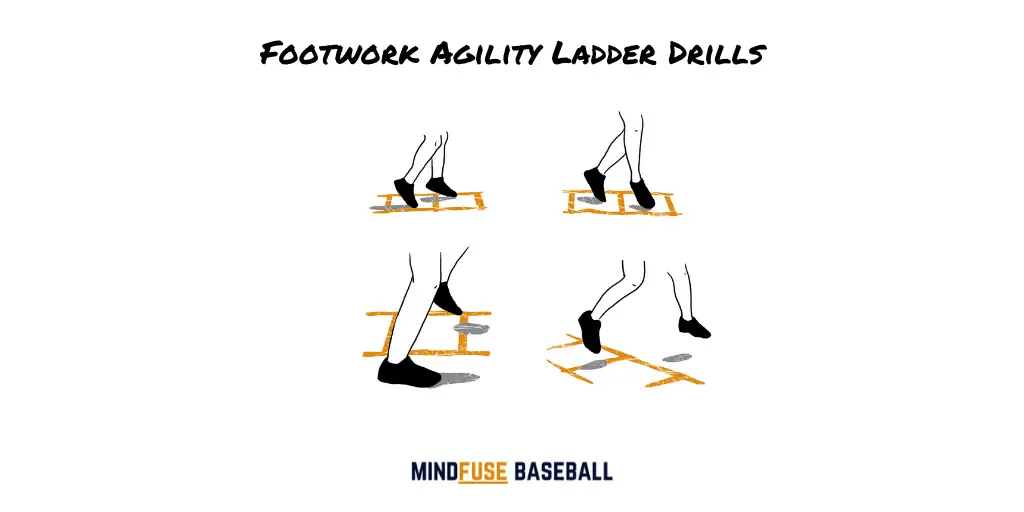
Footwork Ladder Drills
Objective: This drill is perfect for developing agility, speed and reactions. It’s also great for developing concentration.
Using your ladder on the floor, you’ll be able to create a varied training drill for your players. This can be used at any stage of your training session and mixed up as is necessary. It’s also a nice pre-match exercise to get your players brains in gear and their feet warmed up.
You can check out our baseball conditioning drills guide for more ideas…
Tips When Coaching Youth Players
First, let’s establish what constitutes a ‘youth player’.
This guide has been made for players aged 9 to 12 years old, but players often develop quicker than their age group or alternatively, join the game later on, so these drills can be used for different ages and abilities accordingly.
Here’s some of our top tips to help you when coaching your youth players:
- Keep your training sessions fun – the best learning often occurs when you don’t even realize it. If your players feel like they’re being constantly drilled and worked, they’re not as likely to respond to coaching and feedback. That’s why it’s important to bring a bit of your personality into your sessions, especially with younger players. Break up your training sessions with mini-games relevant to the specific skill or technique that you’re working on.
- Mix it up – Try to avoid too much repetition, especially if it’s not getting results. Coaching is all about positivity and if a drill isn’t proving productive, it’s a good idea to abandon it and come back to it later with a new, fresh outlook, otherwise you’ll be at risk of reinforcing bad technique in the long term.
- Be creative – you don’t always have to rely on the tried and tested methods. Sure these drills are great and they work, but there’s nothing stopping you from inventing something new. If the players enjoy it and learn something from it, then great! After all, nothing ventured means nothing gained.
- Know your squad – If you’ve got one or two individuals who can perform a certain skill with their eyes closed while the rest of the squad are a bit behind, try to find something to keep them occupied and challenged while the others train their skill. You can also utilize them for demonstrations and peer coaching.
- Use positive reinforcement – Where possible, avoid giving negative feedback. If someone is performing at the level that you want, try to work out why without telling them the things that they are doing badly. With youth players, it’s incredibly important to focus on the positives and try to develop their ability without putting them down.
- Similarly, don’t be afraid to end a drill early if your players a performing well. For example, if you’re practicing catching and someone makes five or six tricky catches in a row with ten minutes left of practice, end it there and move onto something new instead of risking them losing their form. This way, they’ll end the drill with a positive memory which will help reinforce the skill for next time out
- Play games – it’s so important to put your coaching drills into a competitive context. This allows you to see and track improvement and provides a good outlet for the players at the end of the training session whilst giving them match experience in time for their next fixture. It doesn’t need to be a full game, you can always adapt certain rules and create smaller boundaries to suit the time that you have available.
Coaching Youth Baseball: Do’s & Don’ts
Best Bat for 10 Year Old

For the 2023 season, we think the best new bats for a 10-year-old, regardless of price, are the drop 10 USSSA Marucci CAT X Composite 30/20 or 29/19. Check the Easton ADV 360 drop 11 or 10 in a 30/19 if you need to go USA for a 10-year-old. We also like the DeMarini as the best bat for a 10-year-old fastpitch player. For the budget-conscious, our hitters like the Marucci F5.
We’ve hit just about every bat between 2023 and 2018. Youth USSSA, USA, and fastpitch bat, you name it, we’ve hit it. We collect the data, which drives our list of best bats for 10-year-olds. For 10-year-olds (and any age, for that matter), we’ve found that getting the proper bat size is more important than getting the *best* bat model. A poorly fitted-bat is the death of a promising hitting season. Here are our favorite bats for a 10-year-old.
Our most recent update added our 2023 selections and confirmed the bat deals for our cheap and older bats are still atleast somewhat available in the market.
Best Bat for 10 Year Old Write Ups
What is the right bat size.
The right bat size is more important than the right bat model. At 10, nothing could be worse than trying to hit a ball with a bat that is too heavy except for doing it with a bat that is too light. Bats without enough swing weight will wring the hands more often and won’t produce enough power to be useful. Bats that are too heavy won’t give players enough time to catch up to the pitch.
For 2021 most of the bats are already released. We do not expect any new bats to hit the shelves until later in July when the Little League World Series gets under way.
Let's Be Friends!
Just Bat Reviews, LLC DBA Bat Digest participate in affiliate marketing programs including but not limited to Amazon and eBay. We most likely earn a comission from companies we link to on this site.
© 2024. Just Bat Reviews, LLC DBA Bat Digest Company.
JavaScript seems to be disabled in your browser. For the best experience on our site, be sure to turn on Javascript in your browser.
- Expert Advice
- The Dugout: Baseball and Softball Pro Tips
- Baseball Gear Guides
Best Baseball Gloves for 10-Year-Olds
At the age of 10, a player embarks on some of the most crucial years of their baseball journey. These formative times shape their love for the game, and having the right equipment can foster a passion that lasts for years. A well-suited baseball glove can profoundly impact both performance and enjoyment on the field. With a multitude of choices available, navigating the selection process might feel overwhelming. It's vital to consider factors like size, material, and durability to make an informed decision. A properly fitted glove not only enhances comfort and confidence but also aids in skill development, efficient fielding, and injury prevention. This guide aims to simplify the selection process by providing step-by-step instructions on choosing the perfect glove for your young player. Additionally, expert recommendations will help you narrow down options, ensuring you find the ideal glove that matches your child's needs and preferences. Explore our full range of youth baseball gloves to discover the perfect fit for your aspiring athlete.
In this article, we will cover:
Understanding the Importance of a Proper Fit for 10-Year-Olds
Different types of baseball gloves suited for 10-year-olds, how to choose the right baseball glove for a 10-year old, care and maintenance of baseball gloves for 10-year-olds, frequently asked questions.
The correct glove size is vital for young players' comfort, control, and confidence on the field. Most importantly, size has the greatest impact on a player’s safety and overall enjoyment. A glove that is too small can cause injury to the hand and fingers. A glove that is too big can cause injury to the wrist as the glove snaps backward. A properly fitting glove enhances a player's catching, fielding, and throwing abilities. This improved control fosters confidence, allowing young players to approach the game with enthusiasm and perform at their best without hesitation.
When sizing a glove for your child, consult this chart to ensure you get a size that will allow your child to be successful on the field. When getting your new glove, ensure it fits snuggly on the hand, without being too tight on the fingers and wrist. Also, make sure that the glove is not too long or heavy to hinder the player when they are running or making plays.
Now that you know what size glove to get, head over to shop our youth baseball gloves and find your next glove! If you would like to learn more about glove size, consider looking at How to Size a Baseball Glove for a Kid.
Infield Gloves/Outfield Gloves
In the early ages of youth baseball, many players play multiple positions so infield and outfield-specific gloves are not required. Therefore, there are no youth outfield-specific models as players use the same glove in the infield and outfield. Manufacturers make these gloves with specific features making them perfect for young hands. On youth gloves, the priority is lightweight, ease of break-in, and comfort. For extremely young players, gloves often feature the basket weave web. This web is one of the easiest to close because of the flexibility within the web design. This is also one of the most secure webs, not having any openings for the ball to go through. These make it great for baseball players just starting their playing journey. Once players get a little older, youth gloves are available in a variety of web designs such as I-webs and H-webs. These are the most common web types and are named after the strips of leather that form the shape of an I and an H on the back of the web. For more information on the different web types, consult our Baseball Glove Buying Guide.
Catcher’s Mitts
Youth catcher's gloves, also known as mitts are the most specialized gloves on the baseball field. They differ from regular fielder’s gloves in several ways. For example, they are measured by their circumference, whereas all other gloves are measured by length. A catcher's glove is typically 31 to 34 inches. For sizing information, view our Baseball Glove Size Guide. Catcher's gloves are also heavily padded, especially on the thumb and palm area to absorb the impact of high-velocity pitches and protect the catcher's hand during the game. They also have closed webbing with a deep pocket to ensure the ball stays secure at all times. Youth models often feature a velcro strap to make them adjustable to different-sized hands. To view our complete selection of youth catcher’s gloves, click here .
First-Base Gloves
Youth first base gloves are for young players who want the advantages of a specific first base glove but might not be at the age or skill level for an adult first base glove. Youth first-base gloves have a similar design to their adult counterparts while still retaining the defining characteristics of youth gloves. This allows the youth player to excel at the first base position. Like an adult first base glove, the smaller youth version has a continuous round edge to improve the chances of scooping balls thrown in the dirt. This rounded edge serves as a funnel, guiding any off-target throws directly into the glove's webbing. These gloves have extra padding to protect the hand from the sting of hard-thrown balls. Youth first base gloves are typically 11 to 12 inches long. Baseball Monkey is proud to offer a wide variety of youth first-base gloves. You can shop them all by clicking here.
When sizing a glove for your child, consult this chart to ensure you get a size that will allow your child to be successful on the field. When getting your new glove, ensure it fits snuggly on the hand, without being too tight on the fingers and wrist. Also, make sure that the glove is not too long or heavy to hinder the player when they are running or making plays.
Now that you know what size glove to get, head over to shop our youth baseball gloves and find your next glove! If you would like to learn more about glove size, consider looking at How to Size a Baseball Glove for a Kid .
Fit and Comfort
When fitting your child for a glove, pay attention to how loose or tight it is on the hand and wrist. A glove that is too tight can cause injury to the hand when catching the ball. Similarly, a glove that is too big or too long can cause injury to the wrist as the glove snaps back when catching. The glove should be comfortable for the player. Choosing a glove with an adjustable wrist strap can be a great option for younger players. For more information on proper sizing, consult our Baseball Glove Size Chart.
Material and Durability
On youth gloves, the priority is on lightweight, ease of break-in, and comfort. Therefore manufacturers forgo the heavy leather found on adult gloves and instead opt for lightweight leather and synthetic materials. For leather, most youth gloves are cowhide which is lightweight, performs well, and is often “pre-oiled” to reduce break-in time. As players mature and develop their skills, the velocities of throws and hits increase. It can be helpful to have a stronger and more durable glove to keep players safe and successful on the field.
Brand and Price Considerations
We are proud to offer the best brands of youth gloves at BaseballMonkey. Brands like All-Star, Franklin, Mizuno, and Rawlings have been trusted for their quality and craftsmanship for decades. Here are some of the top youth glove offerings from the top brands. You can view our complete youth glove selection here.
Best Overall
Rawlings Select Pro Lite Arenado RSPL110NA 11" Youth Baseball Glove - 2024 Model
This glove is constructed from durable leather hides, picked to be strong, yet durable. The Select Pro Lite gloves offer youth players the same glove styling and features as their favorite pros. This one is the 11” Pro-200 pattern used by Nolan Arenado. The Youth Pro Taper Fit conforms to smaller hands and wrists making developing glove control easier for young players.
Best Budget Friendly
Rawlings Sure Catch SC100JD 10" Baseball Glove - 2023 Model
The Rawlings Sure Catch series features an all-leather construction, with Sure-Catch technology that is specifically designed for the young athlete. Sure Catch gloves feature an adjustable molded wrist closure for a custom fit and a NEO-Flex hand opening for easy close. Rawlings has included a palm pad for extra player protection and pro style webs for a professional look.
Best Premium
Rawlings R9 Series R9110U-19BT 11" Baseball Glove - 2023 Model
Features soft tumbled full-grain leather for an easier break-in and durability, along with pro-style patterns that are seen throughout the MLB. It also has padded thumb loops, reinforced palm pads, and leather laces for durability.
Best First-Base
Rawlings Renegade R115FBM 11.5" Youth Baseball First Base Mitt - 2019 Model
Features a single post web, which gives it a snug and secure pocket. Game-ready Right off the shelf, the Renegade Series delivers quality at an affordable price. Equipped with a full-grain leather shell for durability and shape retention.
Best Catcher’s
All-Star Future Star 31.5" Youth Baseball Catcher's Mitt
Lightweight and easy to break in, this glove is constructed from dual-stitched durable leather, and reinforced with All-Star's Pro Guard Padding, this glove is light and easy to manipulate, without sacrificing protection or durability
Here is a quick list of how to care for and maintain your new glove. For more detailed information, consult our Glove Care Complete Guide.
Material Quality On youth gloves, the priority is on lightweight, ease of break-in, and comfort. Therefore manufacturers forgo the heavy leather found on adult gloves and instead opt for lightweight leather and synthetic materials. For leather, most youth gloves are cowhide which is lightweight, performs well, and is often “pre-oiled” to reduce break-in time. As players mature and develop their skills, the velocities of throws and hits increase. It can be helpful to have a stronger and more durable glove to keep players safe and successful on the field.
How often should I replace my child's baseball glove?
It is more likely that a 10-year-old will outgrow their glove long before the glove gets worn out. The lifespan of a glove depends on many factors such as use and maintenance. You will know that a glove needs to be replaced when it is too small, loses its shape, or the padding is gone in the palm.
Can an outfielder use an infielder's glove and vice versa?
Yes, at the youth ages, there are no outfield-specific gloves. Once the player advances to a higher age, getting a specific outfield glove is a wise investment.
What is the best way to break in a new baseball glove quickly?
The best way to break in a glove is to use it! Many youth gloves do not require much break-in, but if you decide that you need a little extra, consider checking out our Glove Break-In Guide.
What are the signs that my 10-year-old has outgrown his baseball glove?
If the glove has gotten too tight on the player's hands and fingers, the player has likely outgrown the glove. If their performance has decreased, they are dropping or missing the ball more than usual, or if the glove is broken down, look for a bigger glove.
- Baseball Gear Guides (76)
- Baseball Product Reviews (9)
- Baseball Rules of the Game (9)
- Baseball Skills & Training (18)
- Baseball Blog (43)
Login and Registration Form

IMAGES
VIDEO
COMMENTS
The specific answer varies, but the typical range of cost for participating in travel baseball is between $500 and $2,500 per year. That said, you can end up spending a lot more than that. Back in 2011, CBS News reported that one Georgia family paid $4,000 per year for their 9-year-old son's travel team. You can imagine that older players in ...
Local Travel Teams: For beginners starting their journey through travel baseball. The games they play are mostly local or within a close driving distance. Practices only happen a few times a week, and games during the weekend. 2. Regional Travel Teams: For players with more experience and higher skill levels.
Step up to the plate and join the world of travel baseball—a high-stakes, competitive journey where players, parents, and coaches all swing for the fences in pursuit of their baseball dreams. Travel baseball is a highly competitive form of youth baseball that involves teams traveling to different locations to compete in tournaments against ...
3. Who Can Play Travel Baseball? The 8-year-old squad, mostly composed of 2nd and 3rd students, is the first to go. 4. What Age Is Best For Transitioning To Travel Baseball? Travel baseball would be a logical next step for children aged 11 to 12 (but not younger than that) who want to enhance their talents to the level of a professional player.
Less expensive - The average fee in the U.S. for a season of Little League is $150, but it could vary as low as $30 and as high as $250 in some areas. Travel ball can easily cost three to four times that. But we'll get into the details and rough estimates of this cost in just a bit. Little League Cons.
Travel - more opportunities to travel as a family and see different parts of the country. Cons. Cost - The price of playing travel can be high, sometimes up to $5k per year. Time - Playing travel ball takes up a lot of time, so hopefully, you don't like your weekends free in the summer.
There's a reason travel baseball is so popular among parents and players alike. Playing baseball for a club team can help younger players develop more and specialize in their favorite sport by playing it year-round. But structurally, it provides a number of advantages over regular baseball. Here are a few advantages that travel baseball ...
The first step in deciding when your son should start playing travel baseball is to understand the different age levels of travel baseball. Generally, travel baseball teams have players ages 8 to 18 and teams are divided into different age groups. Most teams are divided into three age groups: 8U (8 and under), 10U (10 and under), and 12U (12 ...
Here at Ballparks of America, we love travel baseball. And we're not alone. Over the last 20 years, youth travel baseball has become increasingly popular. Take the All-American Wood Bat Classic as an example. During the first year of the tournament, in 2000, around a dozen teams signed up to play. In 2014, nearly 100 teams attended the ...
The Disadvantages Of Travel Baseball. Travel baseball is far from perfect - it has a few disadvantages that parents ought to know about: It's really expensive. Traveling costs can rack up to $5,000 or even $10,000 a year, though in most cases, families seem to spend around $2,500. It's stressful for parents.
My older son's first travel baseball coach (who now coaches my younger son) once described our 9-year-old team as embarking on a figurative trip. While we weren't going to play in any ...
It can start as young as six years old and go all the way up to 18. Travel ball consists of teams that are independent of any amateur league, school, or organization that travel to tournaments locally, regionally, and/or nationally to compete against other travel teams. ... Travel baseball costs on average about $3,700 per year. It is not ...
14 & 15 year old teams will play on 90 foot bases and 60′ 6″ pitcher's mound. The Mentor Baseball League participates in the following travel leagues: Travel starts with the 8-year-old team (primarily 2nd/3rd graders) but can start as early as 7 years old. When playing in-house baseball, we encourage players to play with their grade (with ...
Advanced Baseball Academy: ABA. Stilwell, KS. Advanced Baseball Academy is a baseball developmental training facility. We are NOT just an ordinary academy or travel team. We are a college Developmental program. Regardless of age or ability level, our programs are designed to help athletes compete on and off the field.
Fall Travel. Clifton Park Baseball provides an opportunity for players in the 9 through 12 year old divisions to compete against teams from nearby communities through its fall travel program. Players move up an year in the fall, for example players in the 8 year old division in the spring/summer are considered 9 year olds in the fall.
Easton ADV 360 -5 USA Baseball Bat (YBB23ADV5) The Easton ADV 360 is one of the top USA baseball bats on the market. If you are interested in a baseball bat with a massive barrel and plenty of POP, you've gotta take a look at the ADV 360. This fully composite youth bat is designed to be swung fast and deliver results.
A subreddit dedicated for those who play baseball. What I learned as a travel ball and high school baseball Dad the past 10 years. My son is graduating HS this year, and after 10 years of playing travel and HS ball, he's hanging up the cleats. It's been fun, awesome, and I'd definitely do it all over again if we had the chance.
Baseball is America's national pastime and it is only growing more popular. After basketball, it is the second-most popular sport in the country. In fact, nearly 14% of kids in the United States play youth baseball. Every youth baseball player dreams of playing in the Little League World Series. This global event draws millions of viewers and is broadcast on ESPN. To excel, your child likely ...
55" - 59". 70 Ibs or less. 28"/18oz - 29"/19oz. 29"/19oz - 30"/20oz. 70-102 lbs. 30"/19oz or 30"/20oz. 30"/20oz - 31"/21oz. The first thing to consider when looking at baseball bats for your 10-year-old is to understand bat sizes based on your player's height and weight. The chart depicted below will show a range of ...
i9 Sports ® offers youth baseball and t-ball leagues for kids ages 3 and up. Let's play ball! Starting at age 3, boys and girls in our youth t-ball leagues learn baseball basics and hand-eye coordination as they get used to hitting the ball. As players get older, they progress to a "coach-pitch" format to continue building their baseball ...
Baseball Drills for Youth Players: Coaching and Teaching Baseball to 9, 10, 11, and 12 Year OldsCoaching baseball to youth players (age 9, 10, 11, and 12 years old) is a tough job and there's a lot more to it than people often think.If you're coaching a team, you'll need a good understanding of the collective
For the 2023 season, we think the best new bats for a 10-year-old, regardless of price, are the drop 10 USSSA Marucci CAT X Composite 30/20 or 29/19. Check the Easton ADV 360 drop 11 or 10 in a 30/19 if you need to go USA for a 10-year-old. We also like the DeMarini as the best bat for a 10-year-old fastpitch player.
Best Premium. Rawlings R9 Series R9110U-19BT 11" Baseball Glove - 2023 Model. Features soft tumbled full-grain leather for an easier break-in and durability, along with pro-style patterns that are seen throughout the MLB. It also has padded thumb loops, reinforced palm pads, and leather laces for durability.